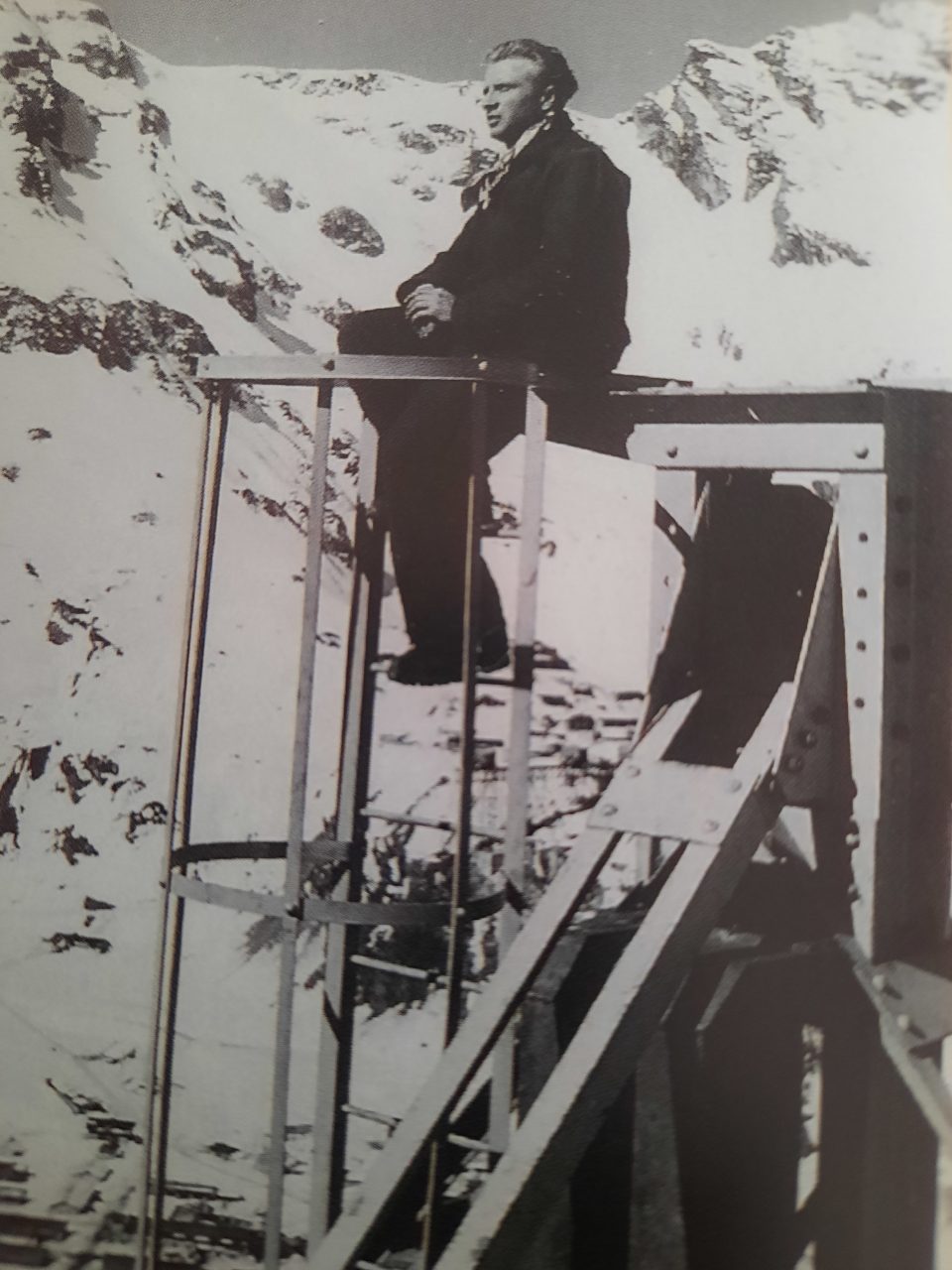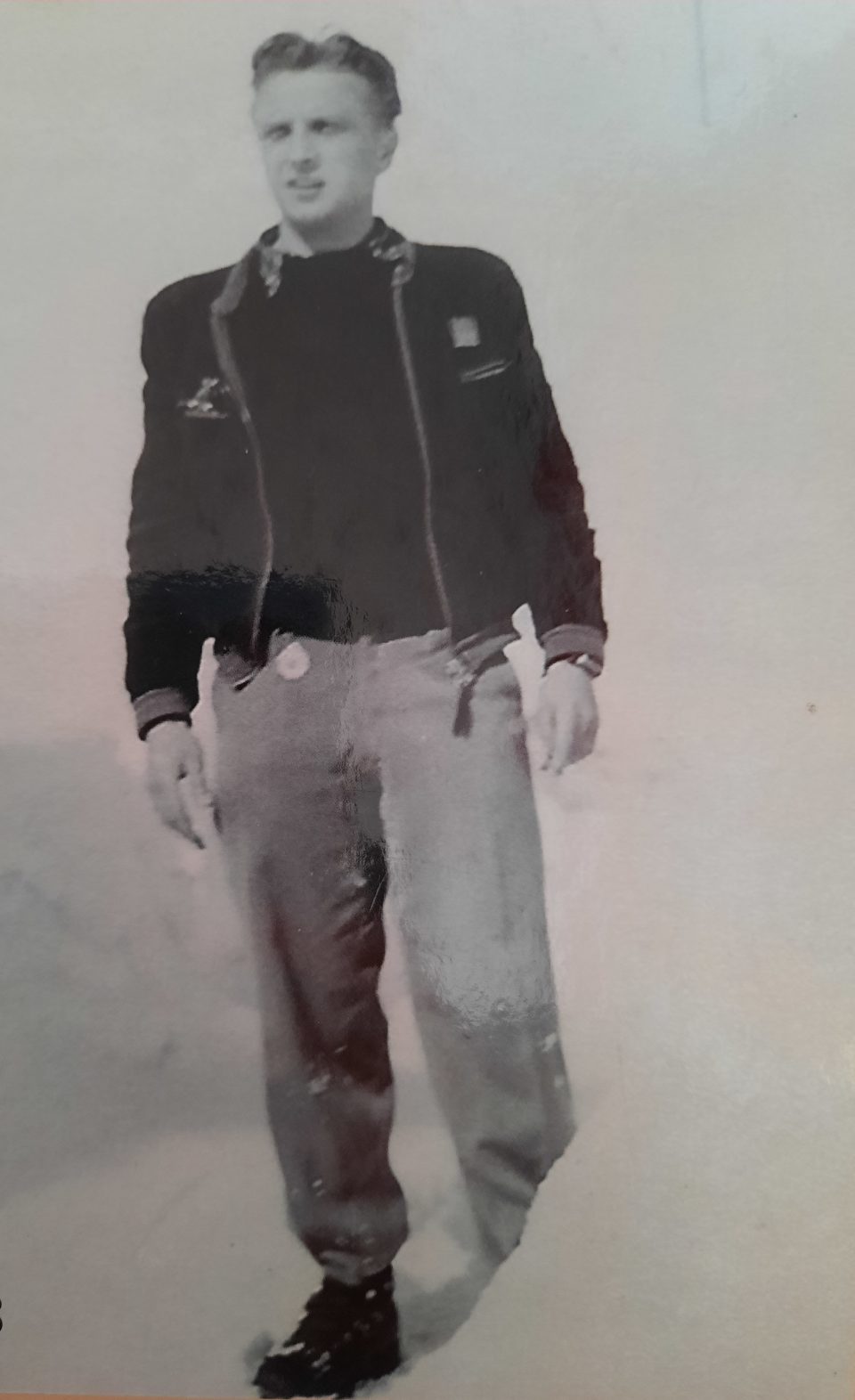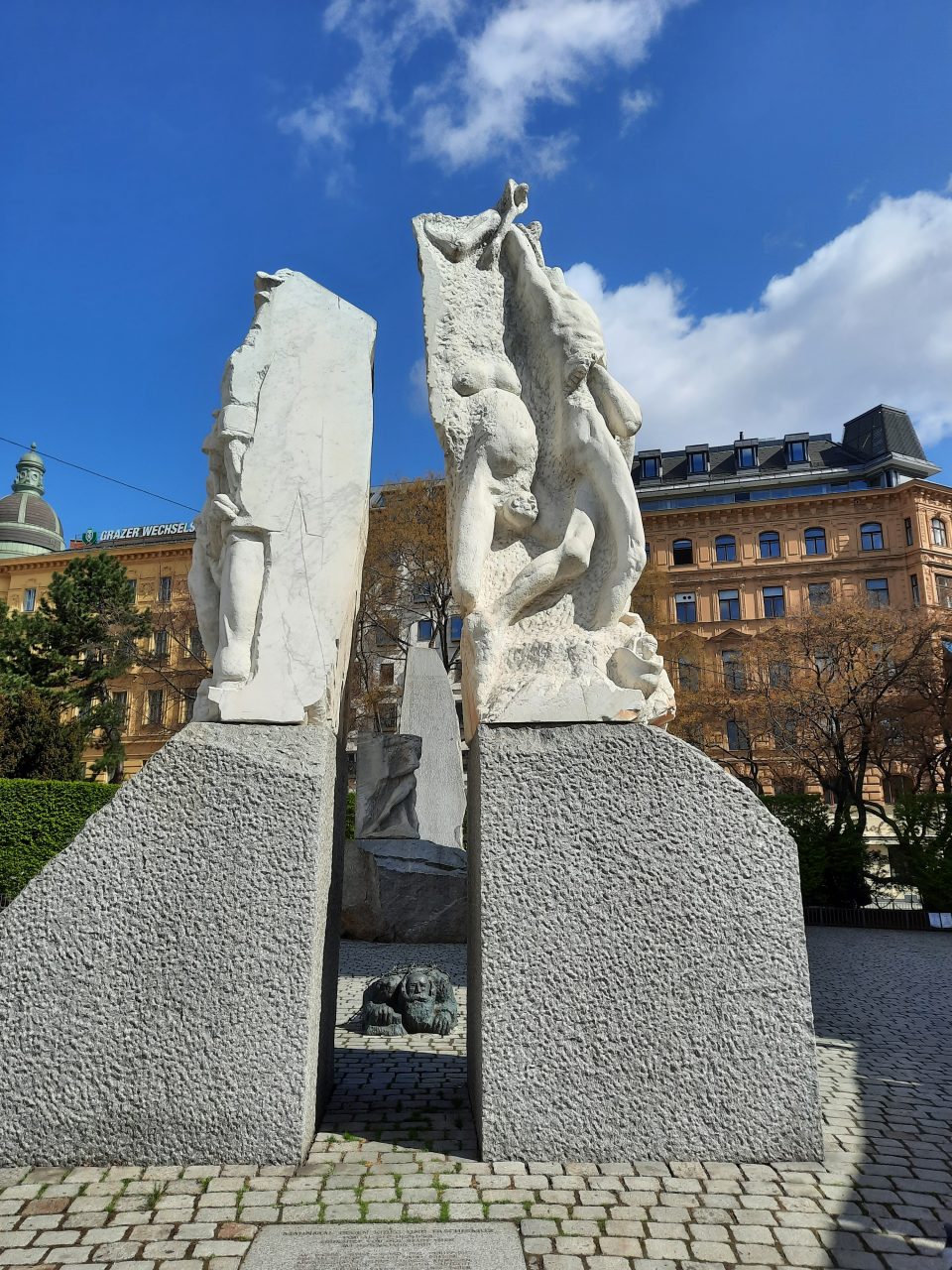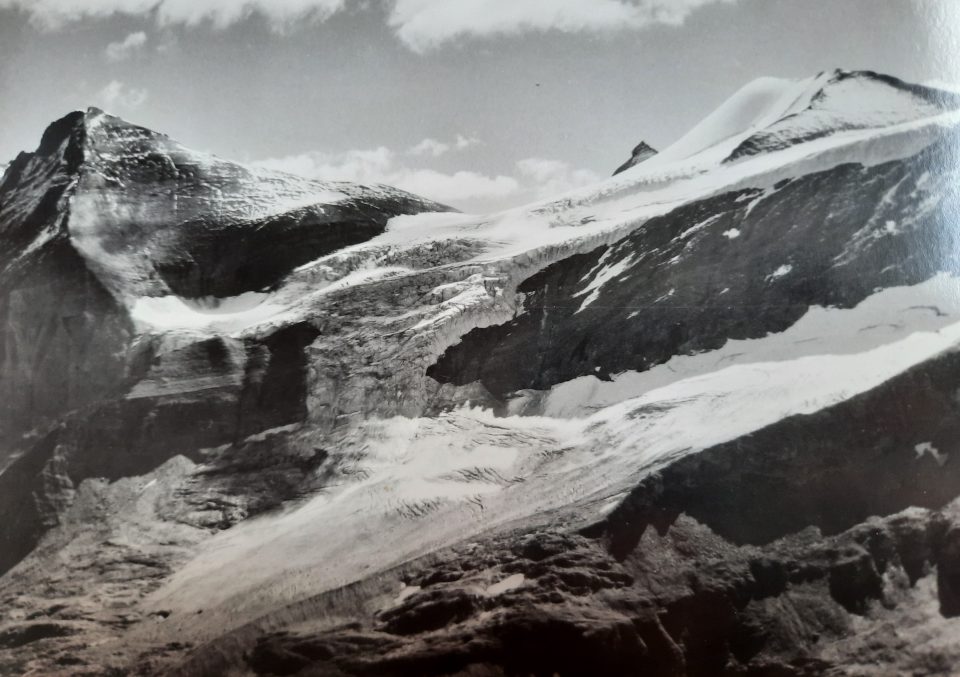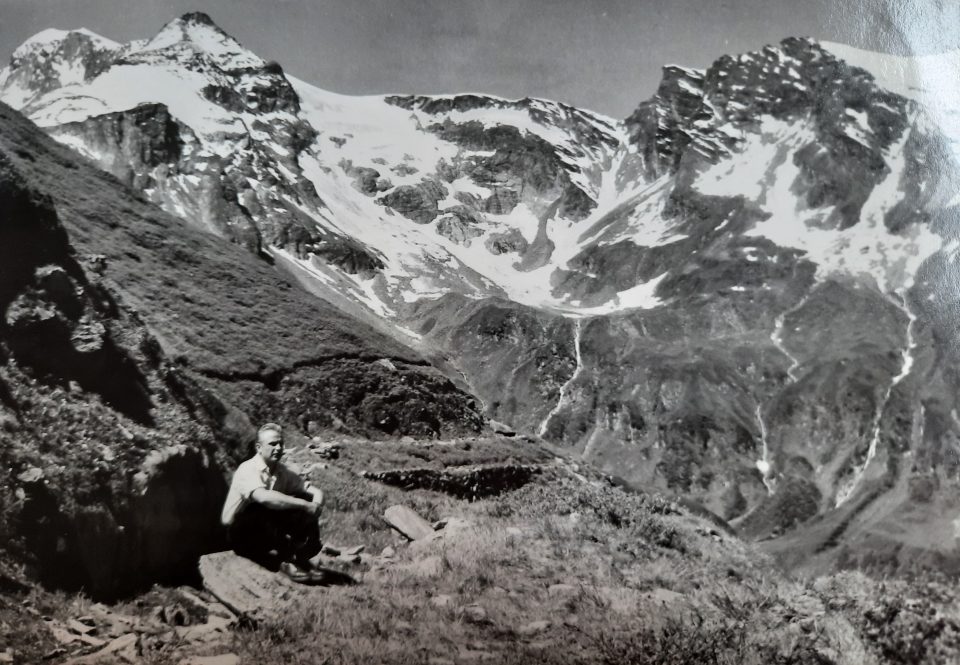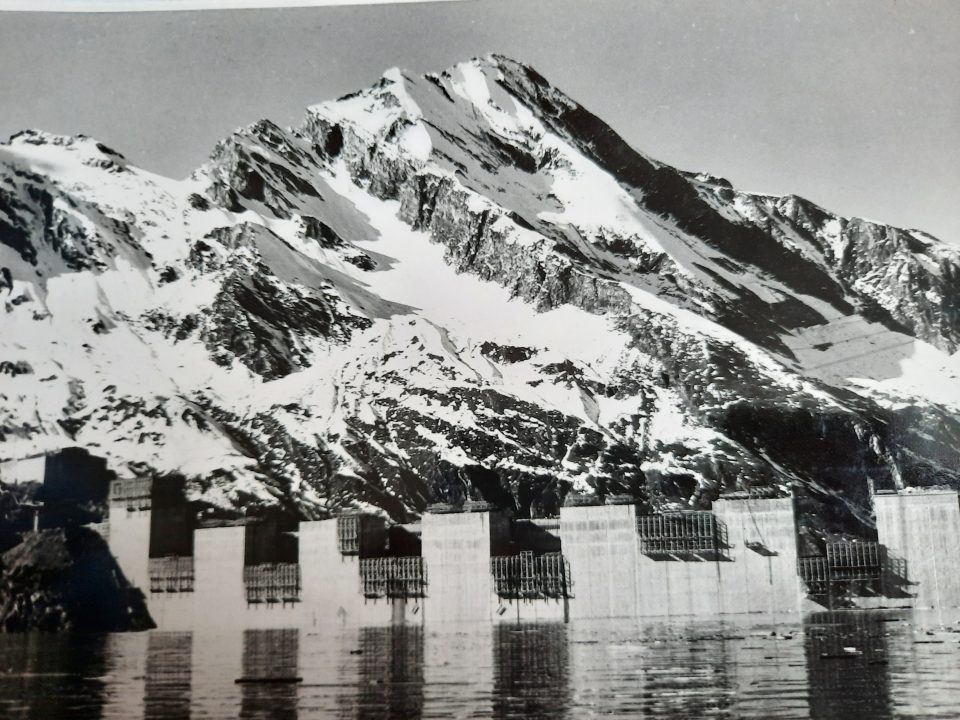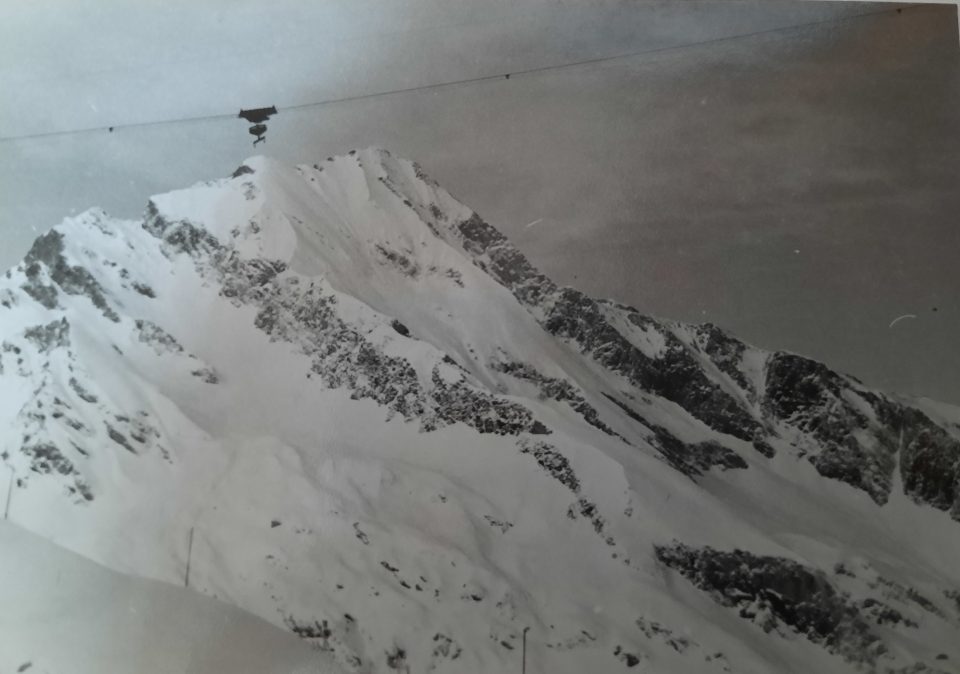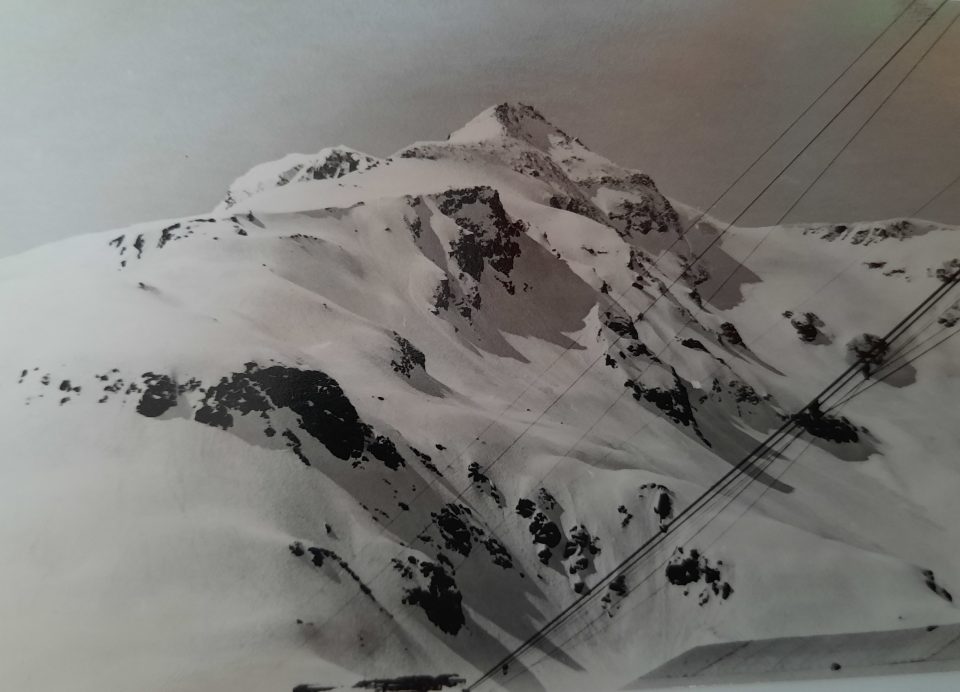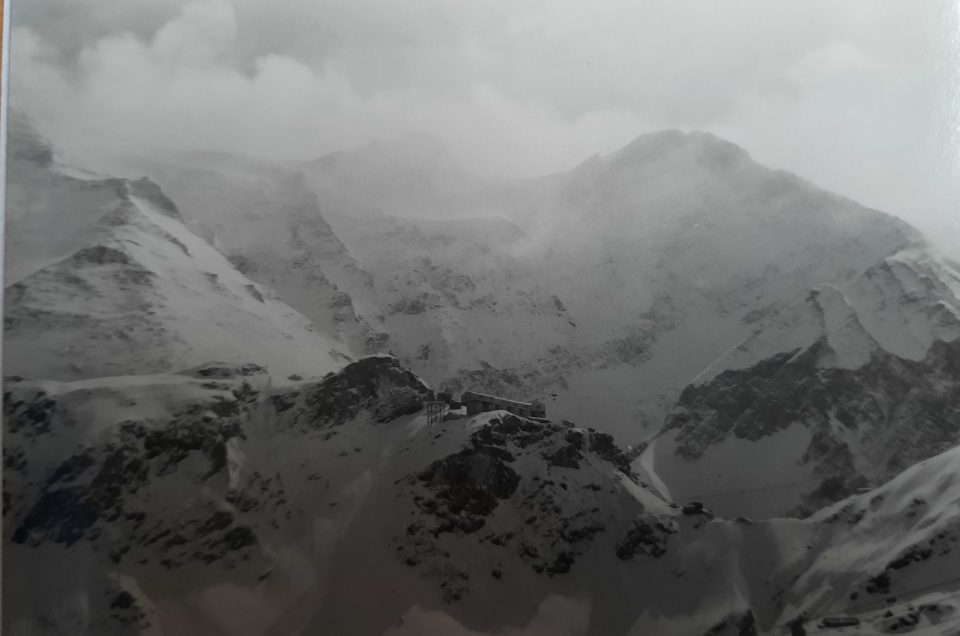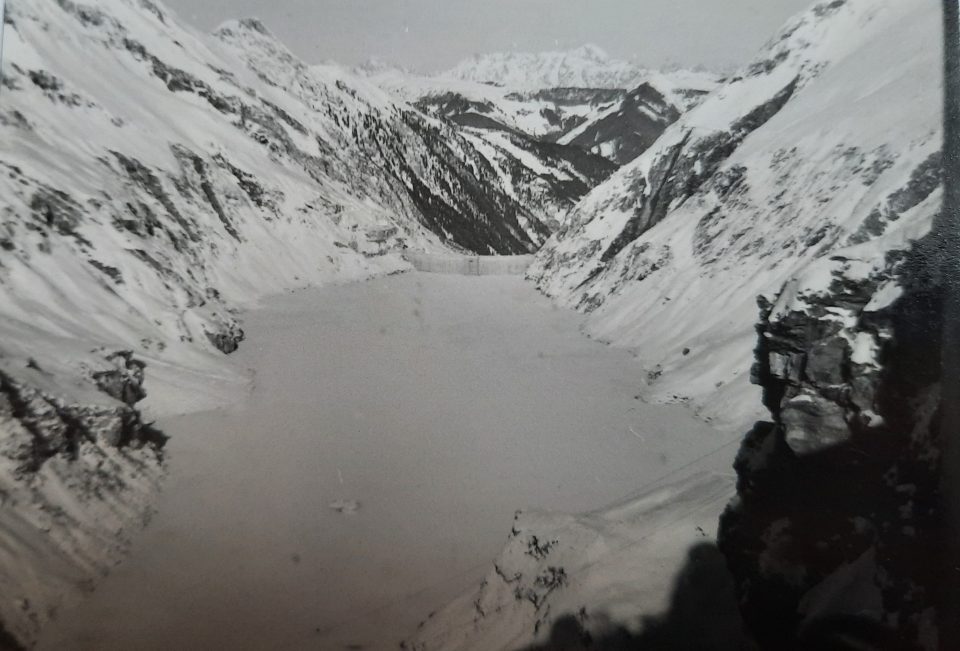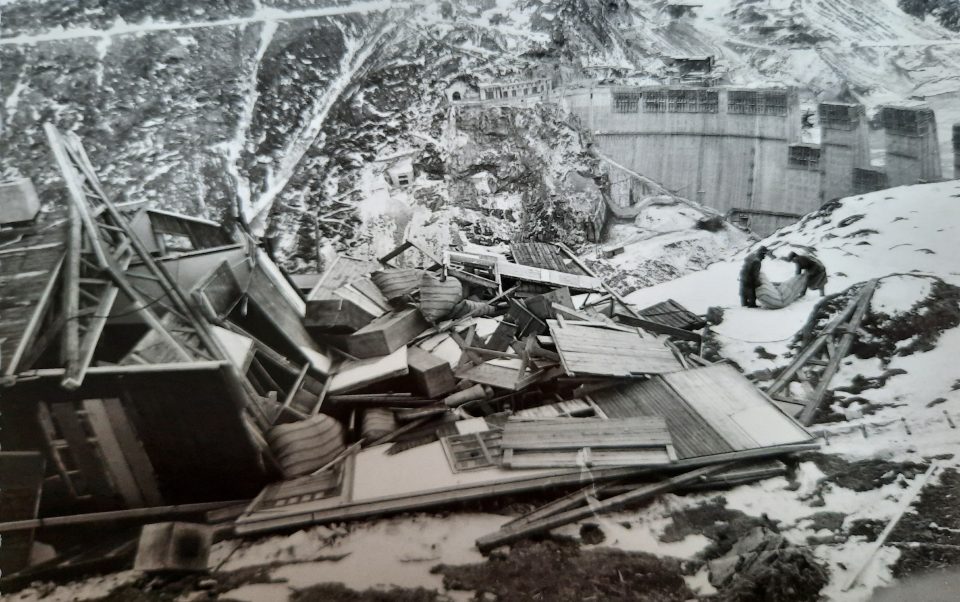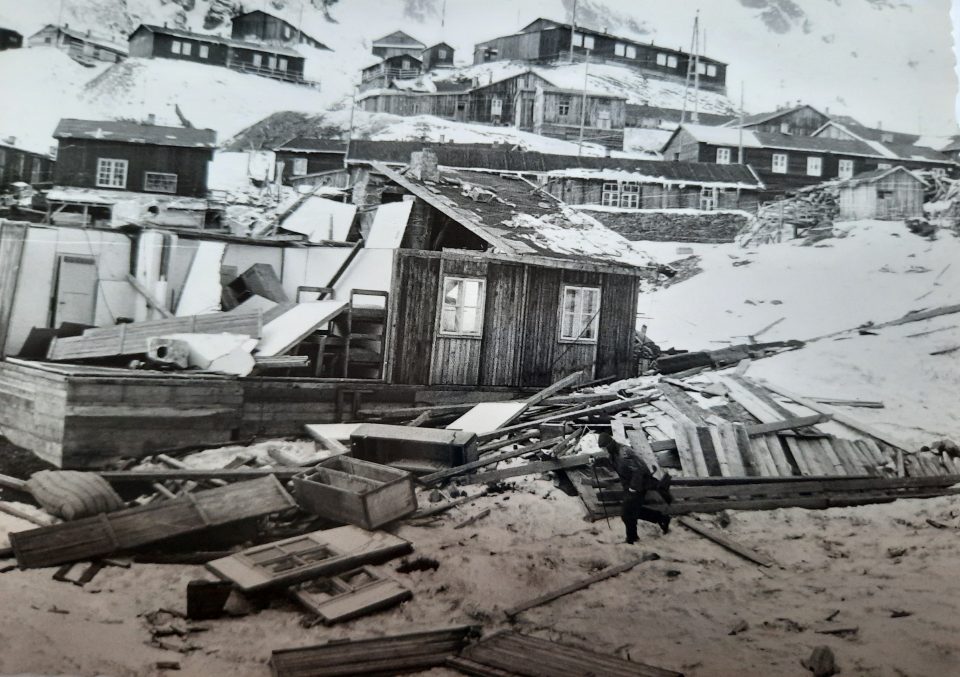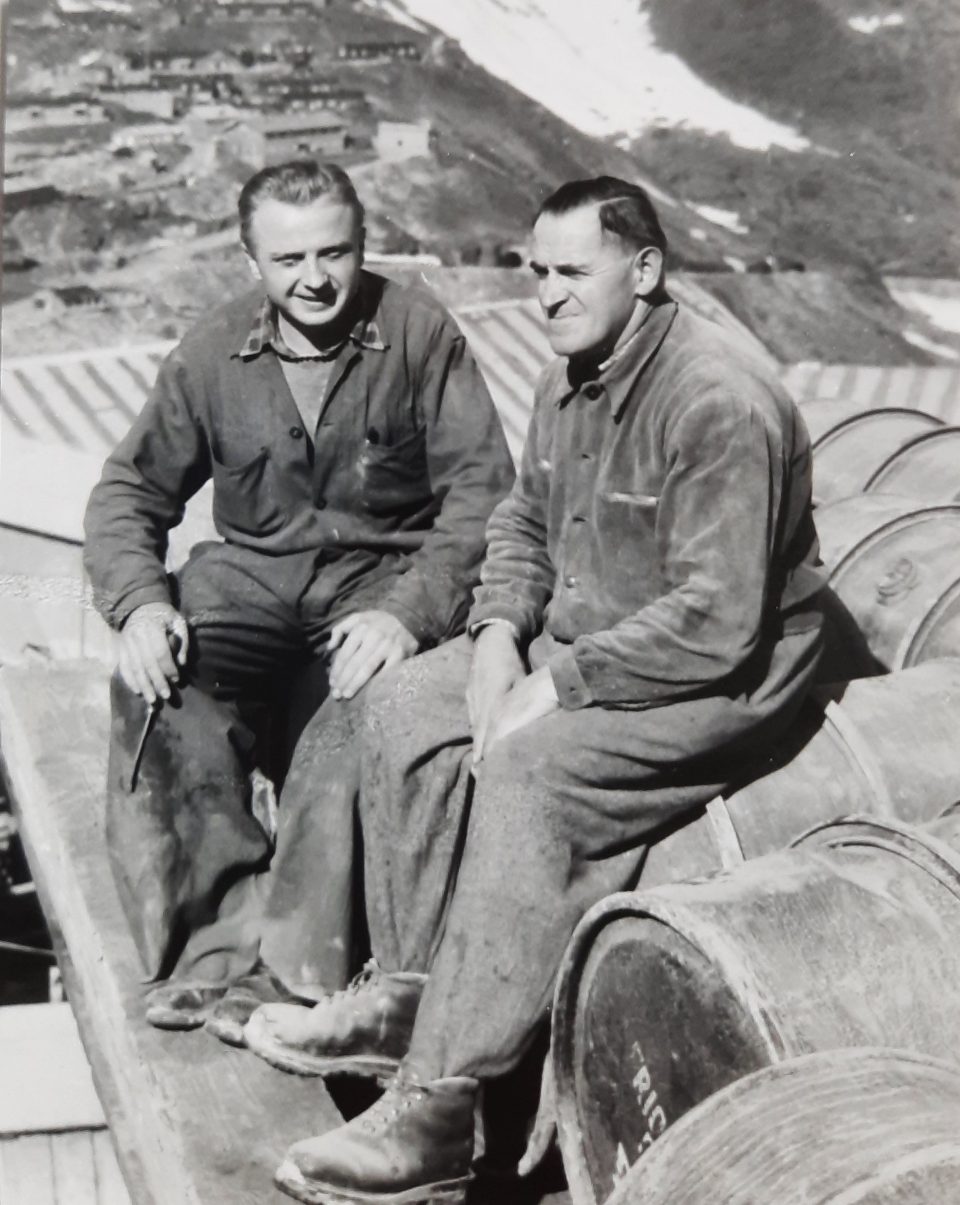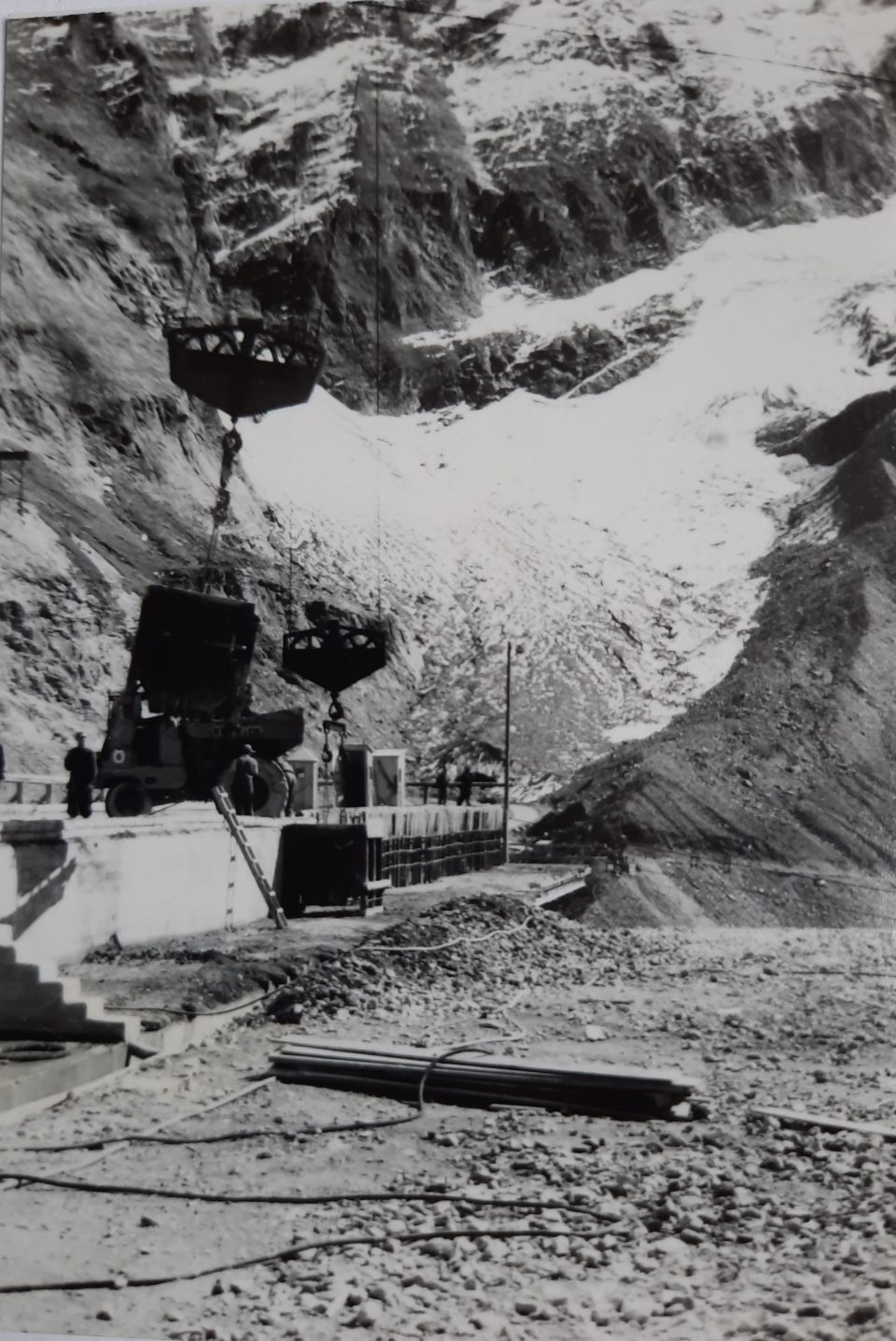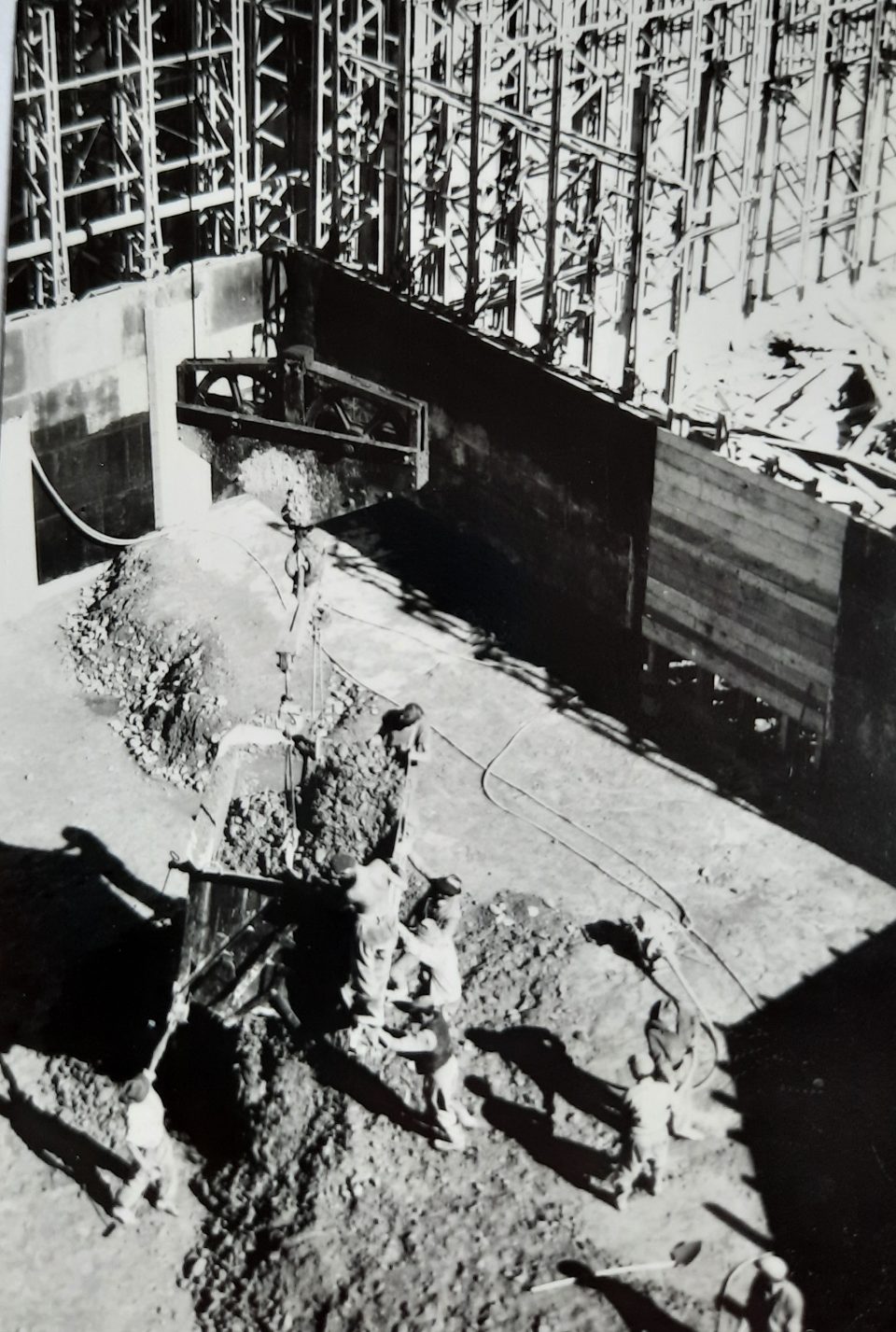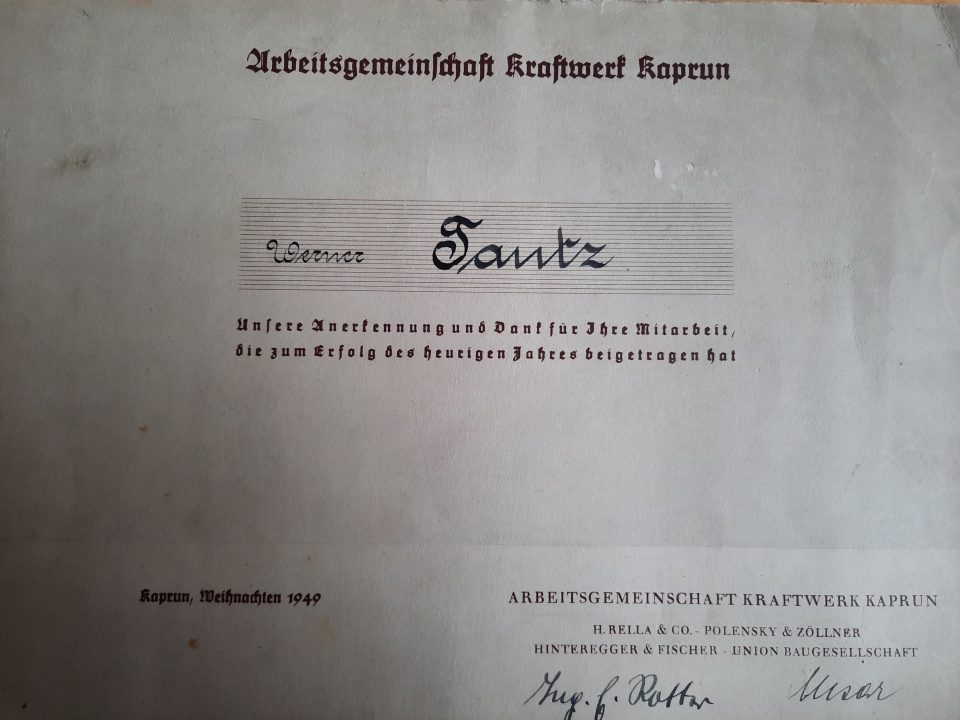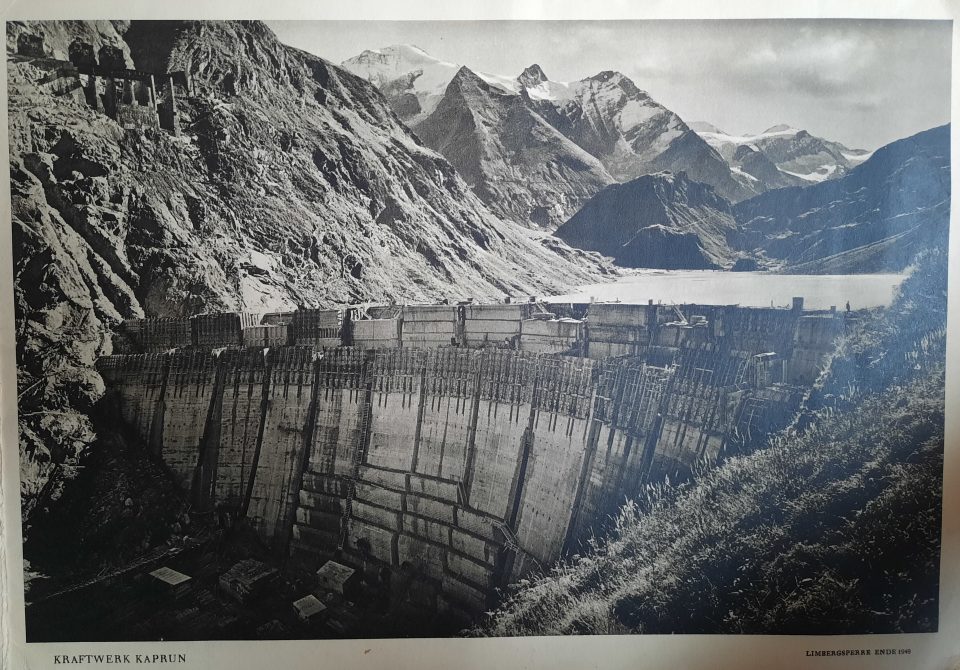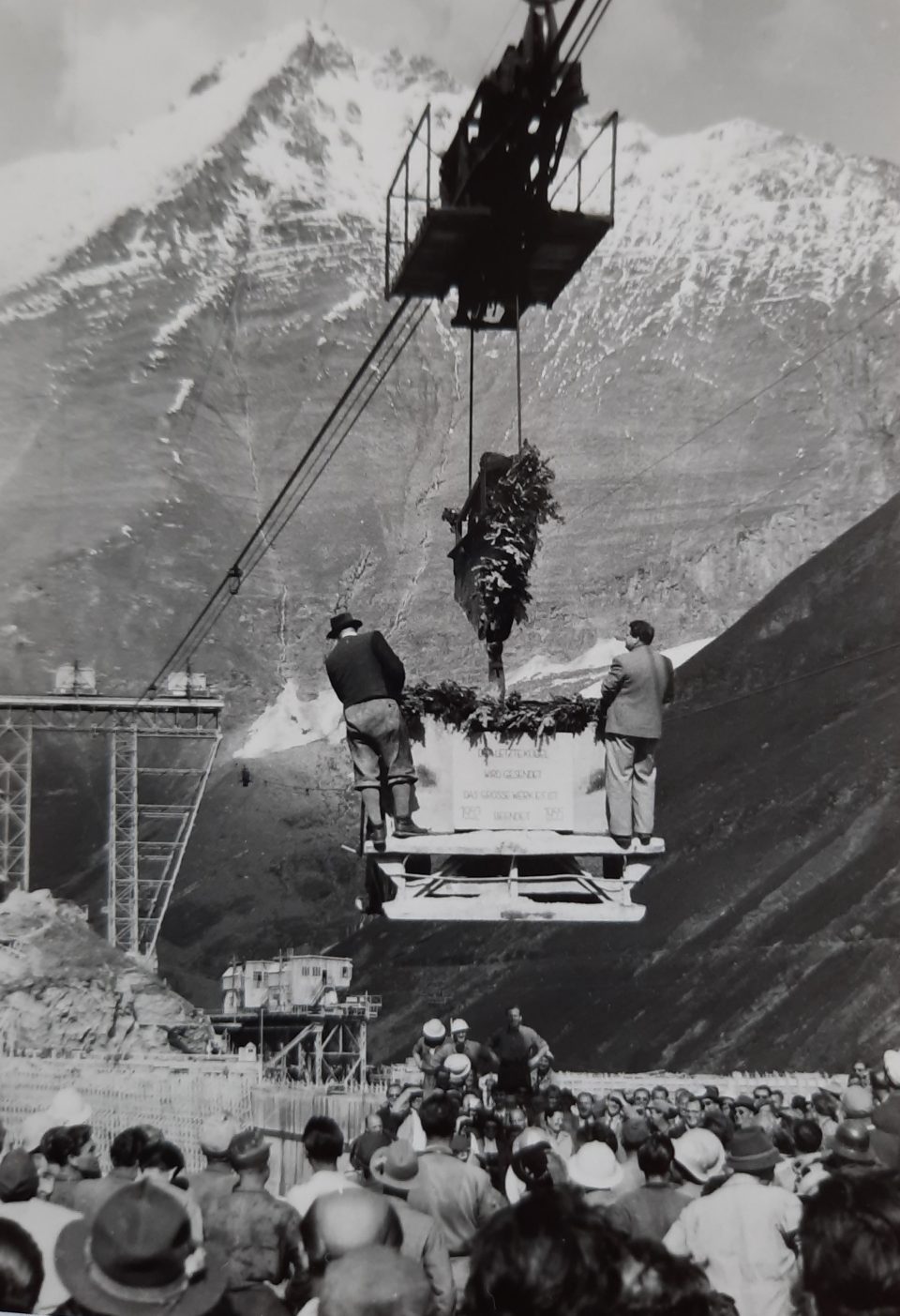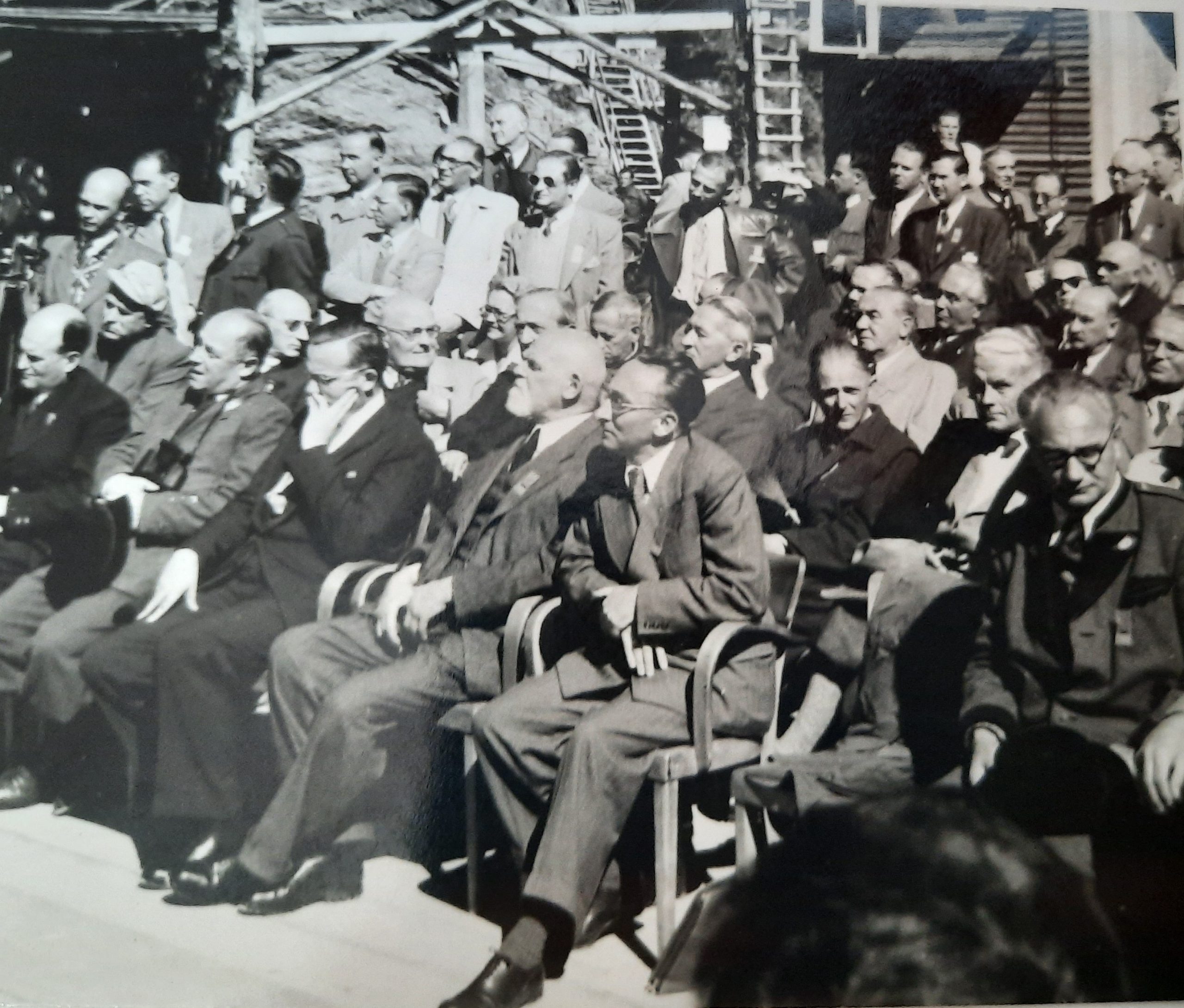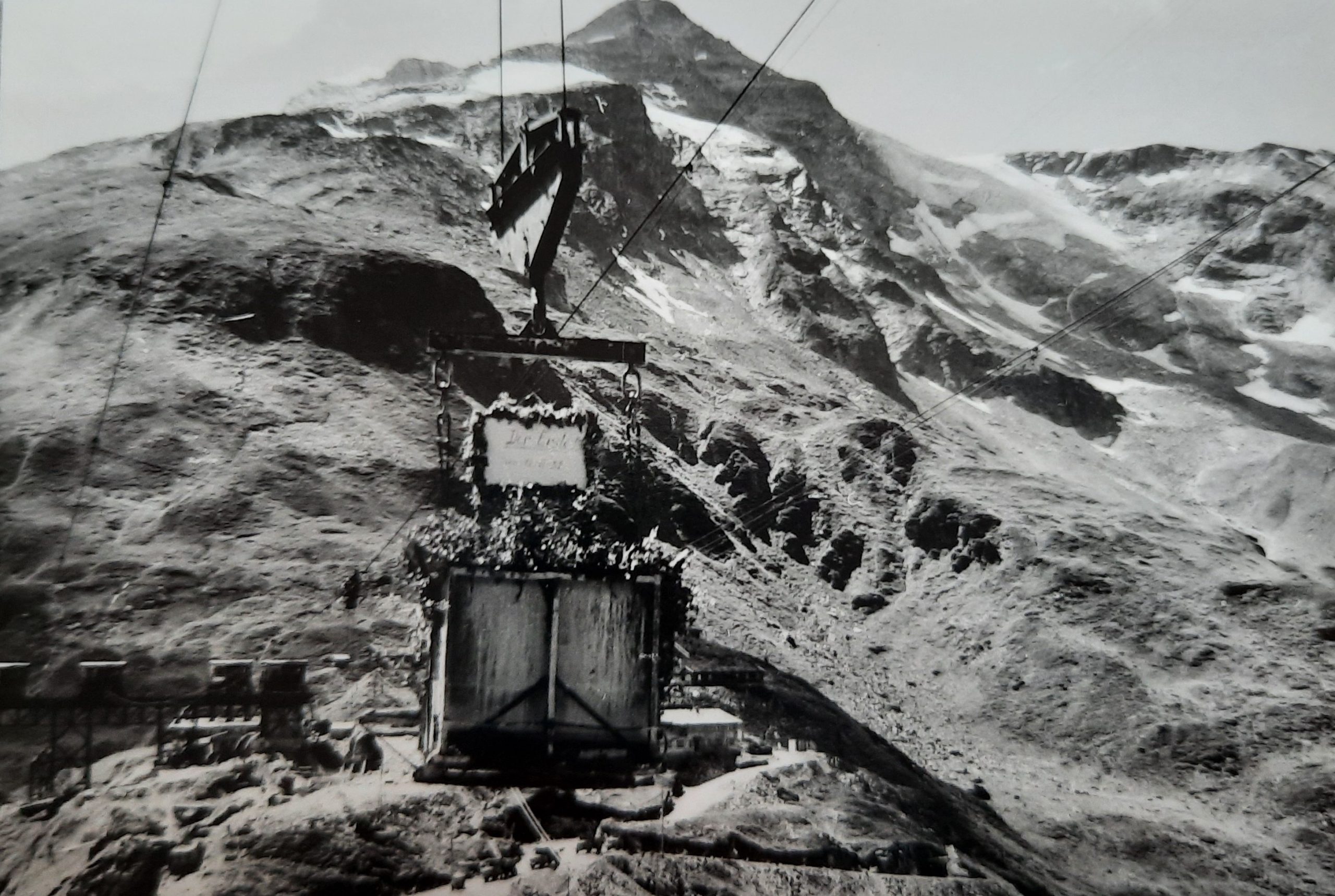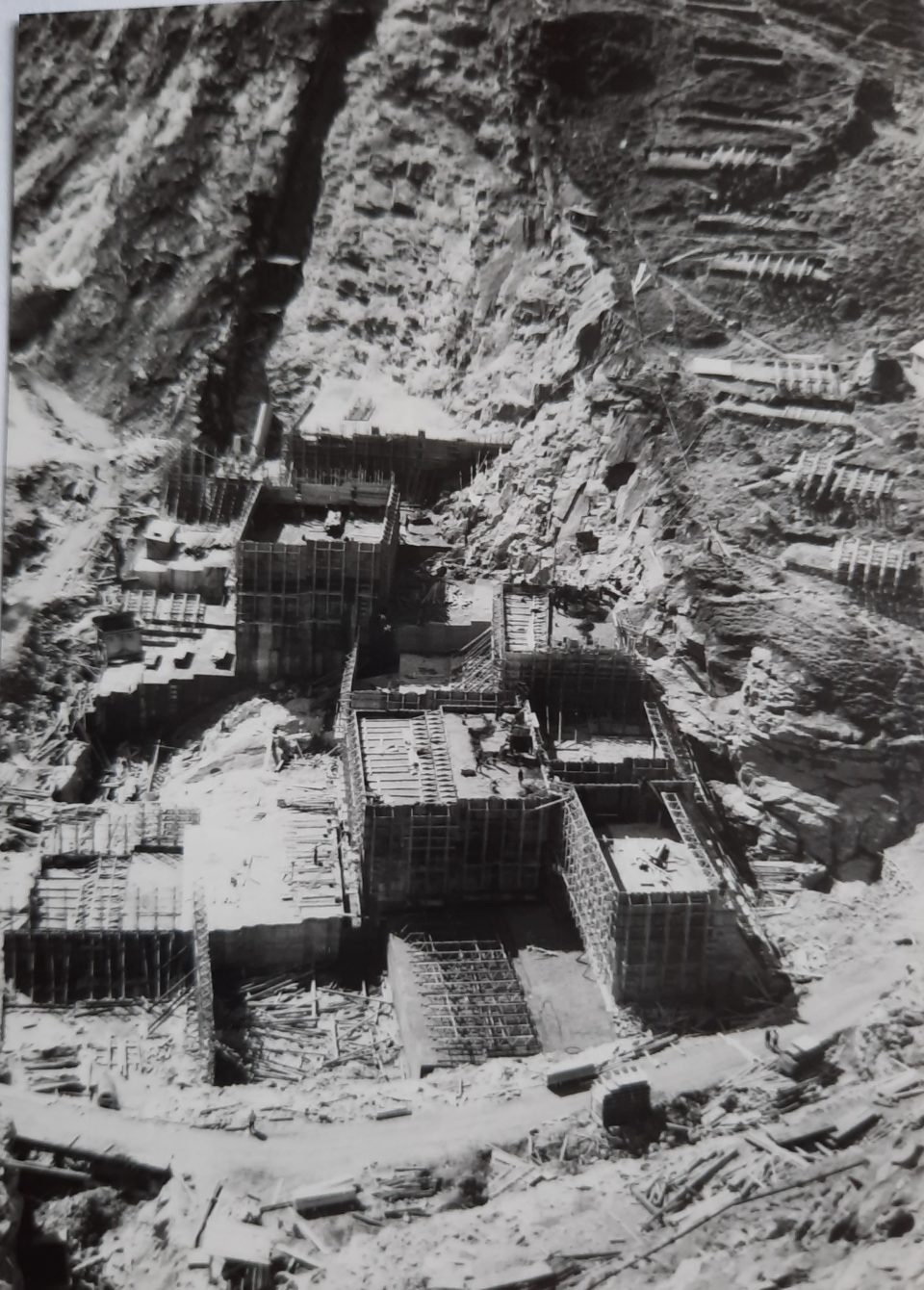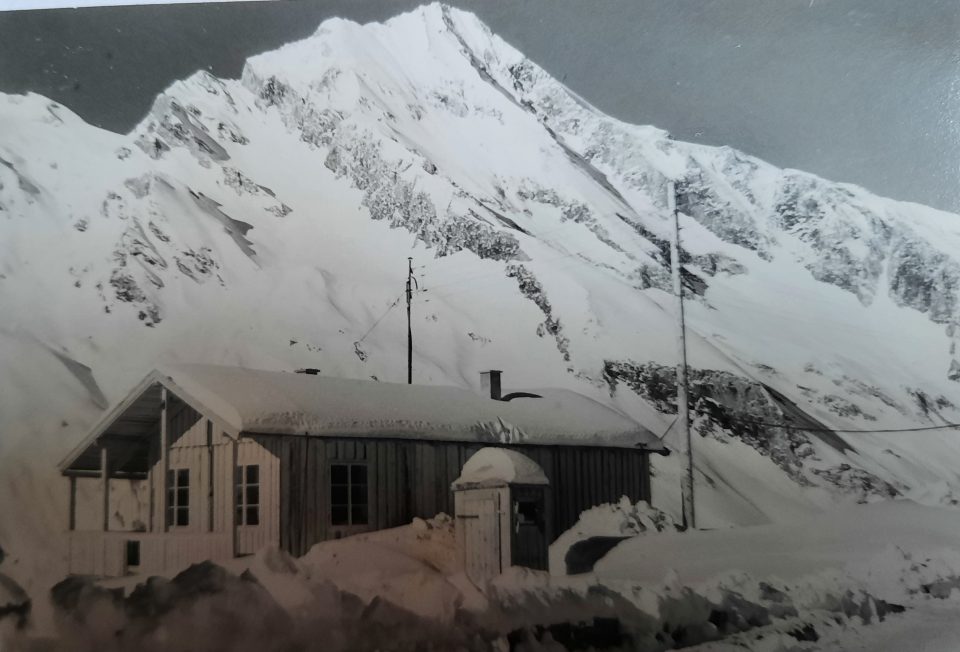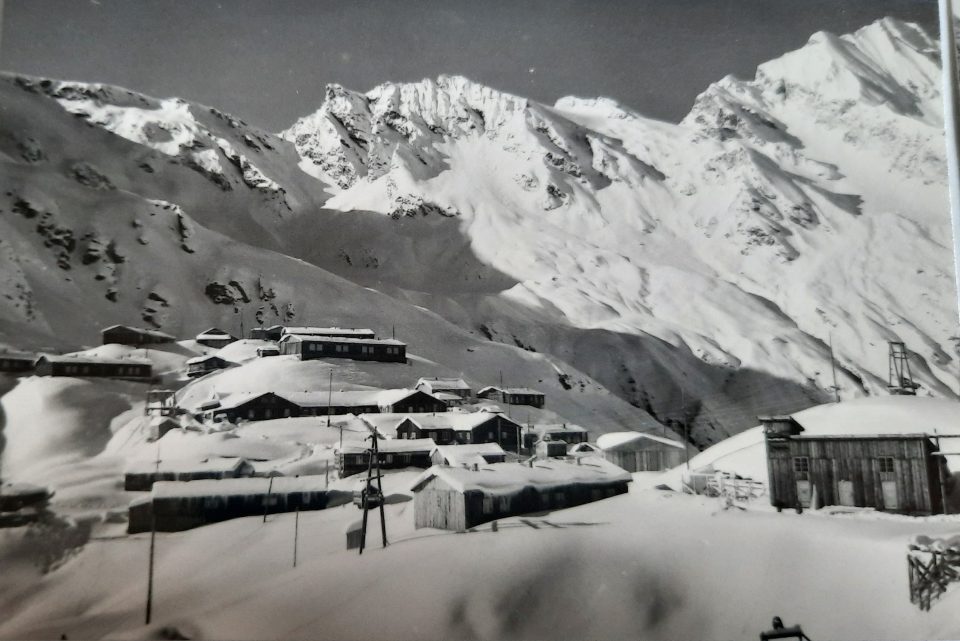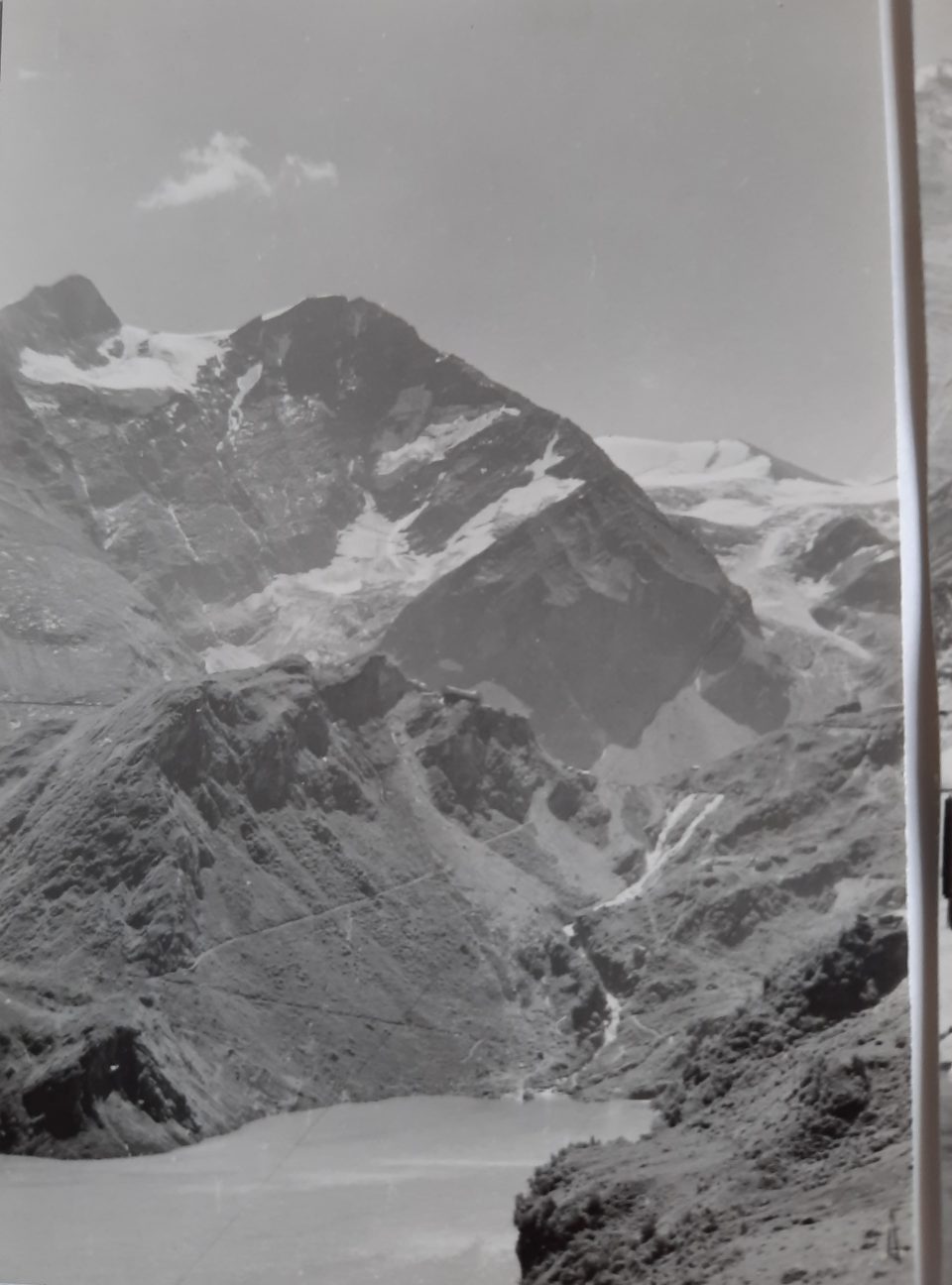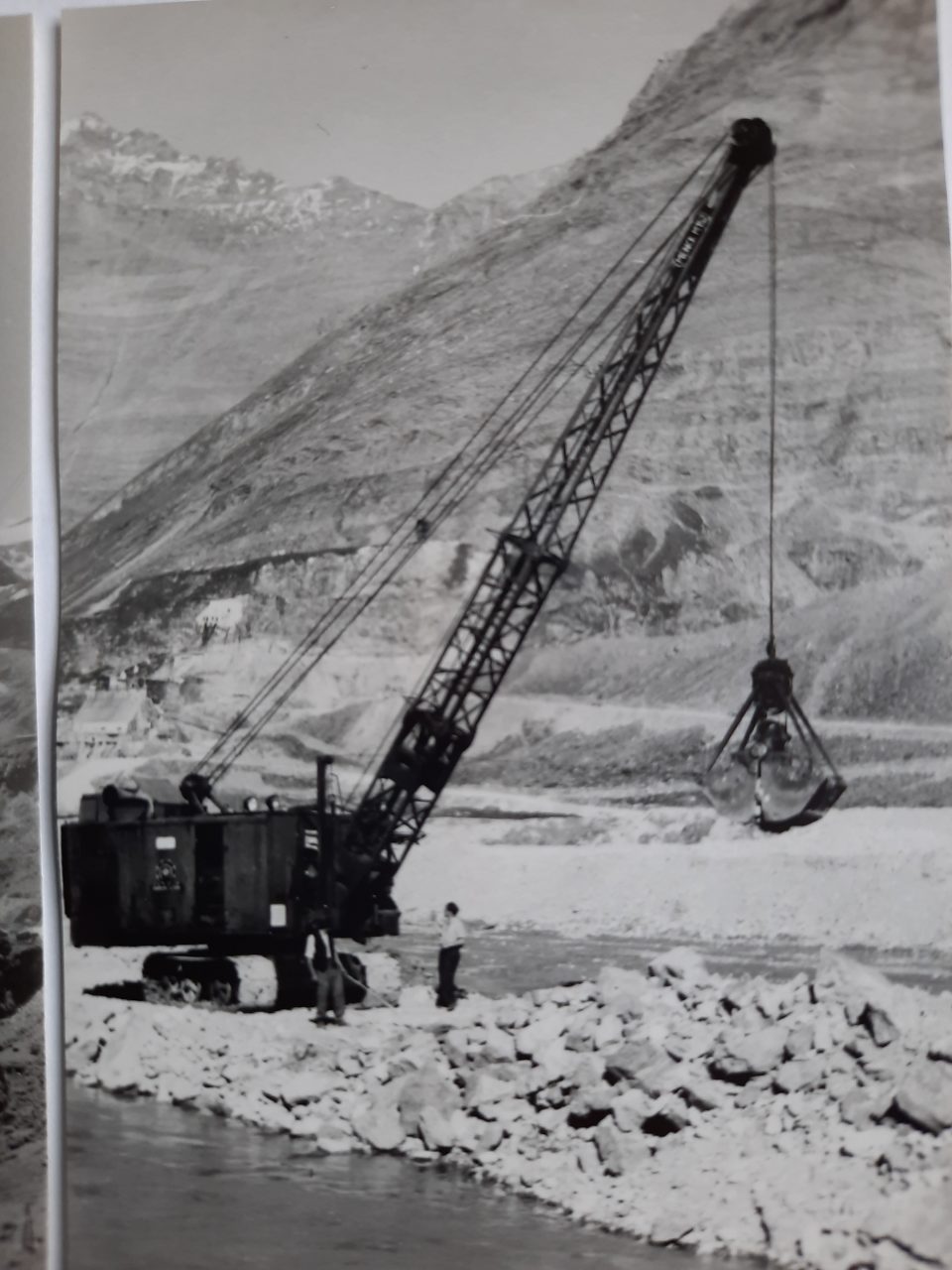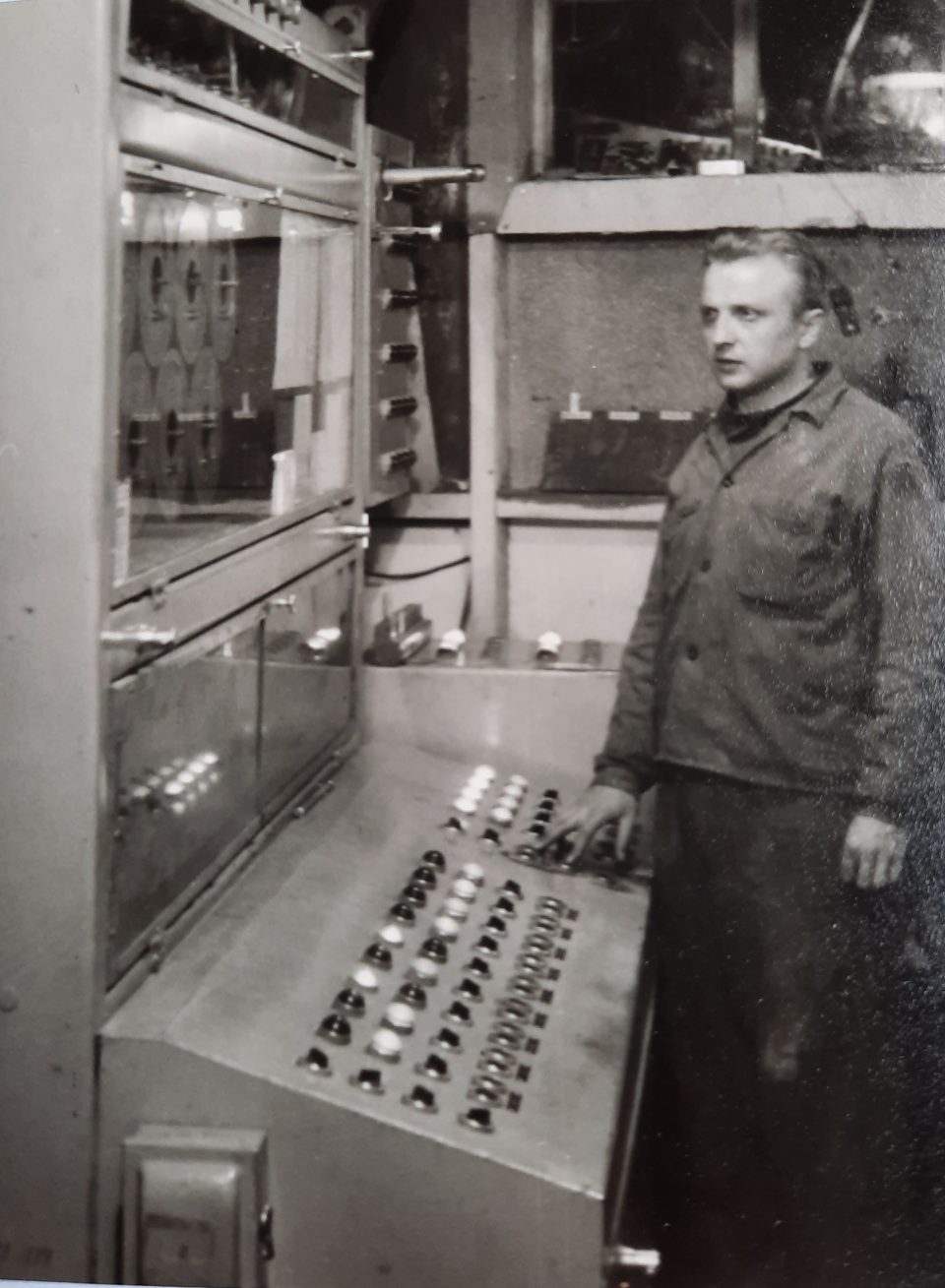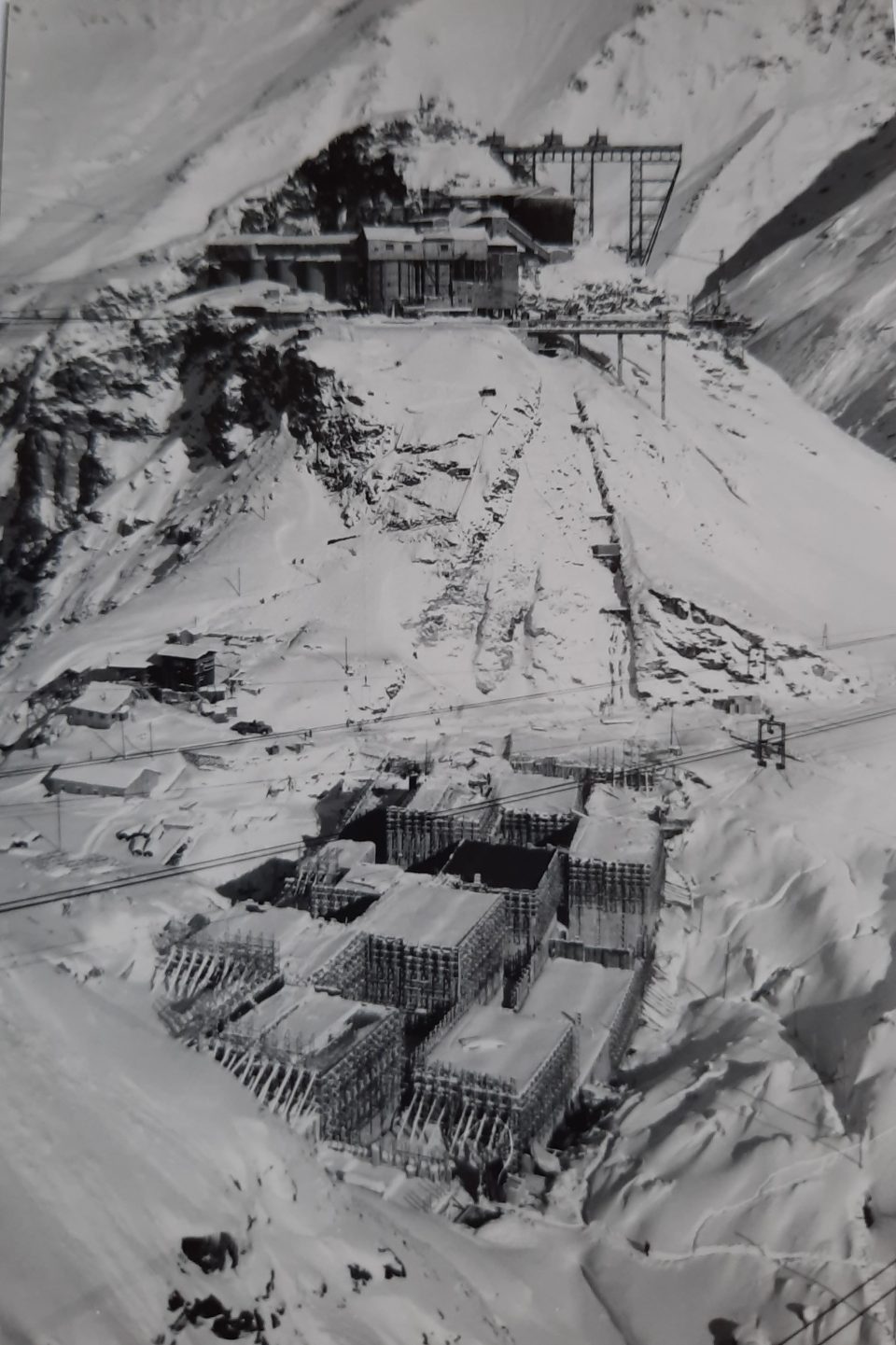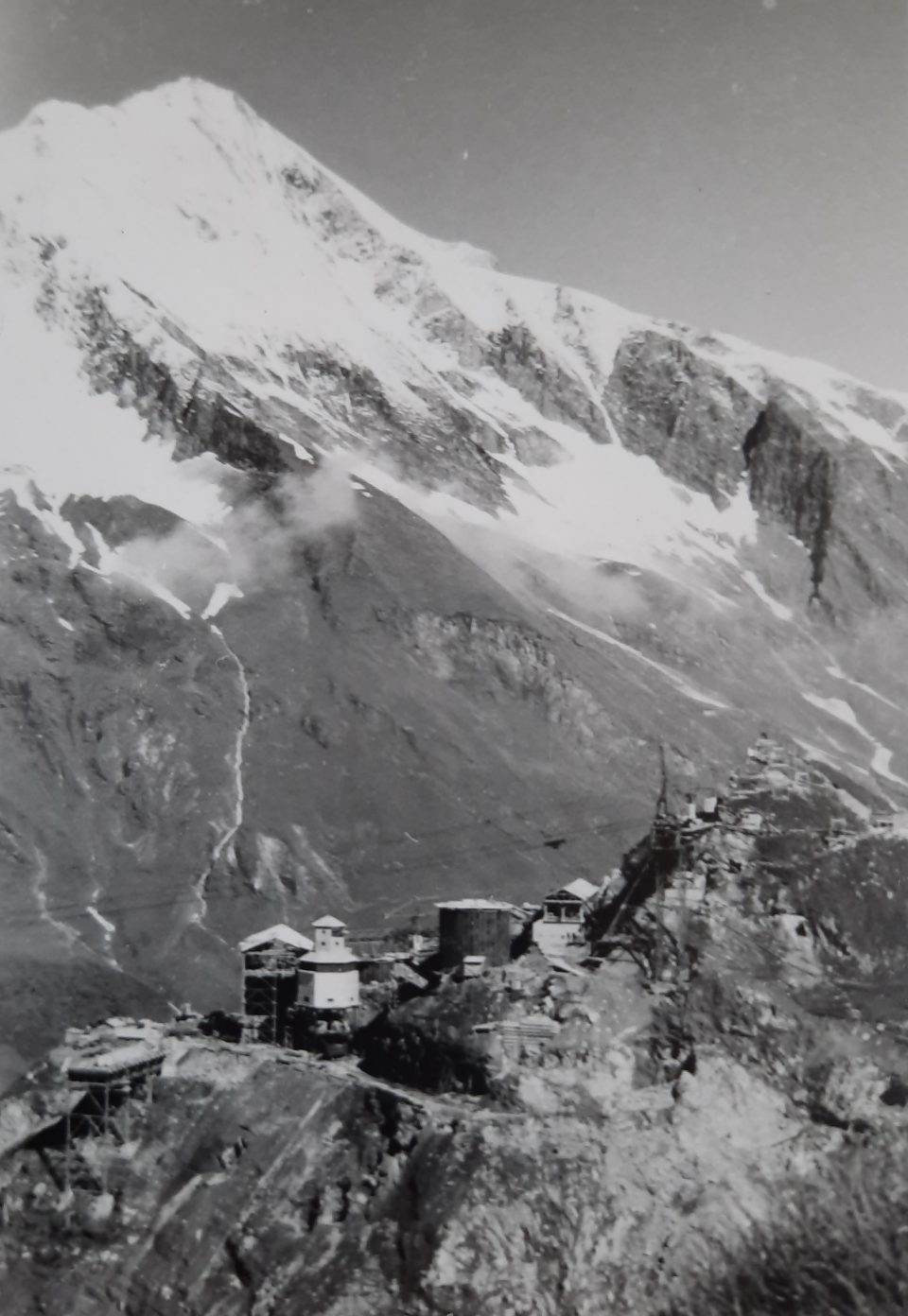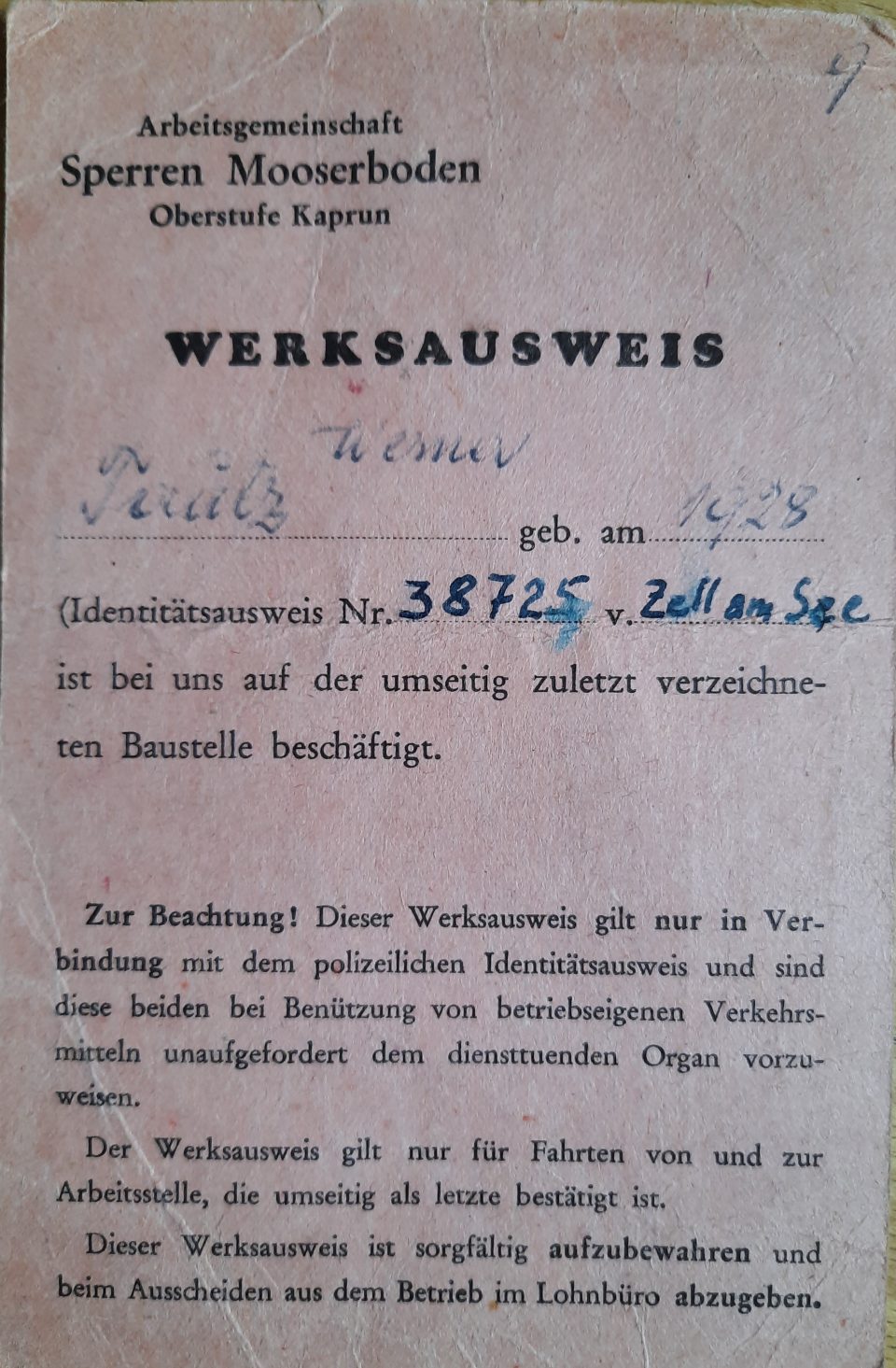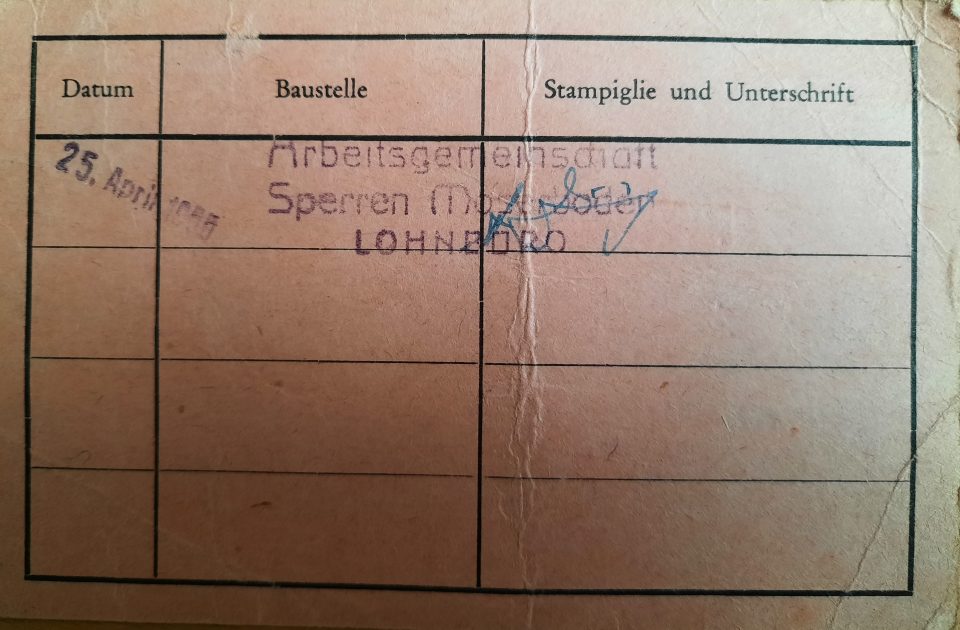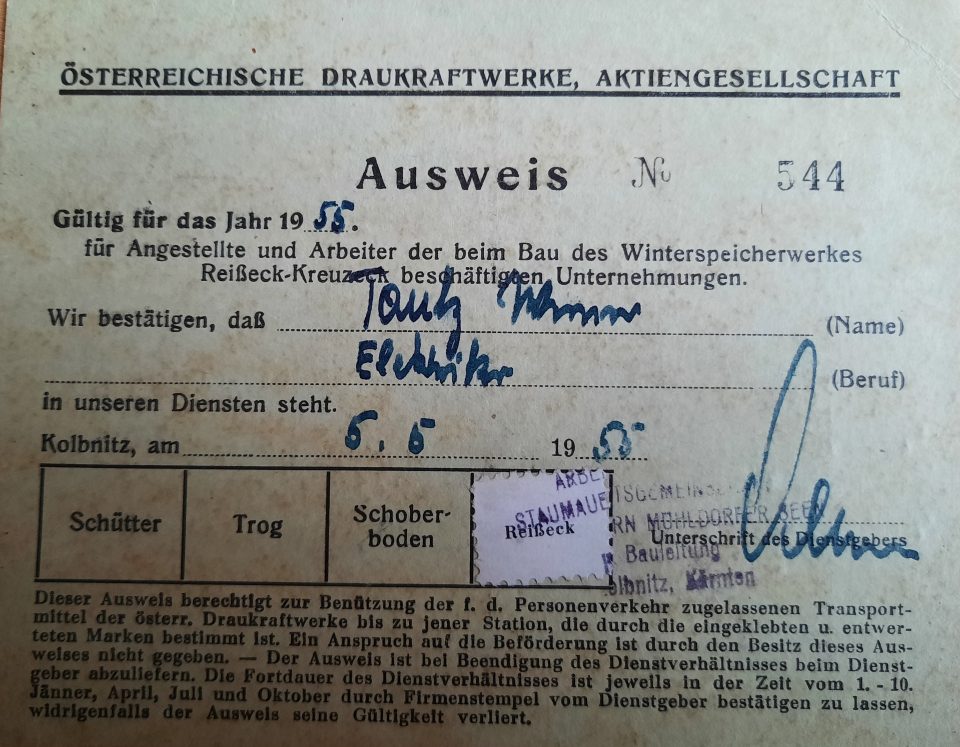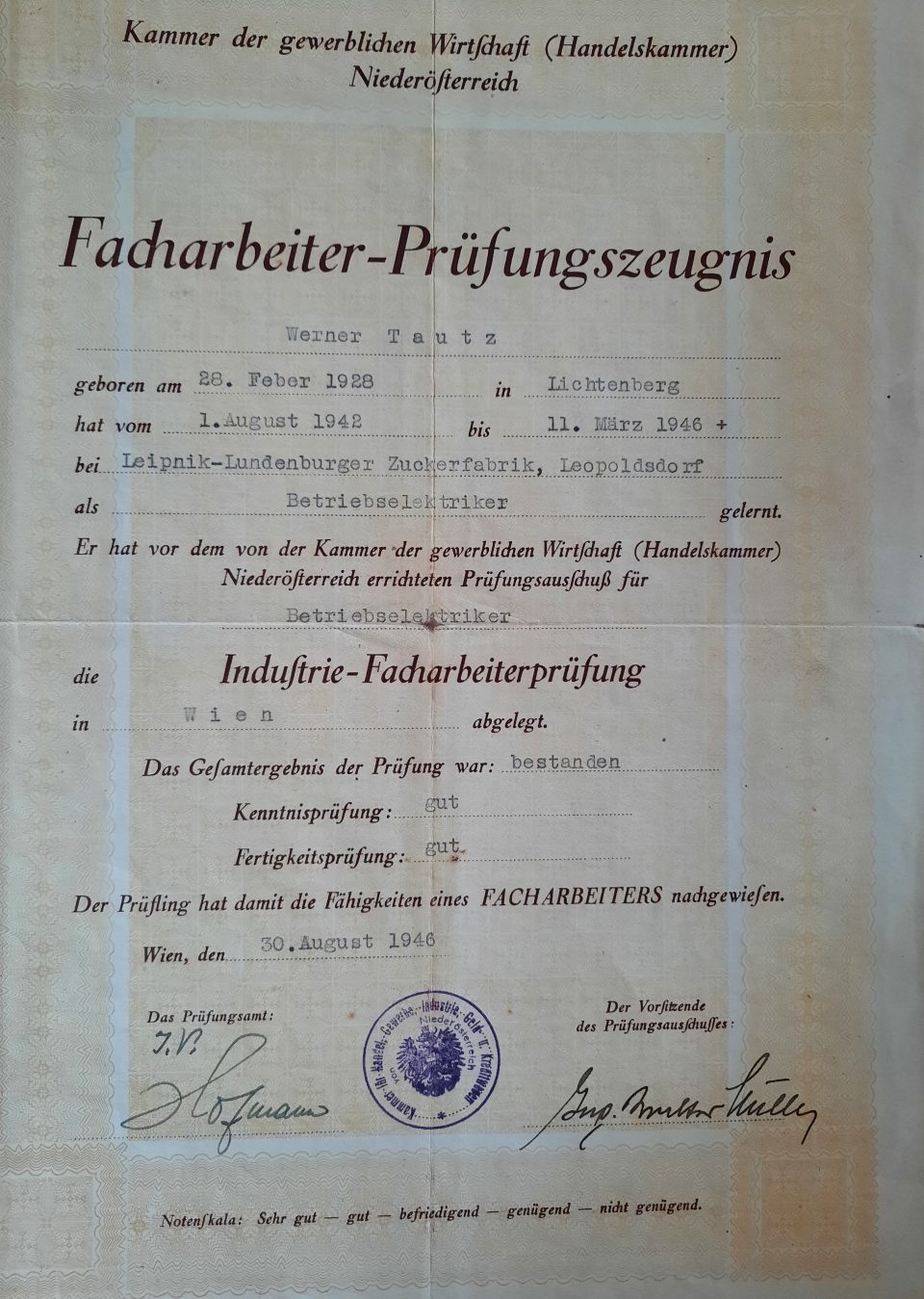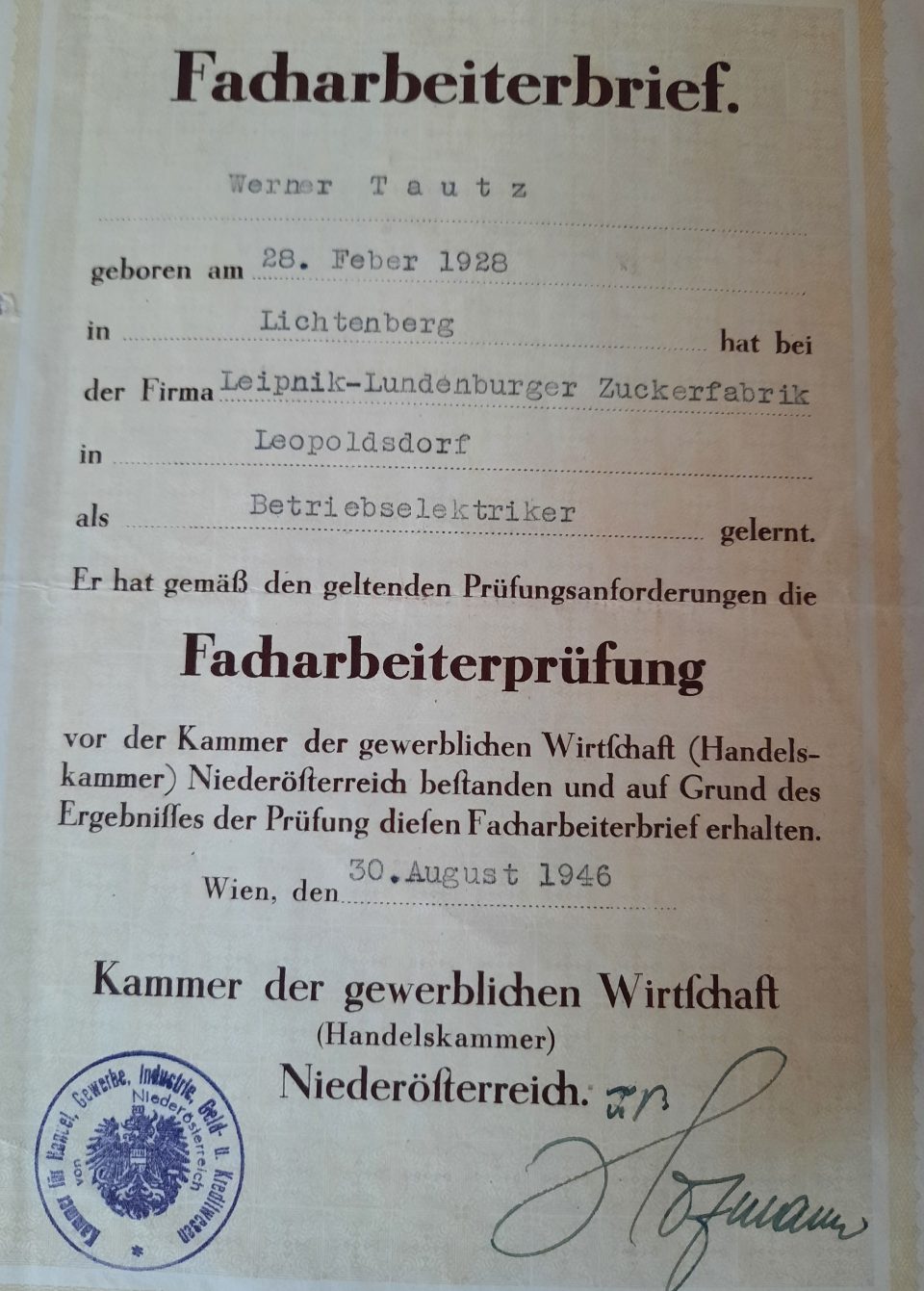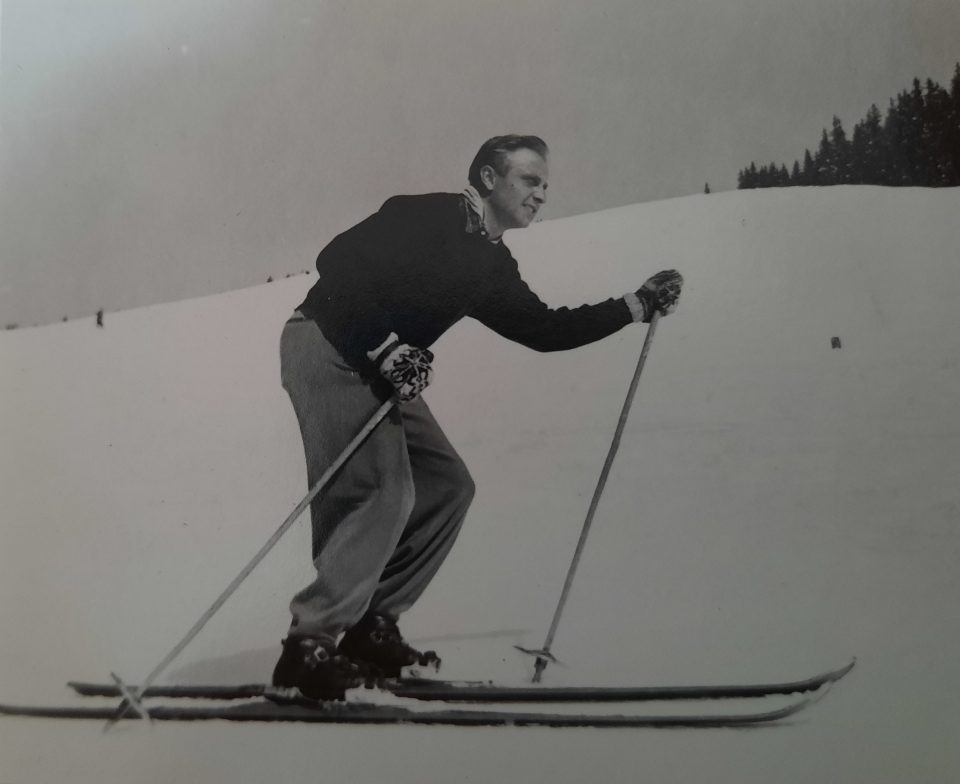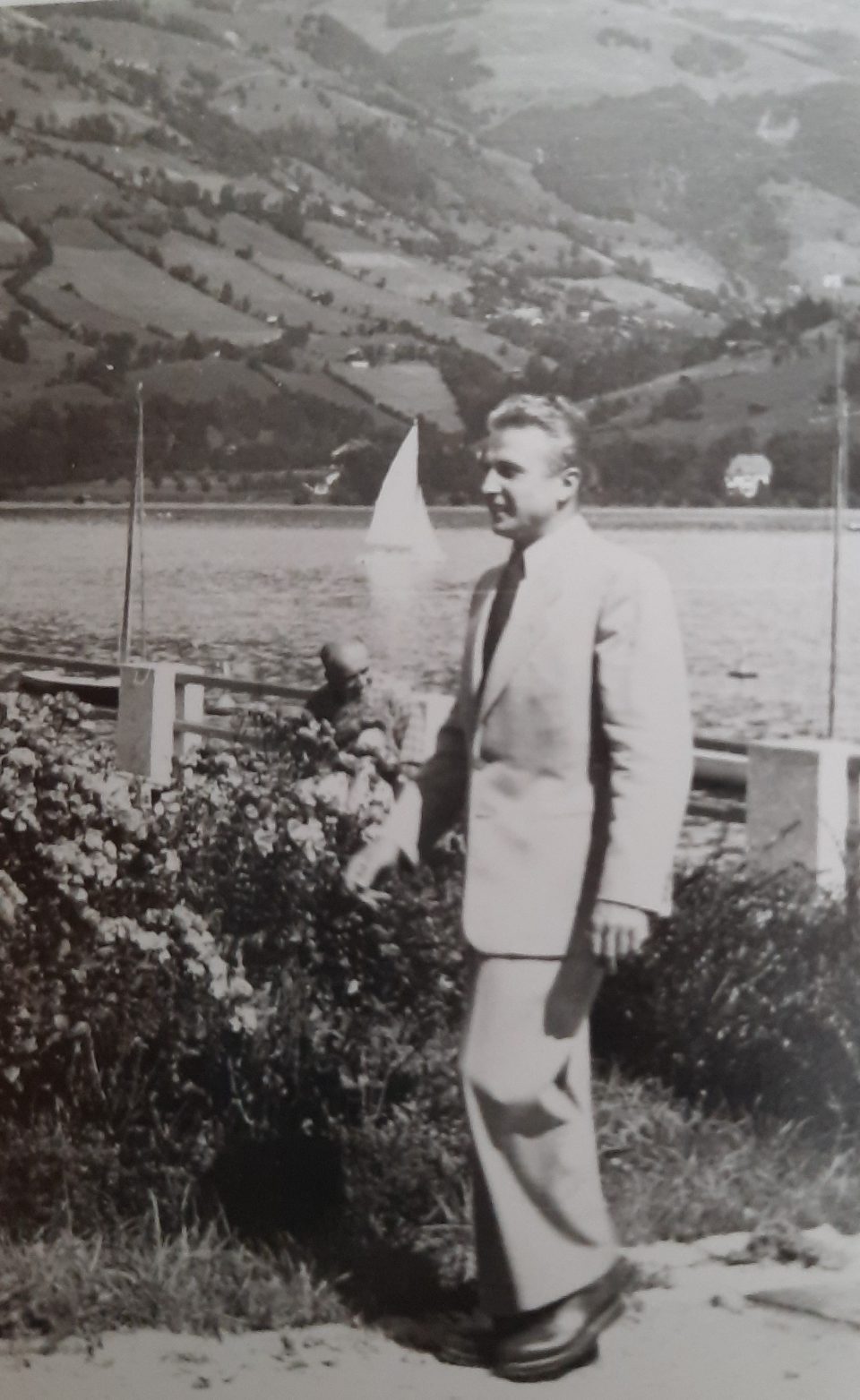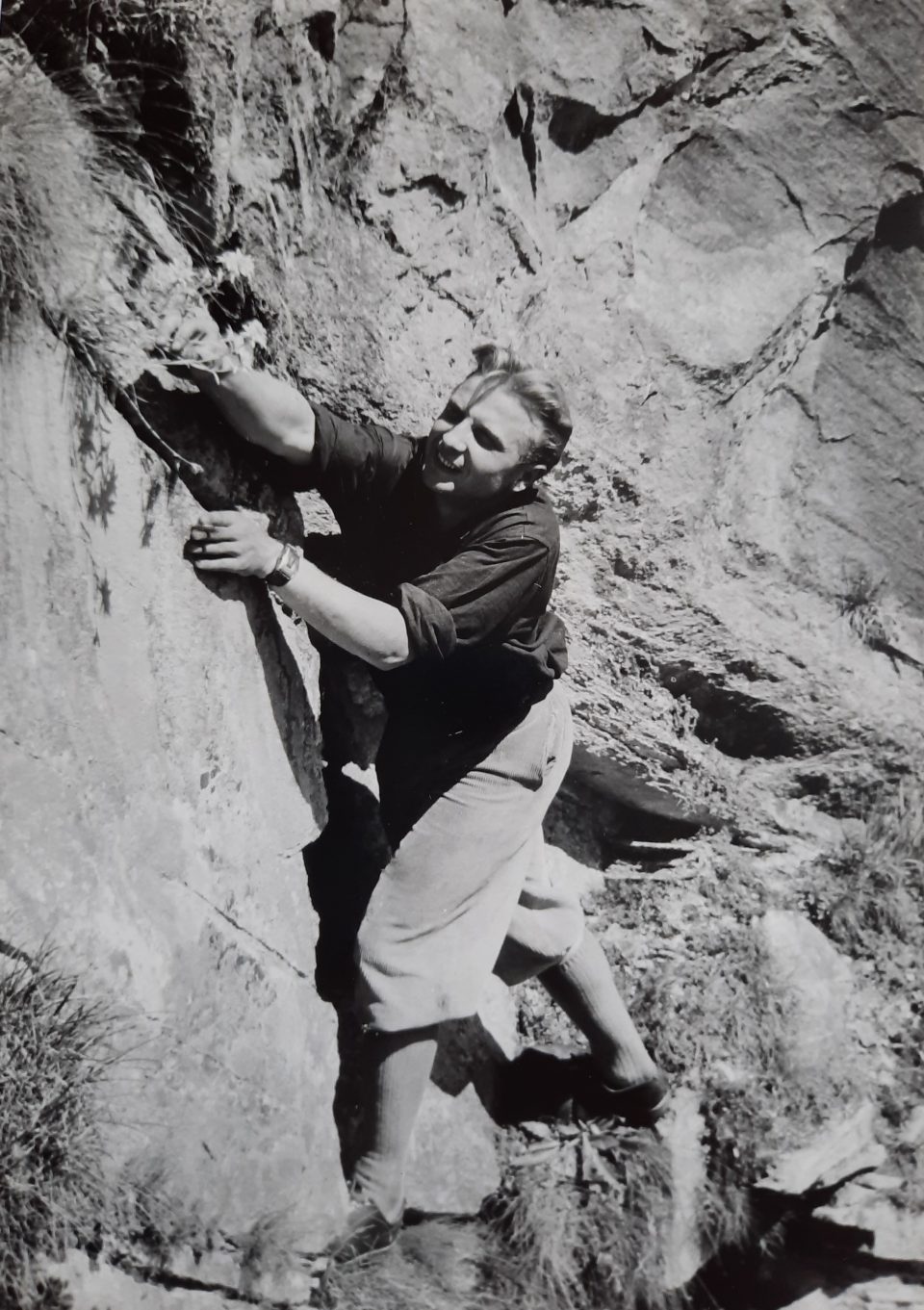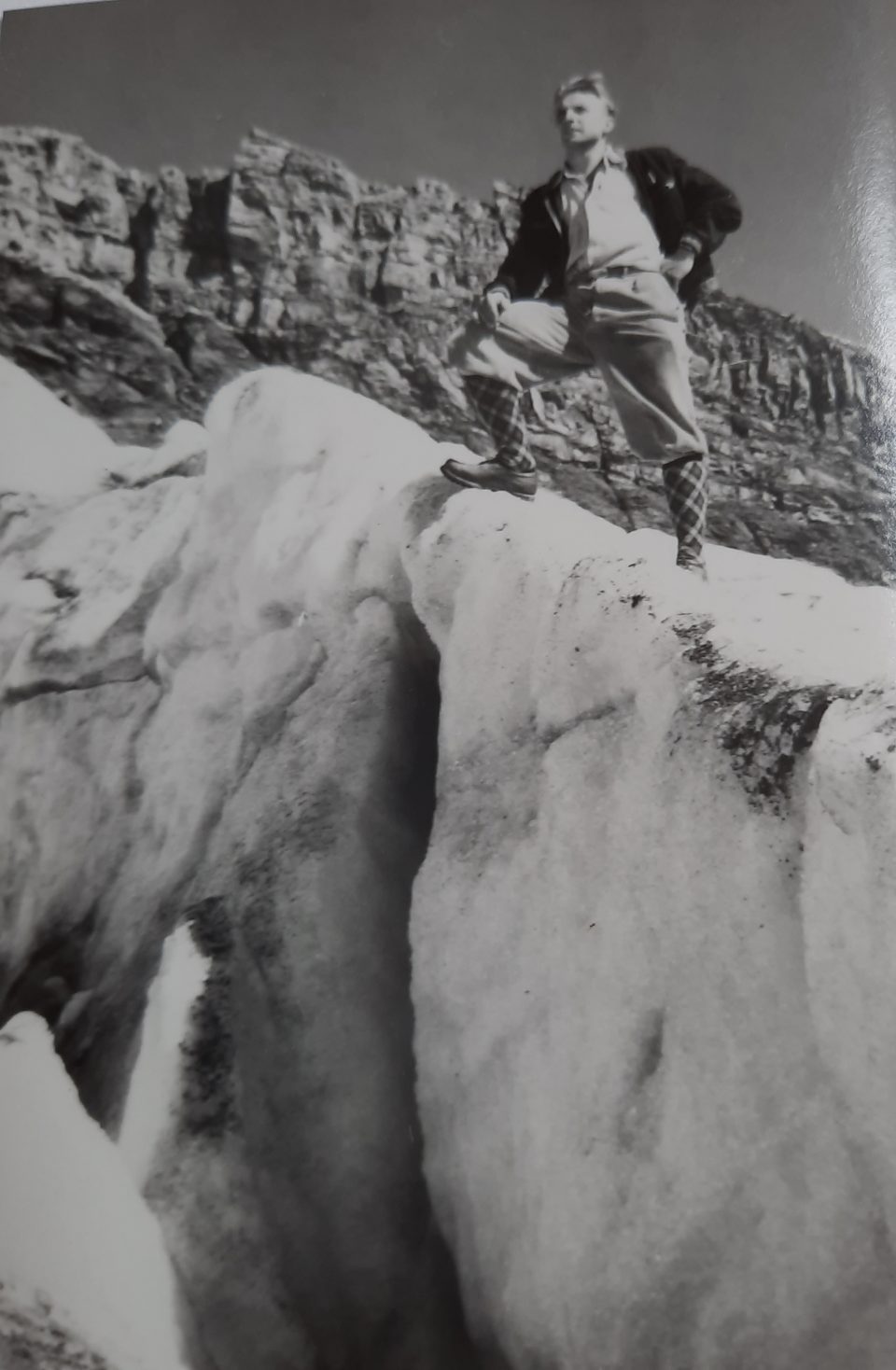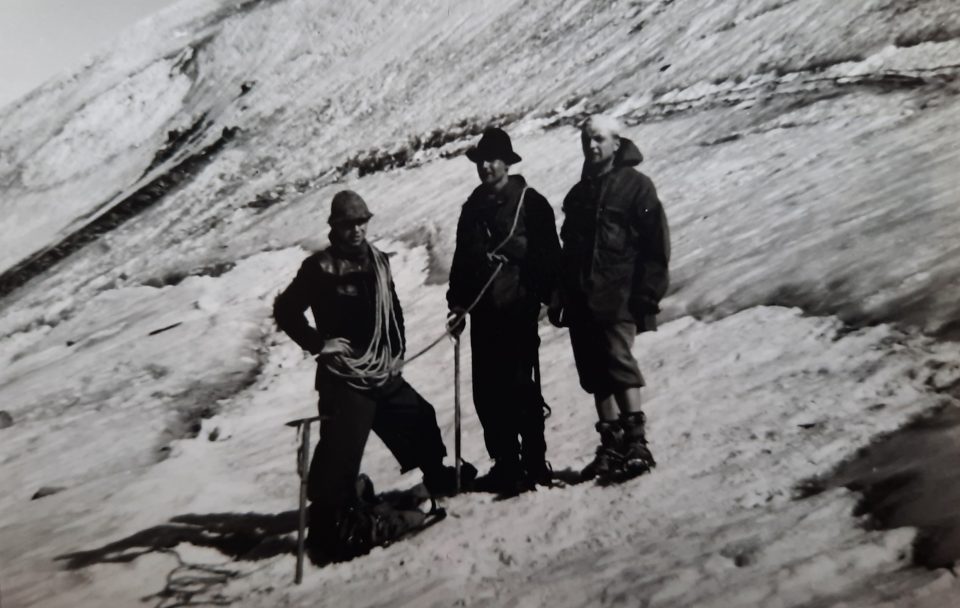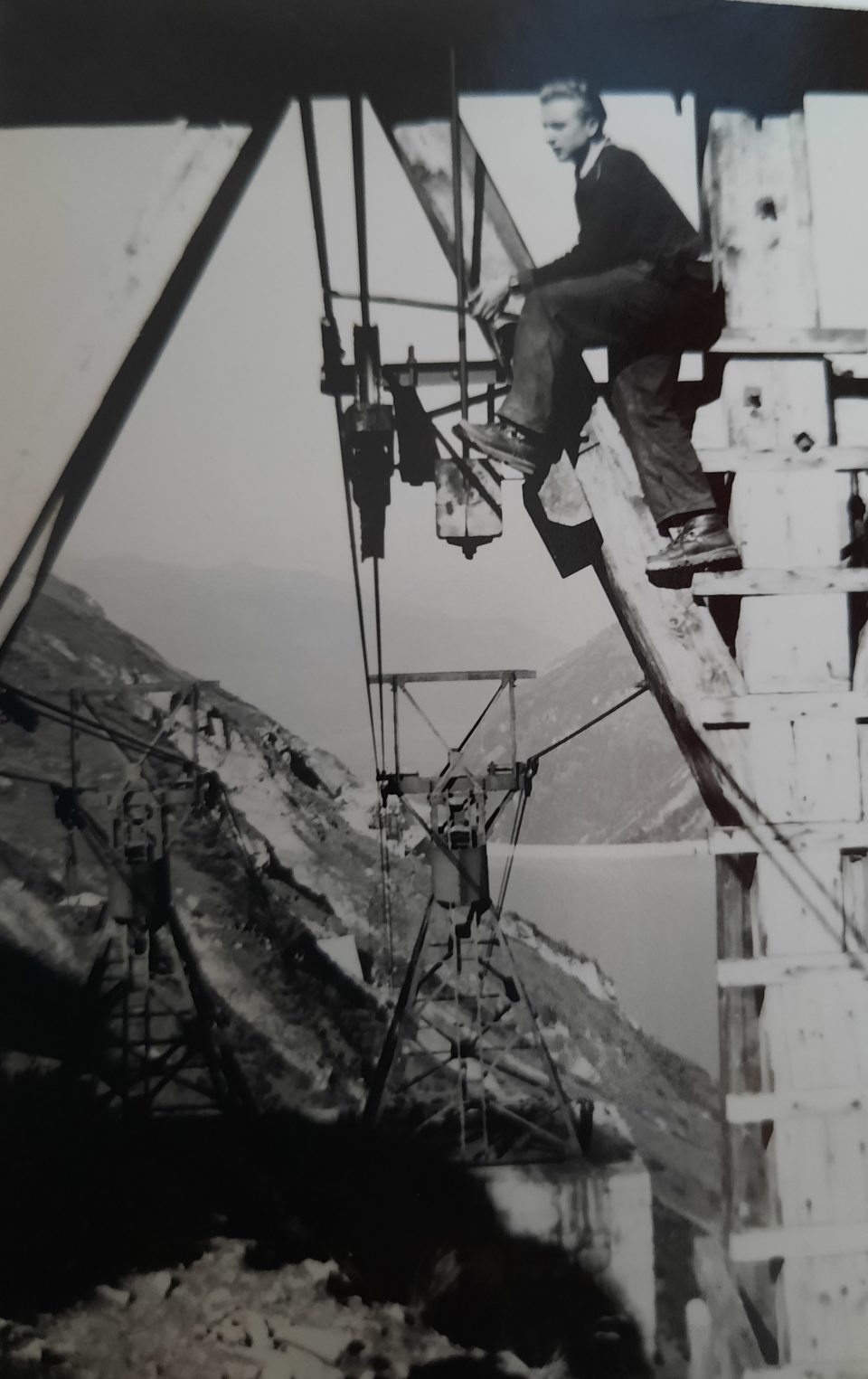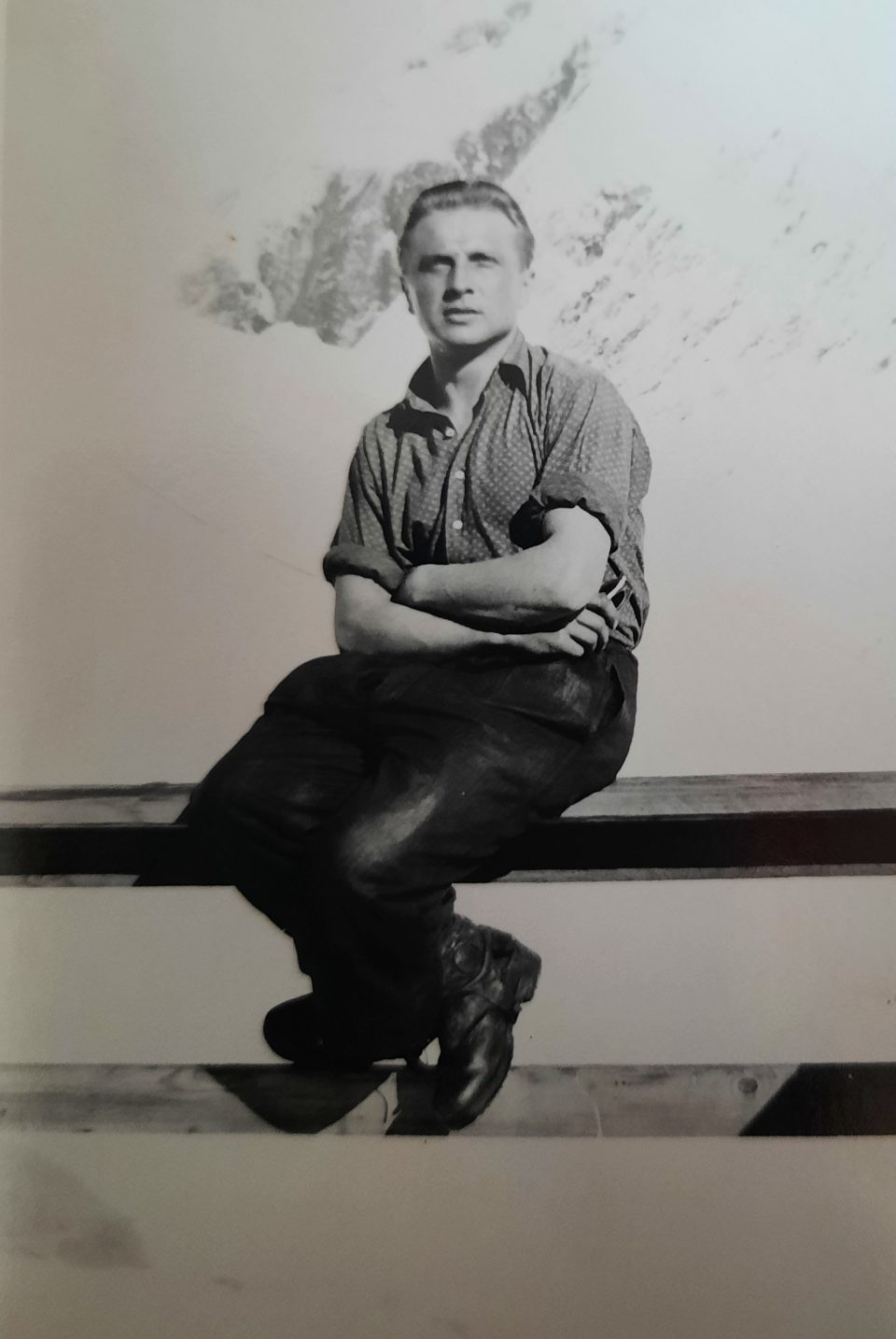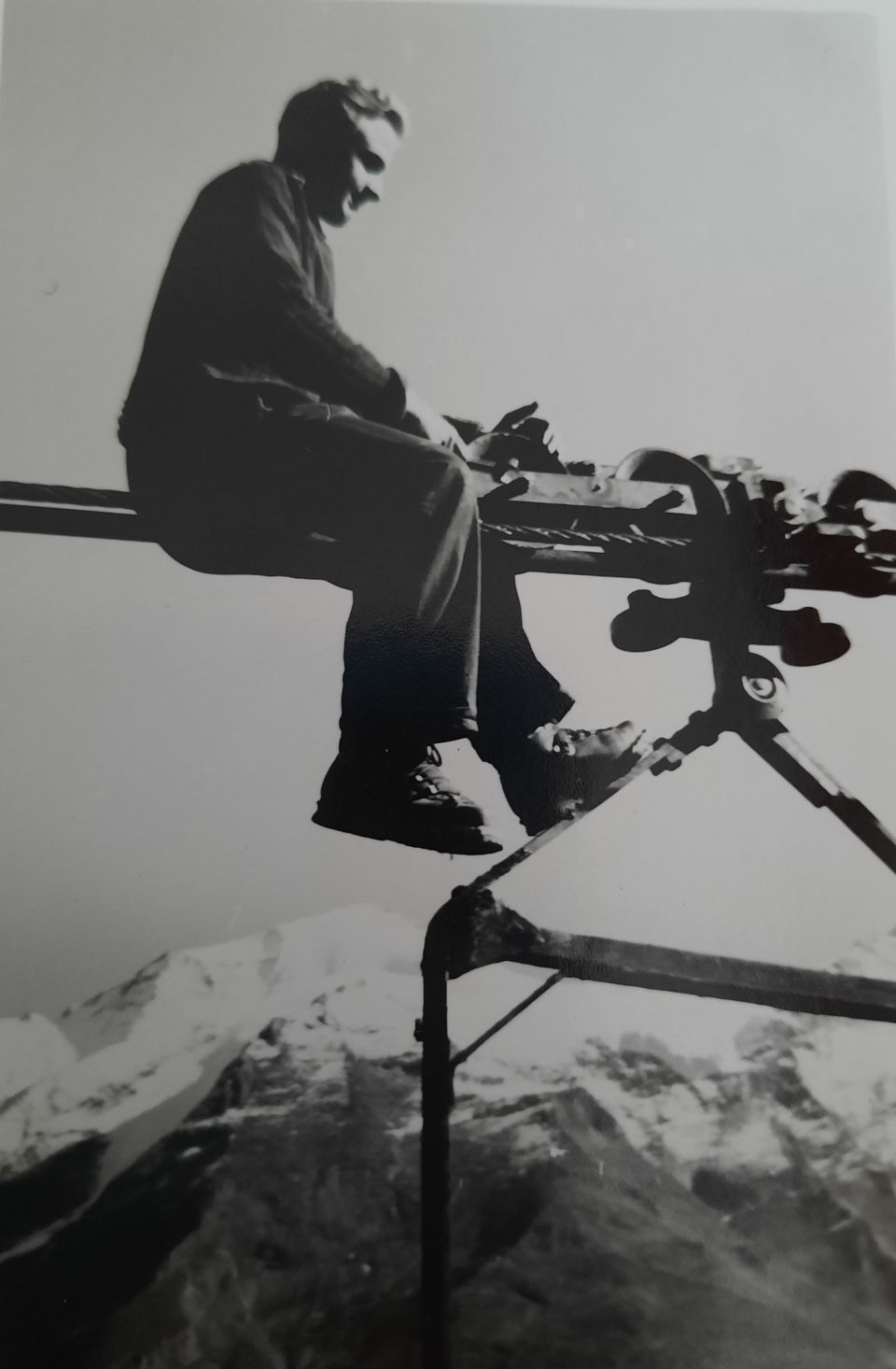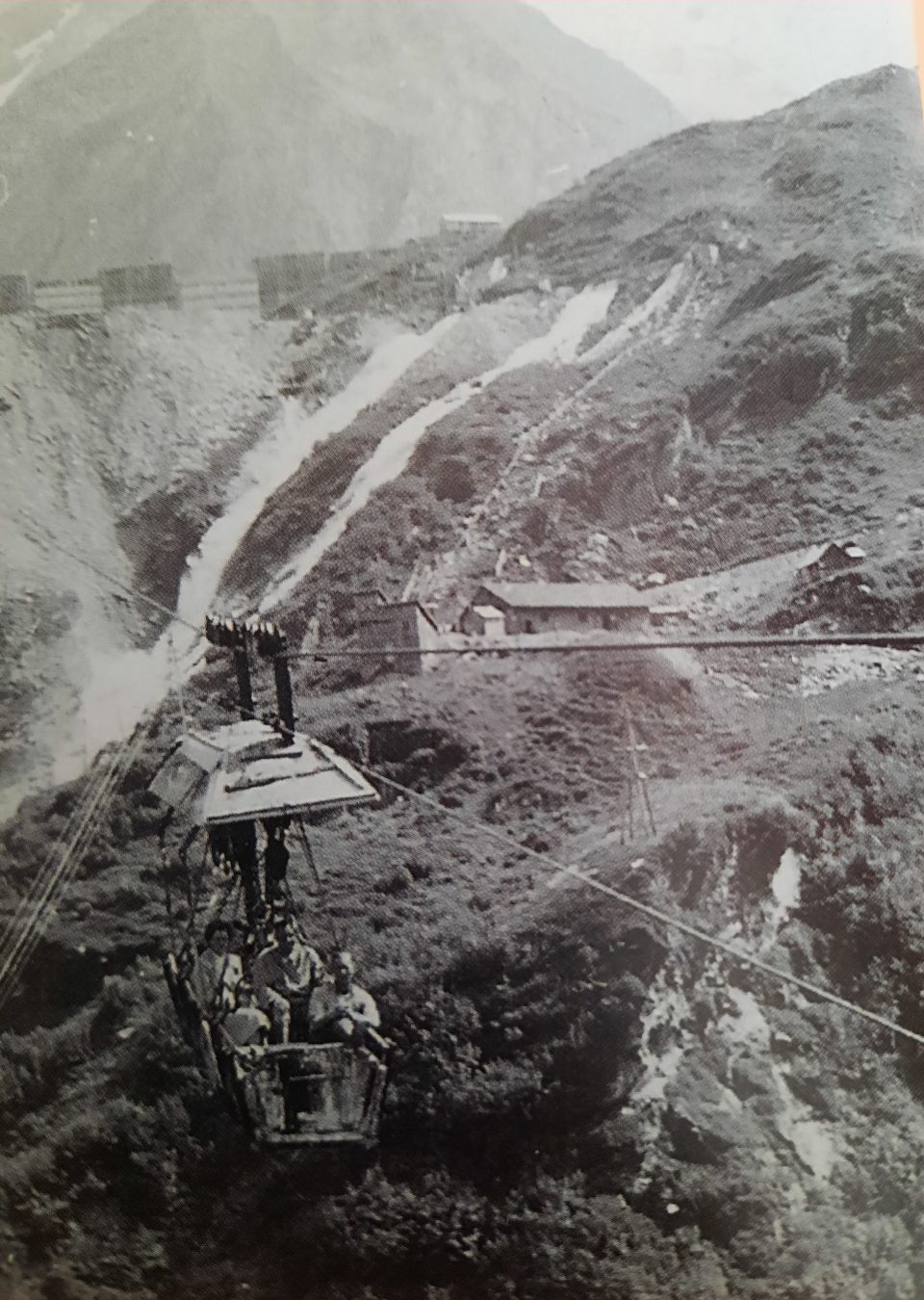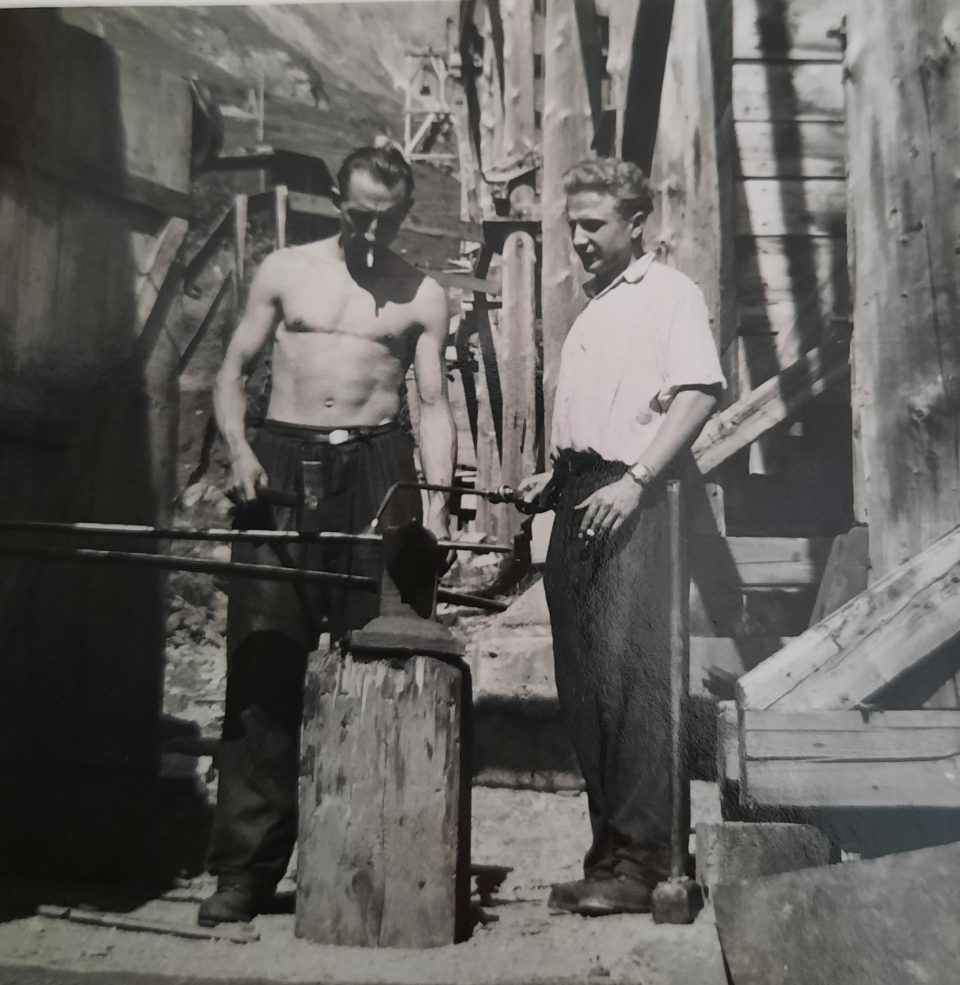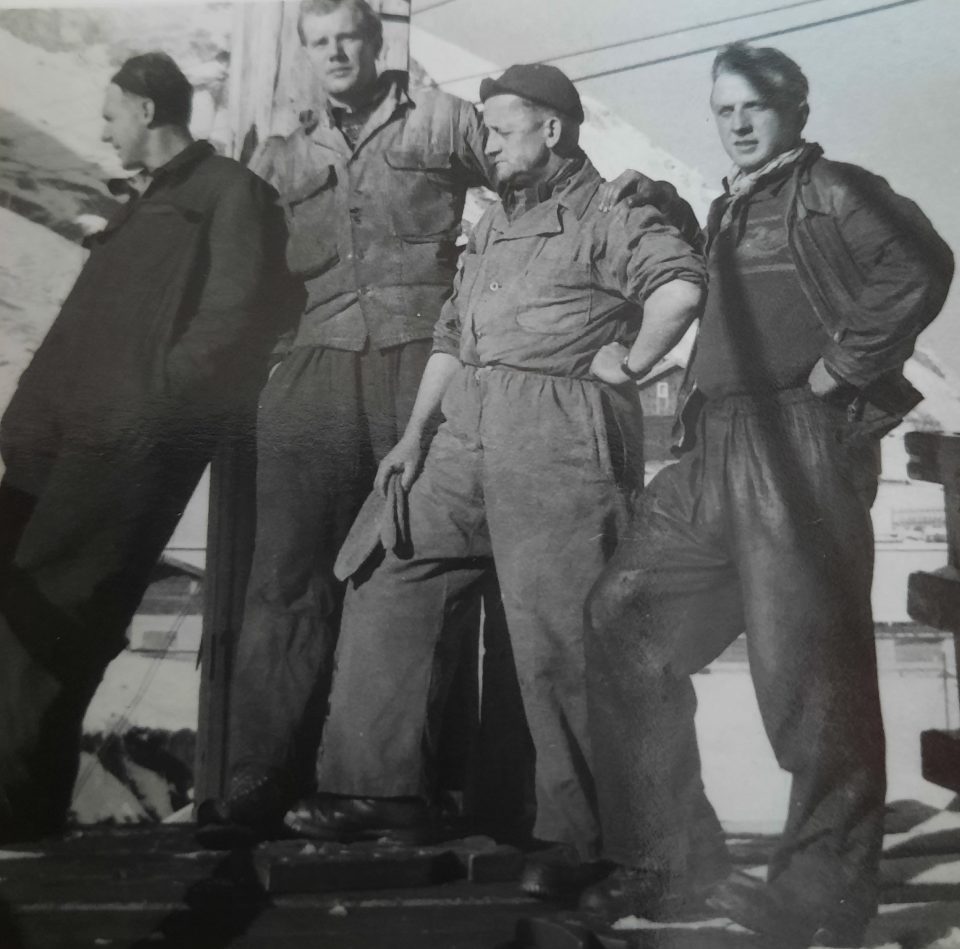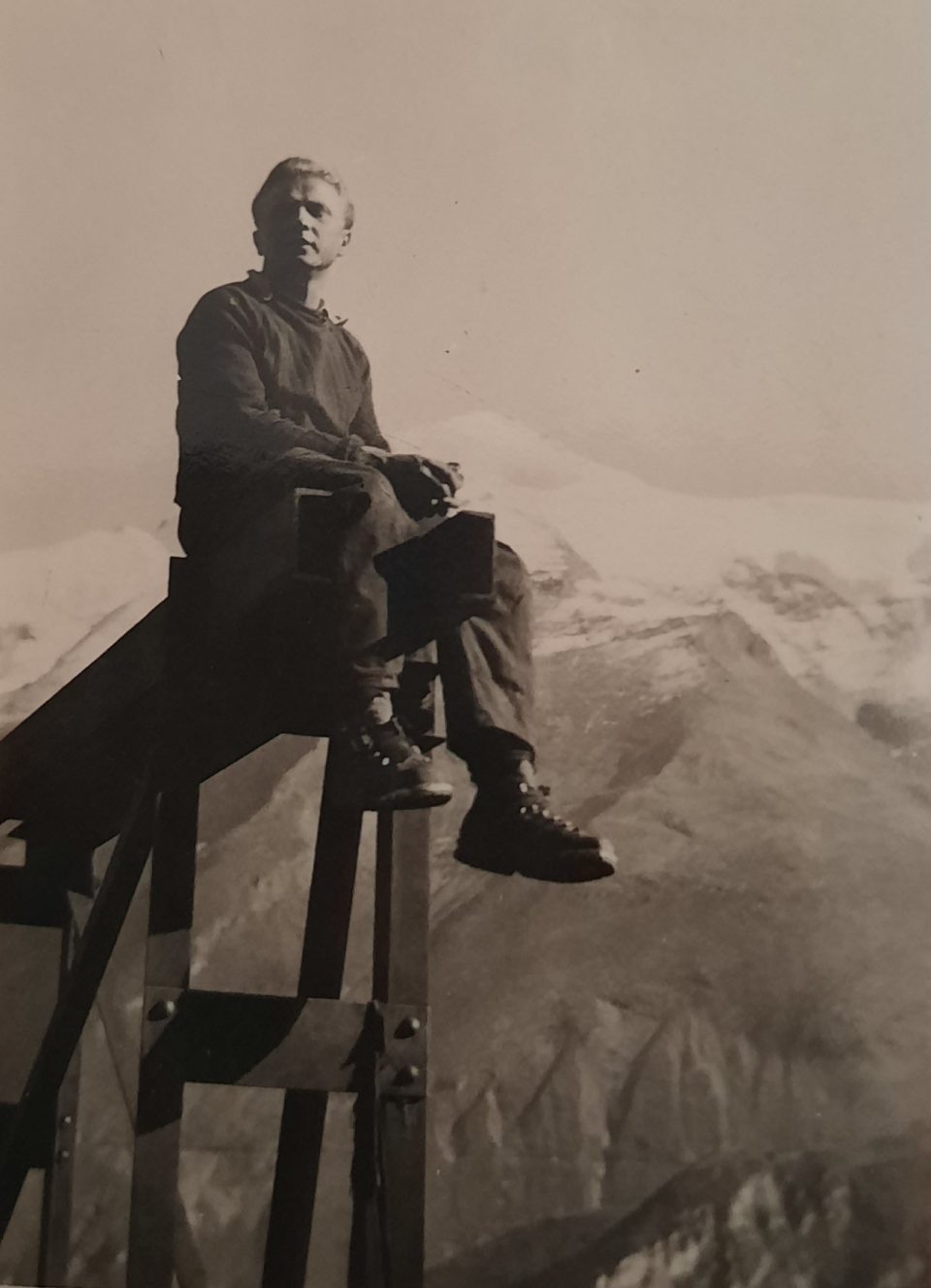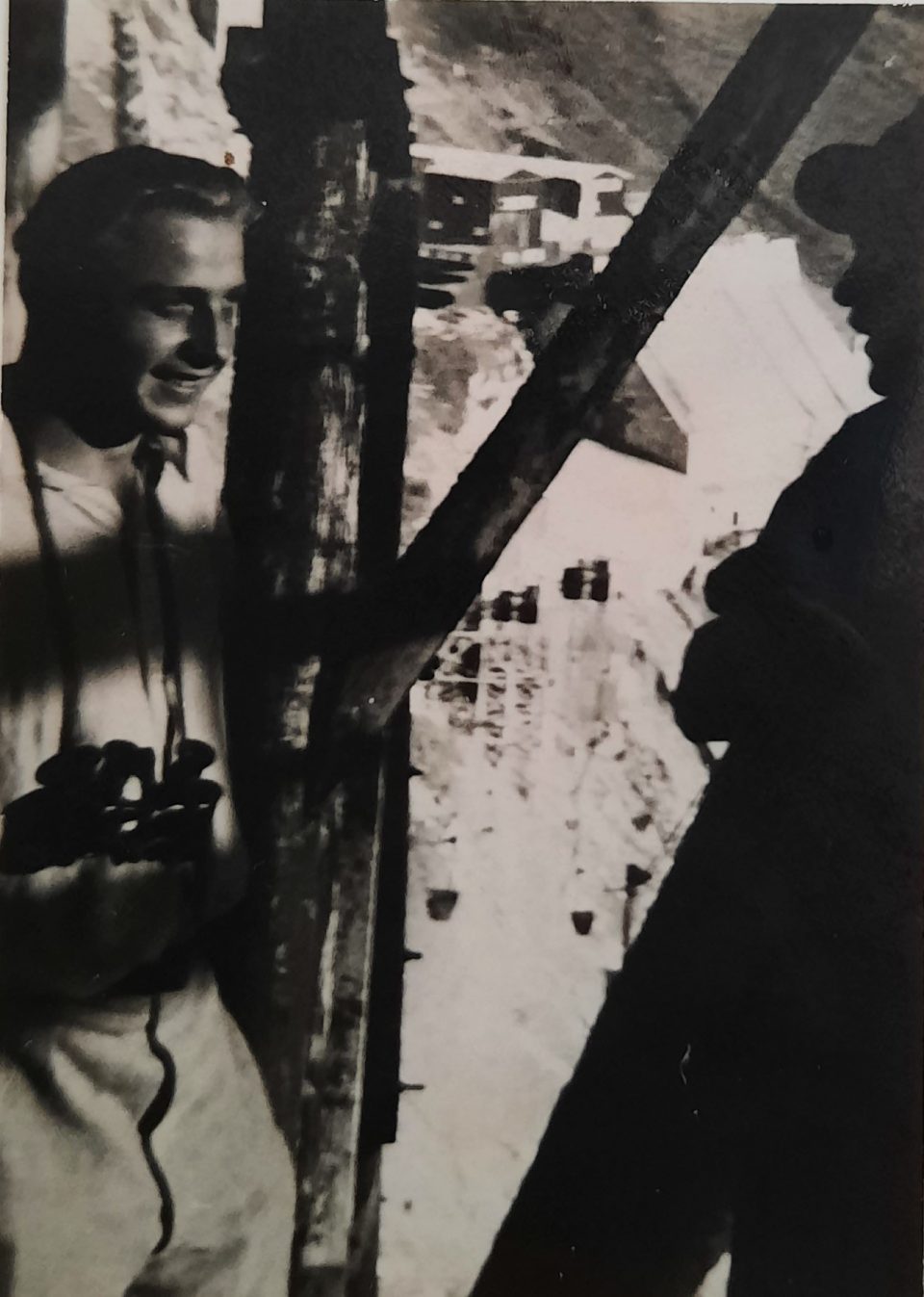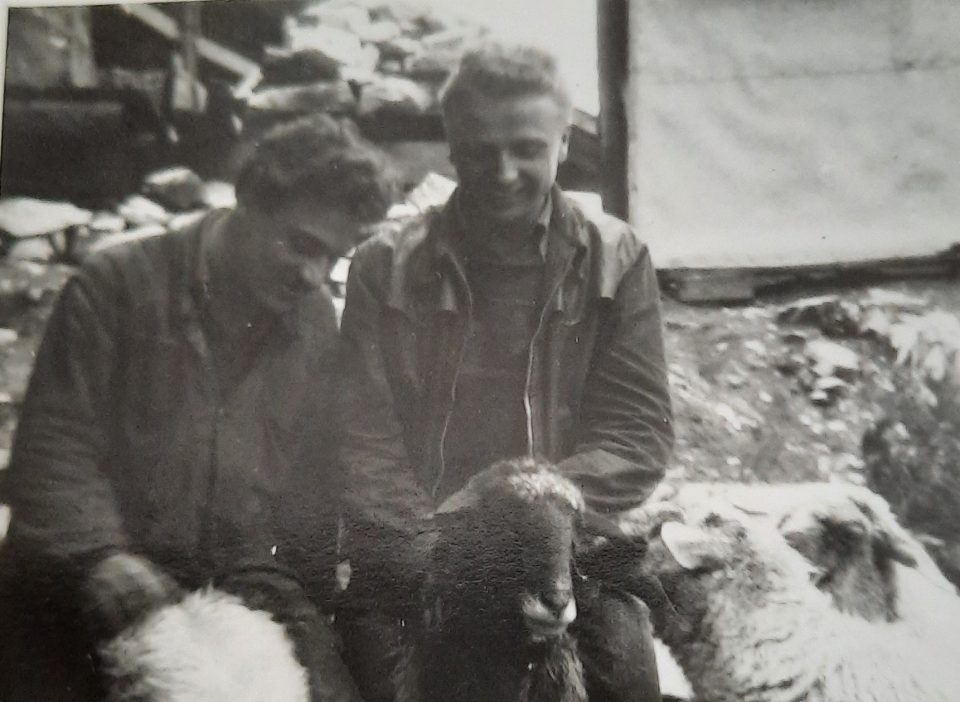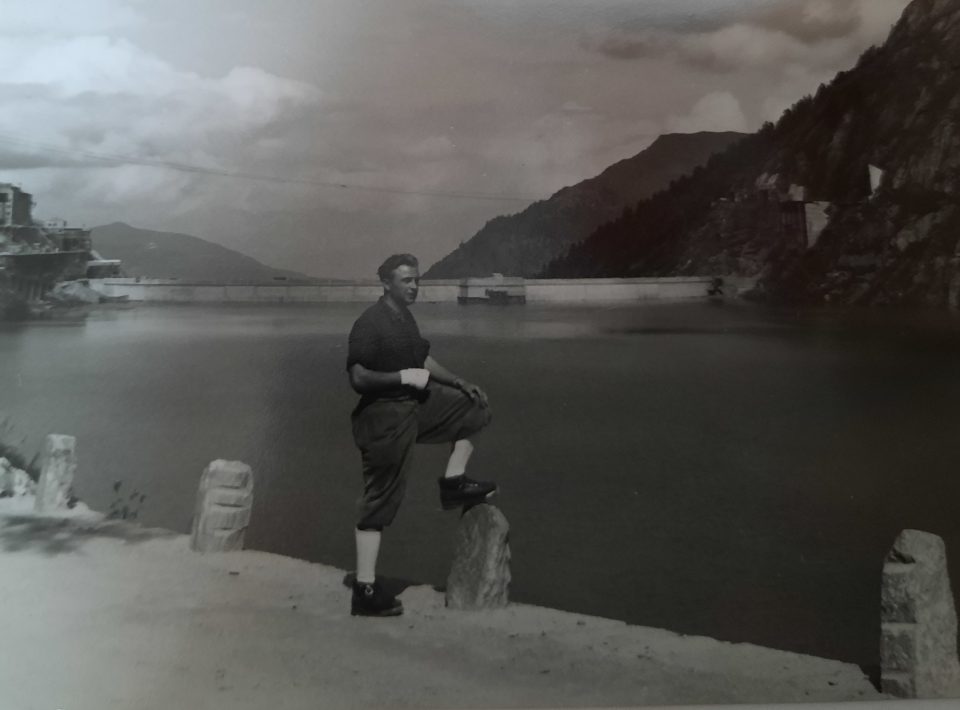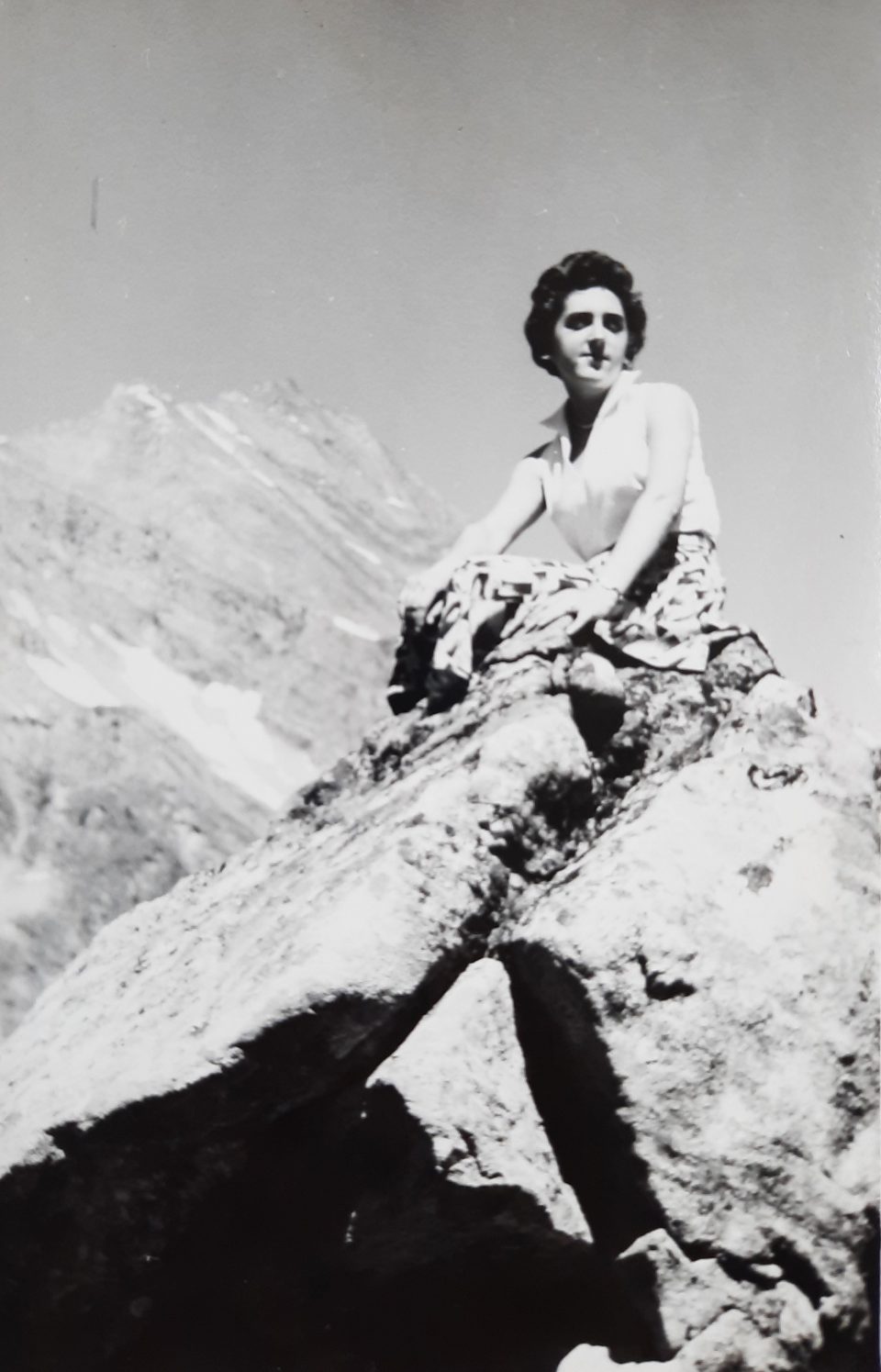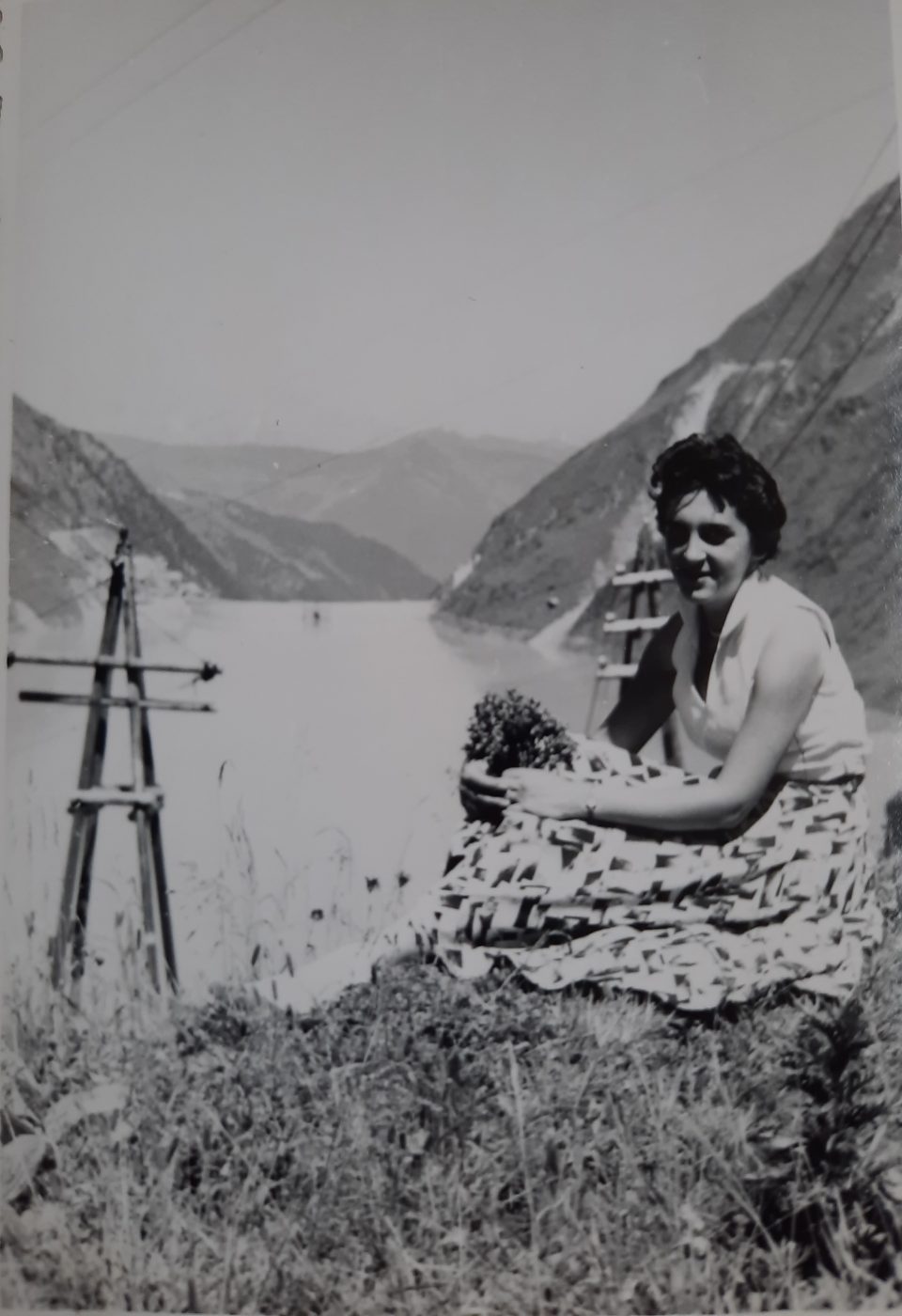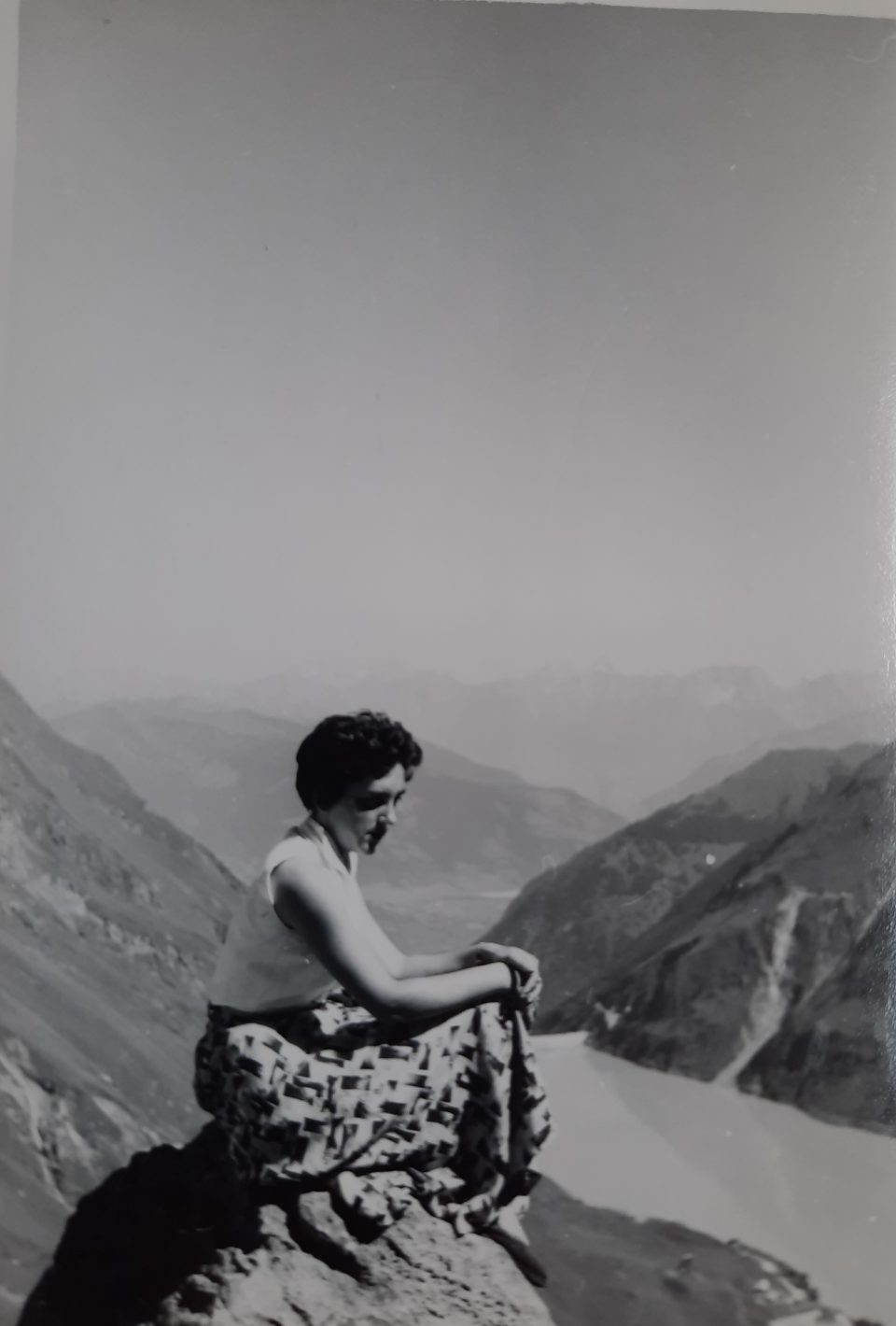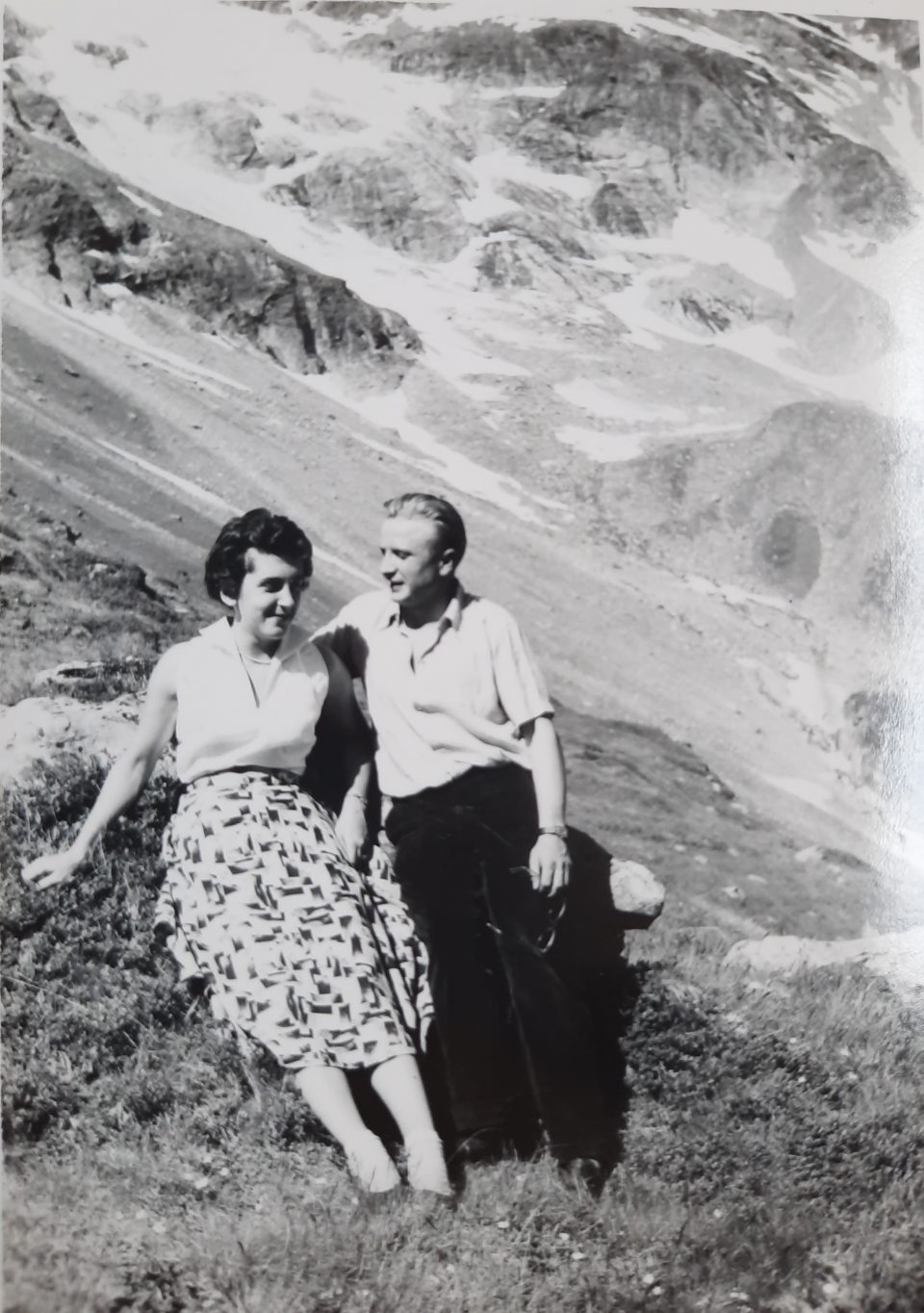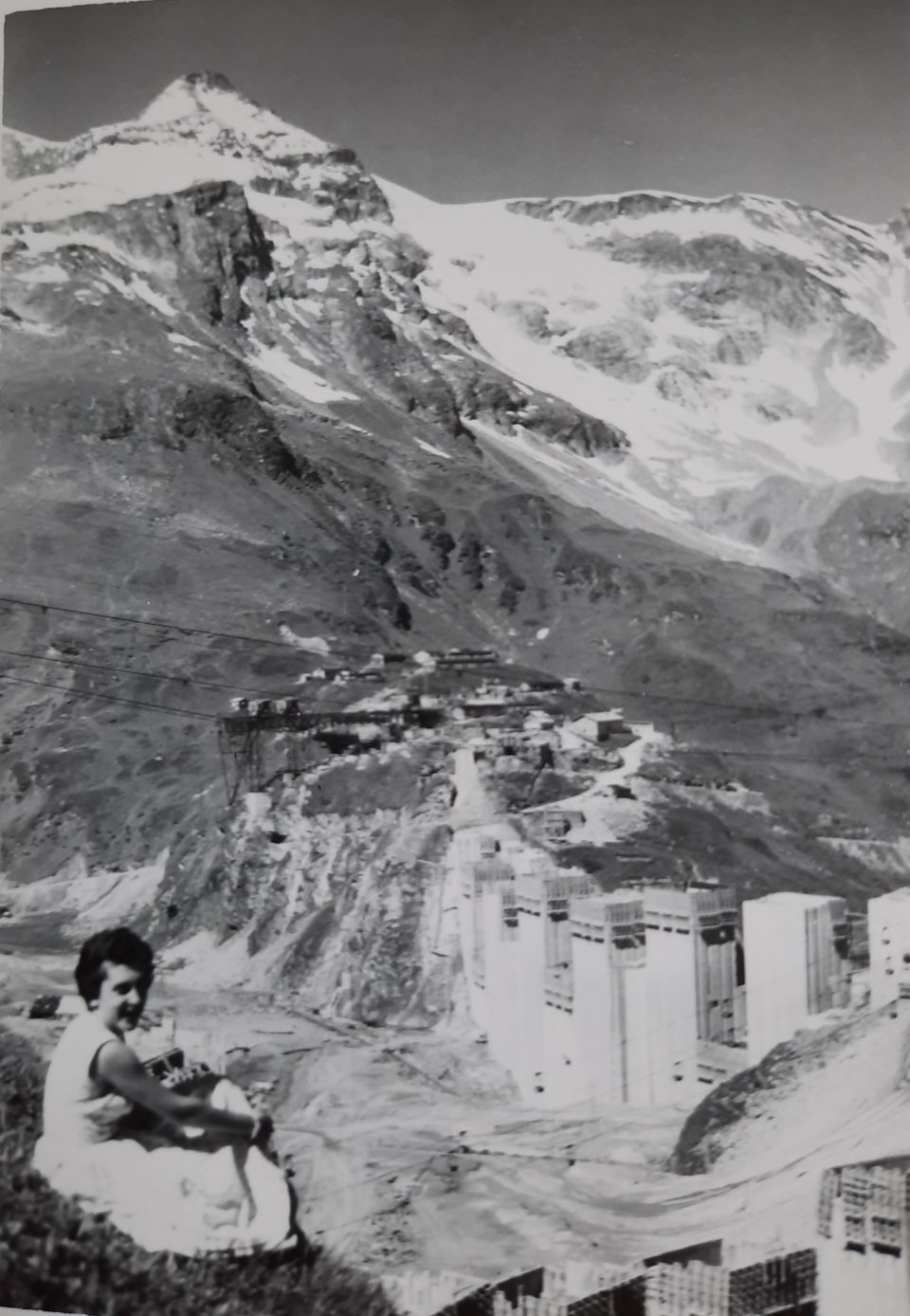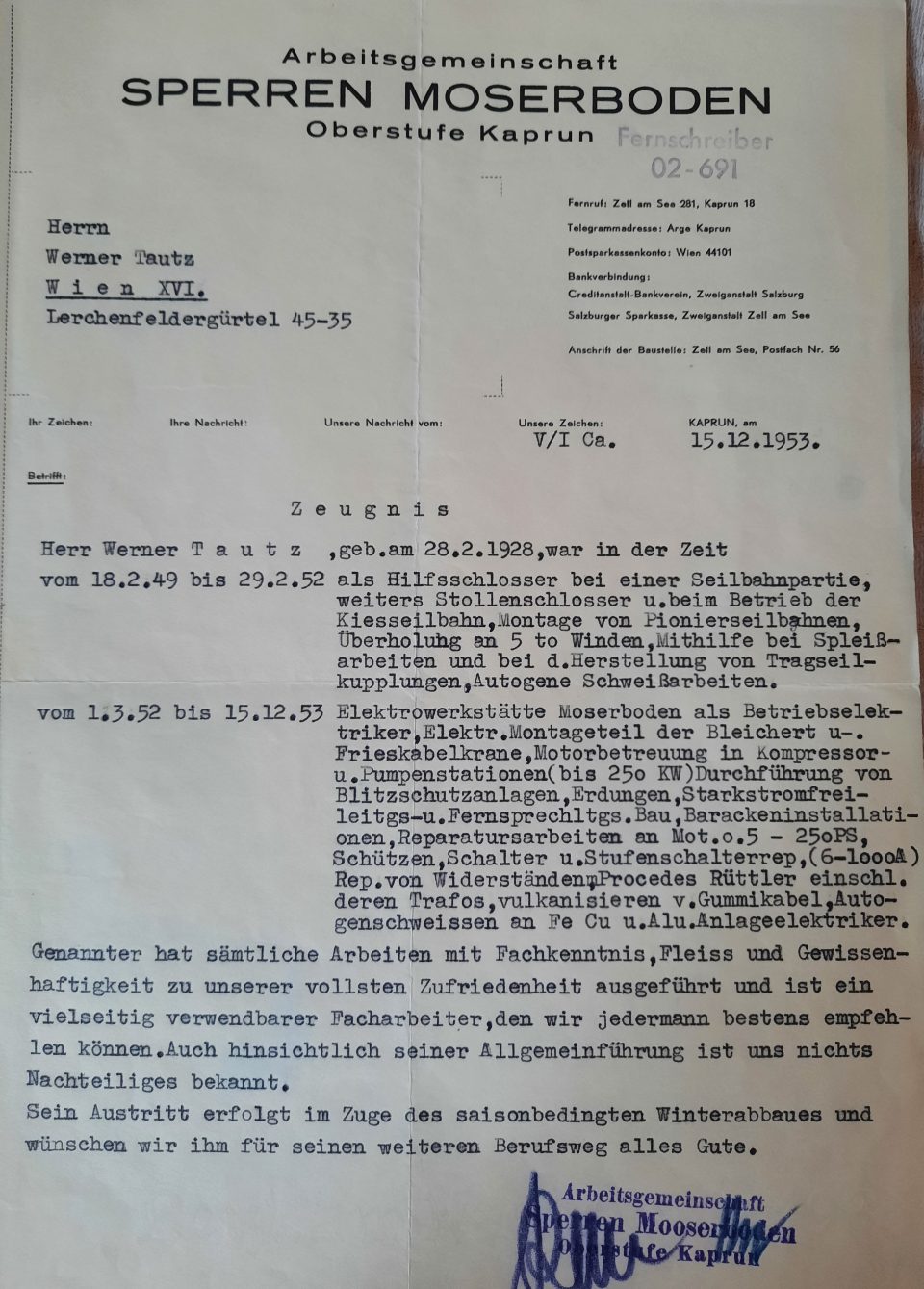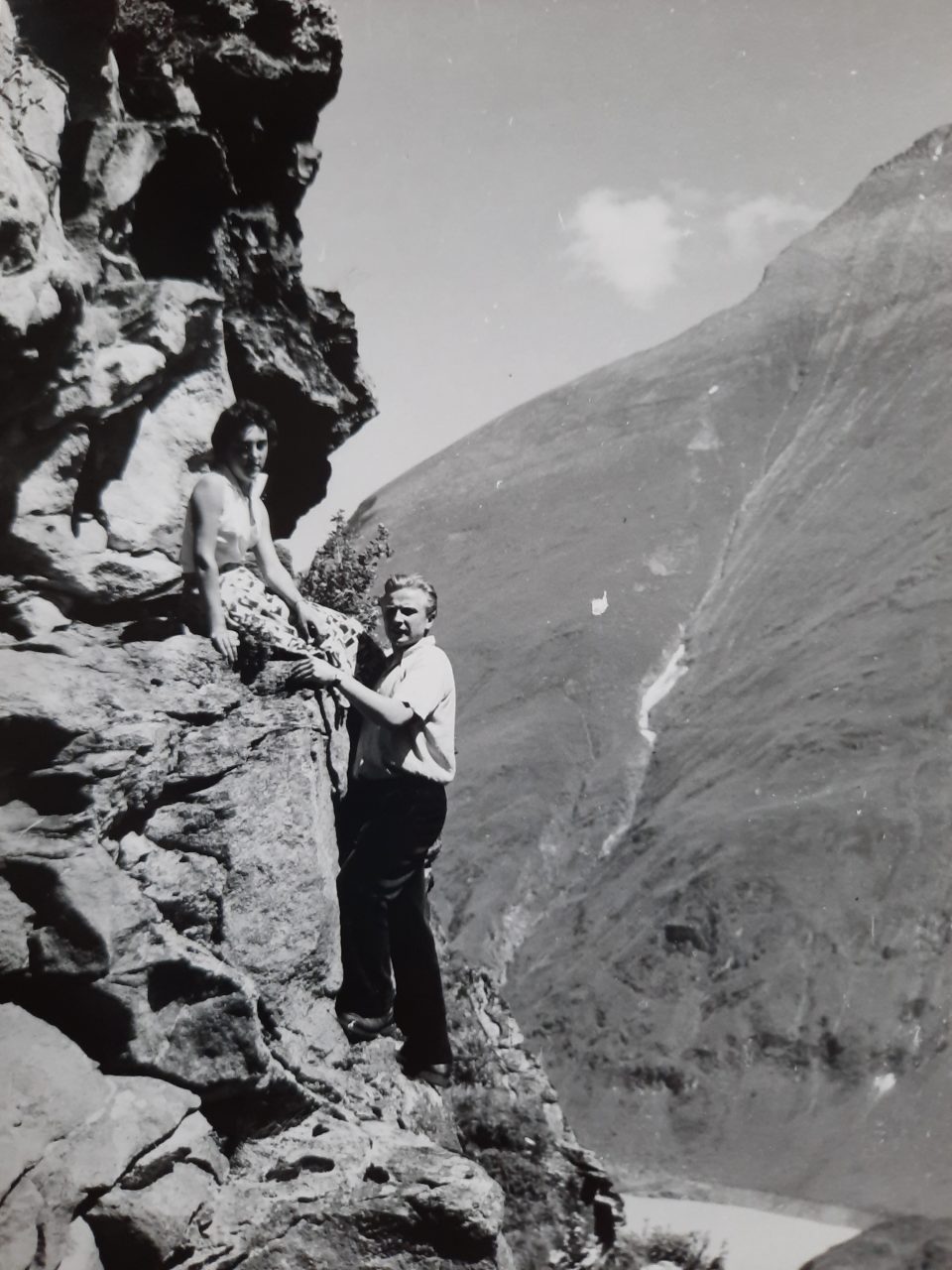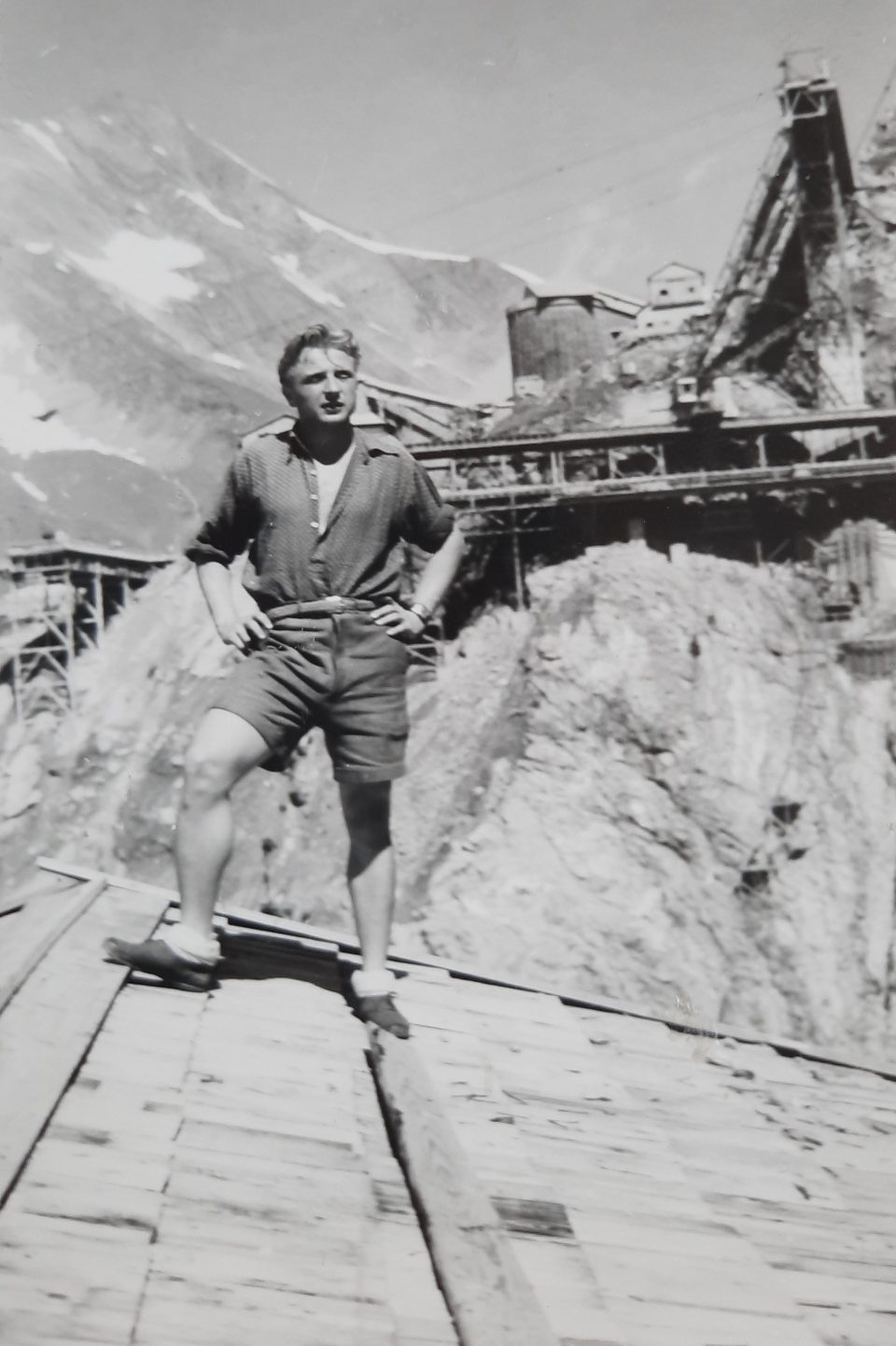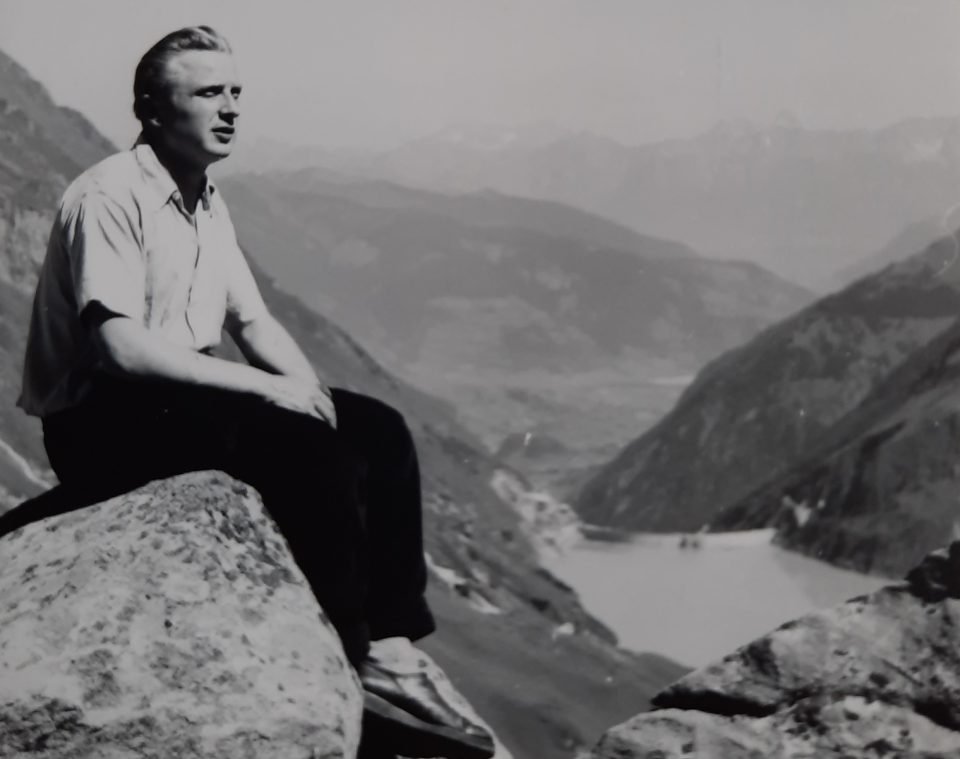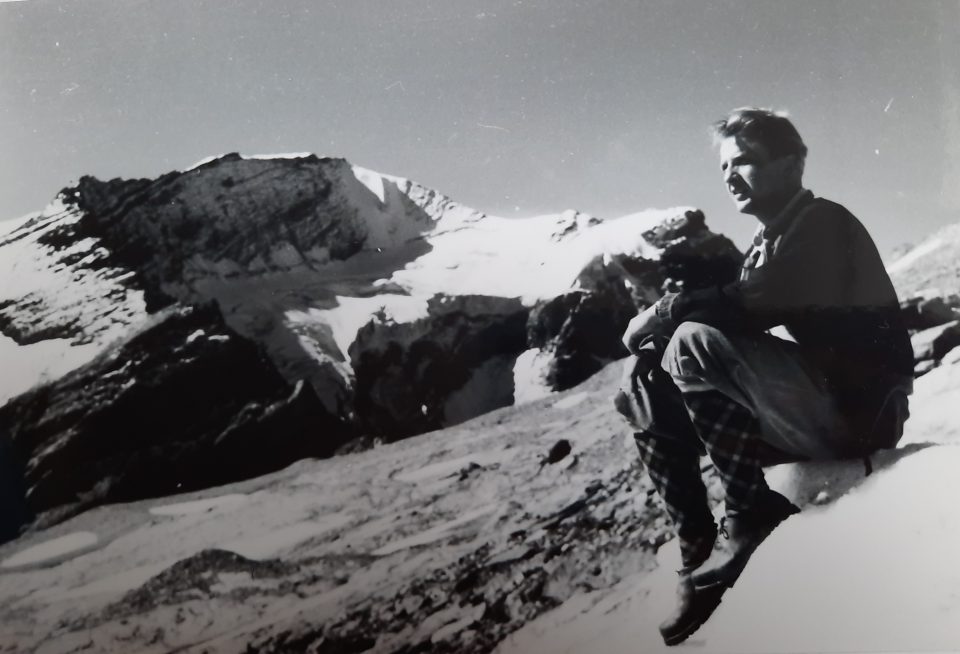Werner Tautz, my father, as a young worker at the construction site of the storage power plant Kaprun in 1952
Before the end of the Austro-Hungarian Empire single entrepreneurs built and ran power stations, most of which were fired with coal as this was a cheap resource in the empire. But after the end of World War I and the break-up of the Austro-Hungarian Empire in 1918 the Austrian First Republic suffered a serious economic set back and a shortage of energy. While the consumption of electricity was rising, coal had to be imported for running the coal-fired power stations. That’s why the construction of hydroelectric power plants was boosted in order to avoid the import of expensive coal from Silesia and Bohemia. Between 1924 and 1930 the newly founded federal state corporations realised the first water power projects despite the resistance of large Austrian banks which refused to finance these projects because they held shares in the huge Czech and Polish coal mines. At the same time the establishment of an interconnected distribution system of the independent federal states’ electric corporations was attempted. So in the 1920s and 1930s a shift from coal to water power was visible. Yet due to the separate interests of the nine different federal states a functioning Austria-wide interconnected electrical grid could not be established.
Even before the “Anschluss” in March 1938 (the incorporation of Austria into Hitler’s “Third Reich”) Germany was trying to get access to the largely unexploited water power resources in Austria. Hydroelectric power stations in the west of Austria already delivered electricity to Germany before 1938. In preparing for the next war Germany made the decision to expand water power production considerably and to centralise the whole electricity production. The “Energiewirtschaftsgesetz” (energy production law) of 1935 made all energy production subject to state planning. Due to the substantial increase in arms production the demand for energy dramatically rose in Germany. There most power stations were coal-fired. That’s why the economic arguments for integrating Austria into the German territory did not just include the extensive Austrian gold and currency reserves, metallurgical resources and production and the skilled human capital, but most of all the opportunities for the exploitation of hydroelectricity. In April 1938 Hermann Göring stressed that the development of the Austrian hydroelectric capacities was not in the interest of the Austrian population or economy, it served the purpose of the German preparation for war. Due to the decisive lack of energy in Germany, the National Socialist (NS) economic planning saw to it that immediately after the “Anschluss” all plans for hydroelectric power plants which had been designed before 1938 were put into practice. This constituted part of the NS “Four-Year Plan” in order to compensate the scarcity of energy in Bavaria and prepare for the establishment of a chemical and metallurgical industry there. Another project was the creation of an interconnected electricity grid which linked Austria to Germany, whereby the west of Austria was completely subjected to the needs of the German weapons production. That’s why 62 per cent of the newly established hydroelectric power plants were situated in Salzburg, the Tyrol and Vorarlberg. All energy production in Austria was centrally planned in Berlin and became part of the state-owned VIAG (“Vereinigte Industrieunternehmungen AG”). This organisation founded a subsidiary, the AEW (“Alpenelektrowerke AG”), which was responsible for the construction of hydroelectric power stations in the Alps and for building up an interconnected and coherent electricity grid. Local energy producers tried to resist, especially in the Tyrol, but to no avail. Yet all attempts at increasing production and capacity during the Second World War could not alleviate the energy shortage in Germany. Already before the war the industry was by far the largest consumer of energy and this trend was further intensified during the war. Until the beginning of 1942 the German energy production somehow managed to meet demand, but afterwards drastic restrictions were imposed on private energy consumption. Nevertheless, the German supply of electricity remained permanently insufficient and could no longer even meet the demands of the weapons production.
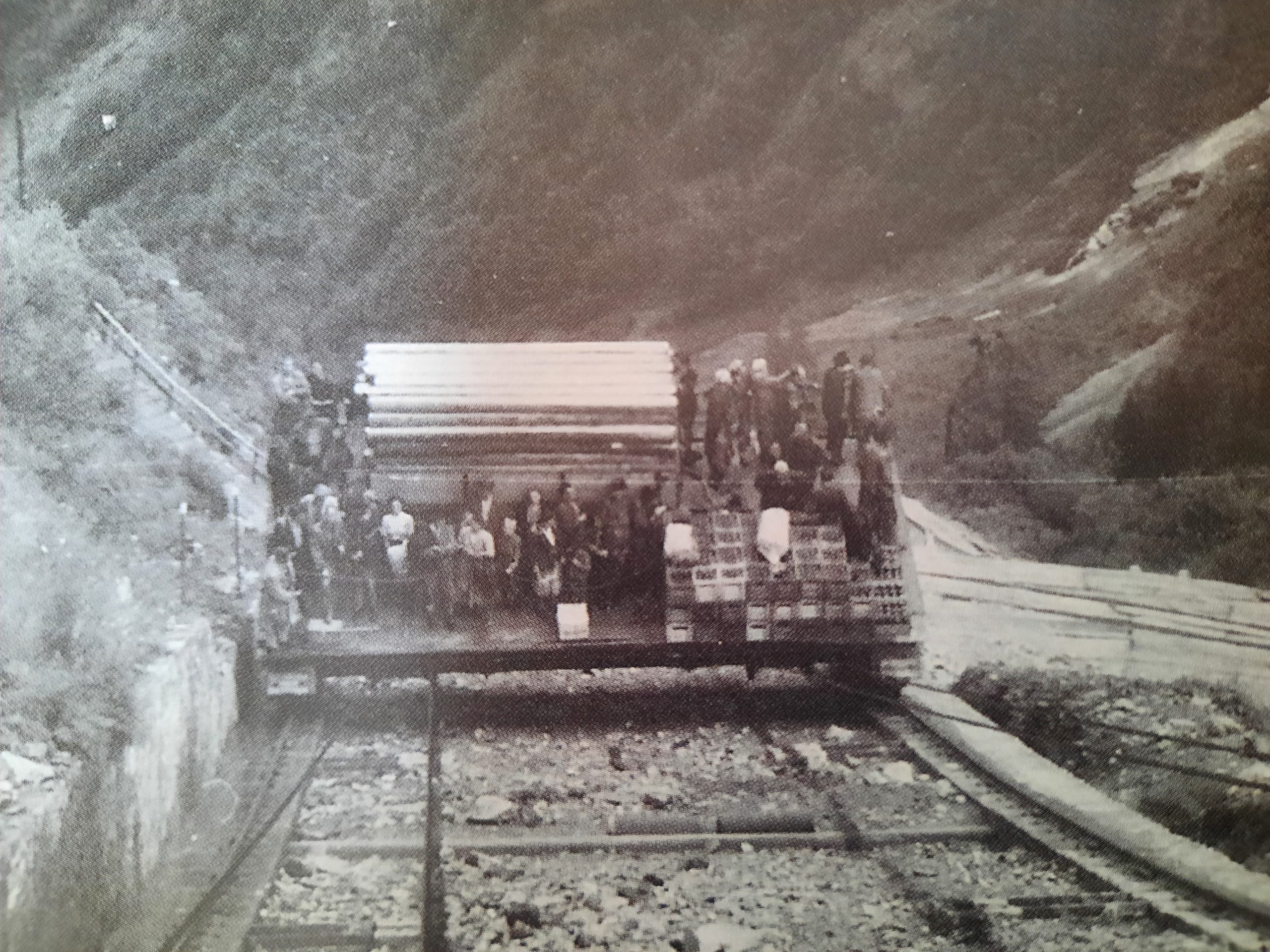
Kaprun construction site: one of the many photos Werner Tautz took when working there between 1949 and 1955
Another economic aspect of the “Anschluss” was the integration of half a million unemployed Austrian workers in German infrastructure projects and arms production, which had suffered under a lack of labour force since 1936. In the first period from the “Anschluss” in 1938 until the outbreak of the war in 1939 not only the unemployed were integrated in the German labour market, but slave labour was already introduced by applying the Nazi racist ideology and compelling the now marginalised population groups, most of all the Jews, Roma and Sinti to forced labour. During the second phase from 1939 until the military disaster of 1941/42 in the Soviet Union the employment of foreign forced labour started with foreign civilians who were forced to work in the German arms production and with prisoners-of-war. At the end of this period the German industry was so dependent on foreign forced labour that without it the war could not have been carried on. The third period from 1941/42 until 1945 was characterised by massive exploitation of Jewish and foreign slave labour. Slave labour in the Nazi period must not be confused with fatigue duty of citizens of the “Third Reich”, for instance of young women who had to work in agriculture for a year or for youngsters under the conscription age to construct motorways or defences (see article on “Nazi Children Evacuation Programme”). All forced labourers were racially or politically persecuted and subject to maltreatment after their home country had been conquered by the Nazis.
Memorial against war and Fascism by Alfred Hrdlicka in Vienna opposite the “Albertina”: on the left the “Gateway of Death” sculpted from “Mauthausen granite” as well as the “Stone of the Republic” with the words of the Austrian Declaration of Independence on the right. “Mauthausen granite” was mined by the KZ prisoners there.
The various groups of forced labourers were treated differently by the Nazis. In Austria around 20,000 Jews were constringed to do slave labour after they had been excluded from the normal job market and the “Ostmark” (Nazi name for Austria) acted without a legal basis and as model for the rest of Germany with respect to brutal exploitation and expropriation of the Jewish population before their extermination in concentration camps (“KZ”). My great-grandfather, Ignaz Sobotka, was forced to do slave labour at the road construction firm “Teerag” and my grandmother, Lola Kainz, worked in the war-related industry in Vienna (see article “Nazi Collection Camps in Vienna”). Roma and Sinti were taken from their work places and locked up in forced labour camps in Austria before being murdered in the KZ Kulmhof and Auschwitz. The GESTAPO further ordered “unruly” German nationals and foreigners to be interned in so-called “labour education camps” (“Arbeitserziehungslager”) for some weeks or months before they were allowed to return to their work places. Another group of slave labour were around 50,000 Hungarian Jews who were chased to Austria from Budapest on foot after an agreement between the SS and the Hungarian Fascist representative Rezsö Kasztner in June 1944. They were interned in camps and compelled to work as slave labourers. The conditions in these camps in Austria were so terrible that a majority of the prisoners died within a very short time. Just to give two examples: in the camp in Felixdorf of 2,087 prisoners 1,865 died within a few weeks; in Lichtenwörth 1,600 out of 2,500 and in Gmünd 486 out of 1,700. When the Soviet army was approaching, those who were still alive were chased in “death marches” towards the KZ Mauthausen and Gunskirchen in the west, whereby 15,000 to 18,000 died.
“Tauern mountain ranges” around Kaprun
Already at the end of 1939 the first prisoners-of-war arrived in Austria and they formed the second largest group of forced labour. According to military rank and nationality they were treated differently, whereby the Soviet prisoners-of-war were always treated worst; they were even systematically murdered. Most of the prisoners-of-war were used in agriculture, but also in factories and for the construction of dams and power plants. How many people died in POW camps and forced labour camps in Austria is unknown but the lowest estimate is 23,039; 96 per cent of which were Soviet prisoners-of-war. This number does not include those prisoners-of-war who died in the KZ network of Mauthausen, where more than 10,000 Soviet prisoners-of-war were murdered. Furthermore this number does not include the prisoners-of-war who died on death marches at the end of the war, when POW camps in the east of Austria, for example in Kaisersteinbruch, Gneixendorf and Edelbach, were evacuated and the prisoners chased west towards Braunau.
The KZ Mauthausen / Gusen near Linz was established in 1938 and starting as an extermination camp with a huge quarry developed in the course of its existence to a large network of concentration and extermination camps with an intricate system of division of labour, which ended fatally for tens of thousands of prisoners until the Allied liberation in 1945. Like many concentration camps the function of the KZ complex of Mauthausen / Gusen was extended from a death camp, whose only function was the killing of those interned there, to a forced labour camp in 1943 due to the drastic labour shortage in the German productive war industry. This meant that the number of KZ prisoners rose from 14,000 at the beginning of 1943 to around 73,000 in October 1944. The focus of employment of these KZ prisoners was the arms production in Linz, Steyr and Wels, for example the companies “Steyr-Daimler-Puch AG” and the “Reichswerke Hermann Göring” in Linz, and the industrial area around Vienna, for example “Henkel Schwechat”, “Flugmotorenwerke Ostmark” (aero engine maker) in Wiener Neudorf or “Rax-Werke” in Wiener Neustadt. The KZ complex Mauthausen /Gusen comprised more than 40 forced labour camps and the prisoners did not only work in the war-related industry, but also in the construction industry for the infrastructure development, such as tunnels and power stations, and finally since autumn 1943 in the construction of a huge network of tunnels to transfer the arms production underground. KZ prisoners had to dig tunnels for example near Melk for “Steyr-Daimler-Buch AG” and the “Flugmotorenwerke Ostmark”, in Ebensee for the development and production of rockets and in Gusen for “Messerschmitt” planes. At least 102,000 prisoners died in the KZ complex Mauthausen.
Foreign civilians were by far the largest group of forced labour in Austria. After the occupation of Poland in 1939, the first Polish civilians arrived in Austria and these forced labourers were mostly employed in agriculture. On the basis of Nazi racist laws (in March 1940 passed against Polish civilians and in spring 1941 passed against Soviet civilians), Polish and Soviet civilians were forced to work in the German war industry to compensate the labour shortage caused by the German military campaign against the Soviet Union. The so-called “Ostarbeiter” (workers from the east) were treated most cruelly. The important war-related industry in the “Ostmark” had to be kept running, so in 1941 40,000 Poles worked there, which constituted 32 per cent of all civilian foreign workers. After the German attack on Yugoslavia in spring 1941 the share of workers from this region comprised 42.3 per cent. These civilian workers were to be paid much less than German workers and were subject to many restrictions; for instance they were not allowed any contact with the indigenous population; they were not permitted to use public transport or attend any cultural or religious events and they were not to be served in inns, pubs or bars. Their situation was continually exacerbated; from 1940 on they had to wear special badges (a triangle with a P), they were not allowed to ride bikes or use cameras and having sexual intercourse with Germans was punished by death. In the first half of 1942 further 45,000 “Ostarbeiter” arrived in Austria, where all the discriminating restrictions were meticulously applied. At the end of 1943 the share of such foreign workers in Austria was around 23.1 per cent and rose to 25.3 per cent in autumn of 1944, which was considerably higher than in the rest of Germany. In May 1942 a quarter of these foreign workers was employed in the construction of power plants and other infrastructure projects, but in the course of the war this percentage decreased gradually to 6 per cent in August 1944. In the electricity production as such – very important for the war industry – only few foreign forced labourers were employed.
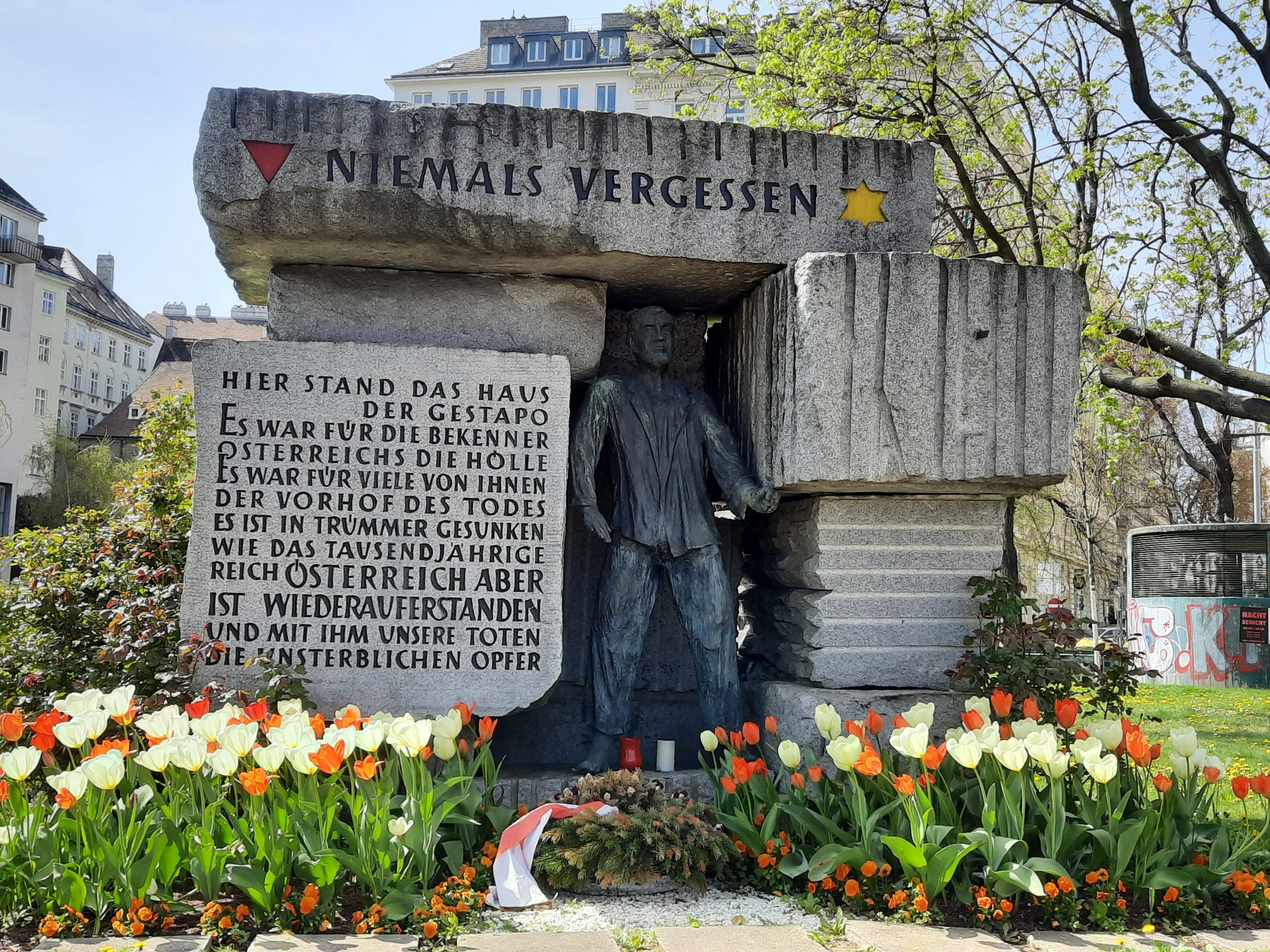
Memorial at the site of the GESTAPO headquarter, Morzinplatz, Vienna
The key NS organisation for running the KZs, the forced labour camps and the persecution of the Jewish population was the SS. Those “Eichmann men” started in Vienna the expropriation, persecution and deportation of the Austrian Jews and then transferred their murderous system to the rest of Nazi-occupied Europe. They were usually young men, 25-30 years of age, ruthless, most of them had failed professionally and could now don a black uniform and brutally and efficiently target, torture and murder the by the NS ideology termed “racially inadequate”. Among the SS the Austrians were in the forefront and were represented over-proportionally in the SS machinery of terror. The GESTAPO stood at the centre of the SS power and seemed to have the allure of omnipotence, headquartered in the former Hotel Metropol in Vienna, Morzinplatz. In reality the number of GESTAPO men in Austria was rather small, around 2,000 in 1942, but they used torture and “preventive detention” outside even the NS judicial system to terrorise their victims and the local population was more than helpful. Most of the GESTAPO actions were triggered by denunciation of neighbours, business partners and so on, which meant that private conflict could be “solved” by informing against the target and by that getting rid of this person. In this way many people ended up in KZs. For the GESTAPO two types of persons worked; on the one hand the “cool jurist” who decided from his desk about life and death and on the other hand, the “sadist and whipper”. They were the ones who organised to perfection the deadliest concentration camps in the whole of the “Third Reich”, the KZ complex of Mauthausen in Austria. There the death rate was 58 per cent in 1941, at the time when it was 16 per cent in the KZ Dachau. All this atrocity happened in the centre of one of the most cultured nations of Europe under the eyes of its inhabitants. One of the deadliest camps of Mauthausen was situated just below the famous convent of Stift Melk, where 15,000 people were imprisoned. The people living in the areas of the concentration camps knew about the conditions there and towards the end of the war the SS did no longer even try to hide the atrocities. The tortured and famished prisoners were chased west in death marches in open daylight. Sometimes the population did not just look on, but also assisted the SS. On 3 February 1945 500 Soviet officers managed to break out of the KZ Mauthausen and the population of the Mühlviertel, north of the KZ, chased the men mercilessly in a collective murderous frenzy. Fortunately not everybody joined in and four Soviet prisoners-of-war were hidden by local farmers and saved.
Kaprun storage power plant
Immediately after the “Anschluss” the smallest of the NS districts (“Gaue”) in the “Ostmark”, Salzburg was to be turned into a model region, which triggered an enormous construction boom with the implementation of huge projects such as a motorway, housing facilities, barracks for housing the region’s “Wehrmacht” headquarters and the “Tauern Power Station”. Together with the hydroelectric power stations on the Danube (Ybbs-Persenbeug) and on the Drau in Carinthia the storage power plant Glockner-Kaprun formed the core of the planned electricity production in the “Ostmark”. Already in May 1938 the foundations were laid, two months after the “Anschluss”. In his speech Göring stressed that the three central energy reserves of the “Ostmark”, mineral ores, wood and water power, were of greatest importance for the NS regime in preparing for the next war. Plans for the storage power plant had already been made during the First Austrian Republic, but the economic crisis of the 1930s prevented the start of the project. Hermann Grengg, who had been an illegal member of the NSDAP party since 1932, was appointed head of the planning and construction team. The AEW, the organisation responsible for the project, had projected two stages of construction, first the main stage including the reservoir “Wasserfallboden”, the dam wall “Limberg-Staumauer” and the power station in Kaprun and then the so-called upper stage, the huge reservoir at 2,000m altitude, the “Mooserboden”. The overall plan had been to start with Kaprun and then integrate three further storage power stations in the Tauern region, namely Matrei, Felbertal and Stubachtal. Grengg calculated that it would take 10 years to complete the power station Kaprun, which would produce half a billion kWh (kilowatt hours). Originally it was assumed that 1,800 workers would complete the first stage within five years. In 1939 the construction of Kaprun was declared a project of the highest priority for the “Third Reich” and any regional or private interests had to be set aside. This meant that all the necessary permits were granted without delay and no appeals were possible. Very soon it was clear that the construction plans could not be realised in time and that there were considerable delays arising from a lack of labour, construction material and fuel due to the war. The optimistic reports in the financial statements of the AEW could no longer cover up the fact that the power station would not start producing electricity at the end of 1943. The harsh conditions in the high mountain ranges of the Alps hindered the progress of the construction works. Sometimes building work could only be carried out for few months or weeks per year due to snowstorms, ice, flooding or landslides in an altitude of around 2,000 meters.
The mountainous region where the Kaprun storage power station was built:
The provision of labour had been problematic from the start. Initially there was euphoria in the “Ostmark” because jobs were provided for the many unemployed and from the eastern region around Vienna unemployed workers flocked to the construction site. The local authorities had been worried that there would be a drain on agricultural labourers in the region and made clear that they would not consent to excessive recruitment in the district of Salzburg and its vicinity. The enthusiasm about the provision of labour soon abated when the workers were faced with wage freezes, increased work pace and the right of the foremen to lengthen the daily working hours from eight to twelve. Above all, the pay rate was not better than during the time of the 1st Austrian Republic. Soon an undercurrent of protest was palpable and in January 1939 the GESTAPO in Zell am See received notice of agitation of Viennese workers, who had trade union training and were spreading “Communist slogans” at the big construction sites in Salzburg. Among the workers and the farmers in the region fear of another war was rampant already in 1938, especially since the NS authorities had started with excessive registrations and medical examinations for military service of all men born between 1893 and 1913. Göring reacted by speeding up the start of the construction works in Kaprun. The Austrian “Industriekredit AG” was “Aryanised”, which meant that the Jewish owners were dispossessed, and the “Alpen-Elektrowerke AG” (AEW) was created, which was responsible for planning and construction. It was the forerunner of the later “Verbundgesellschaft” and the “Tauernkraftwerke AG” (TKW). The AEW was part of the VIAG (“Vereinigte Industrieunternehmen AG”), a huge holding company which incorporated all nationalised industry in Germany and was under direct control of Hermann Göring. Now Kaprun was administered by the Nazis in Berlin and considered a war relevant project.
But as soon as the majority of the male population of the “Ostmark” was drafted to the “Wehrmacht” it became obvious that foreign workers had to be employed despite the NS ideological rejection of foreigners; otherwise the centre piece of the NS energy provision, which was essential for the war effort, could not be put into practice. Since May 1939 Czech workers from the occupied Czech territories were recruited and Mussolini agreed to send Italian workers. Rapidly the share of foreign workers rose to 90 per cent from twenty different nations, whereby the share of Austrian and German workers made up only 3 per cent. Grengg and the management of the AEW continuously urged the local labour offices to send workers to Kaprun, but to no avail. So they resorted to Soviet prisoners-of-war, who “nobody wanted to use” because they were so famished and emaciated, and to Czech and Slovak workers, who were constringed to fatigue duty. Initially several foreign workers came to Kaprun from other Fascist countries who were in league with Nazi Germany, such as Italy, Slovakia, Croatia and Hungary because they believed the NS propaganda of high wages and good working conditions. But as soon as the war started in 1939 most of the foreign workers did no longer work voluntarily in Kaprun; they were deported from their home countries and forced to do slave labour. Most of the forced labourers in Kaprun were extremely young. From 6,300 workers whose birth dates are known 5,000 were between 14 and 28 years of age, which makes up 77 per cent and around 23 per cent (1,500) were 20 or younger. The NS recruiters focussed on the very young in all the regions where they forced people to work for the NS war industry because their physical condition was deemed better. Female forced labourers were mostly employed in service positions, such as in kitchens. The average duration of work at Kaprun was 11 months. How many prisoners-of-war were employed in Kaprun is now difficult to assess because they were not registered at the local authorities and were not insured by the construction companies which employed them. In October 1943 the parish chronicle of Kaprun reported 6,000 workers who were employed at the construction site; 4,000 of which were prisoners-of-war. In their memoirs Ukrainian forced labourers spoke of 4,000 Soviet prisoners-of-war in Kaprun, too, and of 1,500 Soviet officers who were interned in the camp Zeferet. In addition the local police station recorded Polish, Belgian and French prisoners-of-war.
The housing of the workers in this exposed Alpine region was a challenge. Initially the employees of AEW stayed in private homes in Kaprun and Zell am See and plans were made to build workmen’s dwellings on site for German workers and shanties for the foreign workers. With the fast increasing number of foreign workers, in fact most of the workers were housed in such shanties. According to Nazi racist ideology the workers were housed separately according to nationality and the so-called “Ostarbeiter” had to endure the worst living conditions. According to memories of Ukrainian forced labourers up to 90 Ukrainians were squeezed into shanties which were supposed to house 22. Originally some of the shanties were planned to be only used during the summer months or during special construction phases, but due to the many delays the plans for the number and location of shanties had to be adapted continuously. In the end any coherent planning was abandoned, when many more forced labourers were working in Kaprun than originally projected. Contemporary sources list 19 camps, whereby POW camps were not mentioned there.
In the second half of 1939 two camps for Jewish slave labourers are listed, but at that time the number of Jewish workers seemed to have been low, around 5 per cent. Most of them were Viennese and had been assigned to Kaprun by the Viennese labour office via the road construction company “Winkelbauer”. Most of the other Jewish forced labourers were doing earth work for the company “Arge Tauernsperre” at the dam wall “Limbergsperre”. Already at this point in time the working conditions for the Viennese Jewish workers were much harsher than for the other forced labourers. They were isolated in their camps, were not allowed to leave those camps and had no days off. By the end of September 1939 all the Jewish workers had been sent back to Vienna, where they were assigned to other construction sites and finally deported to concentration camps. In Kaprun they were replaced by Polish prisoners-of-war.
A common occurrence: a landslide or avalanche destroyed the workmen’s dwellings (Werner’s post-war photos)
More is known about the working and living conditions of the so-called “Ostarbeiter” due to the memoirs of three Ukrainian forced labourers (Trofim A. Tilipenko, Pjotr I. Sitschni and Wladimir Semjonowitsch Ostrogradski). When they were forced to leave their homes in the region of Krementschug they were 15 and 16 years old. In November 1943 the village elders were ordered by the Nazis to name a fixed number of young men fit for work, who were then loaded on box wagons – 60 per wagon – and transported in exhausting train journeys lasting several days to Wörgl in the Tyrol. There they were examined and then divided up into troops of 200 men and conducted under armed escort to Kaprun, where they were registered (photo, fingerprints) and were issued a “Ostarbeiter” ID and a badge saying “Ost” which they always had to wear attached to their work clothes so that it was visible. Finally they were carried up the mountain to the construction sites in the high Alps via a goods cable lift. The camp “Grubbach” for “Ostarbeiter” was located at 1,600m altitude and the living conditions there were abysmal. In one shanty around 90 men had to sleep on mouldy straw sacks; heating, toilets and wash basins were grossly inadequate and full of bugs. The camps were surrounded by barbed wire and constantly guarded. Despite their young age the men were divided up into two groups of workers doing hard labour: the “Schtolniki”, who were working in the tunnels, and “Naruschniki”, who were working in the open air. They had to work twelve hours per day quarrying stones and loading them without protective masks, proper shoes or rubber boots wading in water or snow. The “Ostarbeiter” had no employment contract, did not receive pay, although their wages were recorded in the wages and salaries department, because there were so many deductions from their anyway low wages, such as the “Ostarbeiterabgabe”, that nothing was paid out in the end. They had only few days off and the food they received was much worse than that of the other foreign workers. They had to eat on their bunk beds and were not allowed tables and chairs. Furthermore they could not organise any food on the black market because they had no money. Their rations were so small that only a few weeks after their arrival in Kaprun they were already undernourished. Their equipment was totally inadequate, which consequently resulted in many accidents, but for them medical treatment was not available. Many of the “Ostarbeiter” were maltreated and abused by the Nazi guards and foremen, mostly older Austrians who were unfit for military service. Contact to the local populations was strictly forbidden under threat of deportation to a concentration camp, but it could not come about anyway because they were not allowed to leave their camps in the high mountain ranges. Only very limited contact to their families at home was possible and the little information they received about the progress of the war, for instance, they got from other foreign workers because newspapers, the radio or other spare time activities like card games were strictly prohibited, too. Abuse, violence and humiliation were ever present, such as splashing the workers with cold water in winter or lashing them with whips. Unfortunately the ordeal of the Ukrainian slave workers was not over in 1945 because in the Soviet Union they were accused of “collaboration with the Nazis” and were once more discriminated against or deported to Gulags.
The high accident and death rate among foreign forced labourers was not just caused by the harsh weather conditions, avalanches and landslides, but mostly by the very bad equipment, the lack of security measures, time pressure and ruthlessness of the site management. Official documents mention 42 fatal accidents between 1939 and 1945, 29 of which were foreign workers, yet other statistics mention 83 fatal accidents during the NS period and 56 deaths of foreign workers are documented today. But the actual number of foreign workers who died in accidents at the Kaprun construction site was definitely much higher. In any case the parish chronicle mentioned in 1943 and 1944 that the cemetery of Kaprun had become too small for the many dead, so that a provisional cemetery had to be established near the river Salzach in December 1944. Contemporary witnesses record that the dead Russians did not receive a proper burial at this “Russenfriedhof”, but were buried in the ground hastily without ceremony. It has to be taken into account that the many deaths among the prisoner-of-war were not recorded at all. But also after the war the rate of fatal accidents was very high at the construction site Glockner-Kaprun. The memorial at the “Mooserboden” lists 161 fatal accidents between 1947 and 1955.

Memorial at “Mooserboden”
During the NS period the most important manager at Kaprun was without doubt Hermann Grengg. With a small staff of employees he designed the construction of the storage power station in the second half of 1938. He was definitely a dedicated National Socialist, but in 1945 he tried to present himself as an apolitical technician to the US military administration. Nevertheless he was imprisoned in the US camp Glasenbach in August 1945 for nine months because of his illegal NS party membership before 1938 and his high position in the NS hierarchy. In May 1946 he tried in vain to get back to Kaprun, which caused in him deep resentment as he felt “unjustly treated”. But the quick integration of former Nazis in the 2nd Austrian Republic opened up an academic career for Grengg at the Technical University of Graz, where he made a brilliant career for himself when he was elected principal there in 1954 and earned well as technical expert witness, too. The second in command at Kaprun between 1938 and 1945 was Robert Steiner. He had been head of “TIWAG” (Tyrolian Water Power AG) in the 1930s and had organised the transfer of the shares in 1938 to the VIAG and AEW. He had joined the NSDAP in 1938 and despite that fact he was appointed provisional head of the construction site in June 1945 by the US military administration. Yet in August of the same year he was dismissed and arrested, but soon afterwards he was again employed by the successor company “TIWAG” after political intervention. One of the most important members of Grengg’s management team was his brother-in-law, Rudolf Bratschko, who was responsible for the execution of the construction plans. He had been an aspiring NSDAP party member since 1932 and NSDAP party member from 1938 until 1945. He was dismissed without notice in August 1945 by the US administration on the basis of his political engagement.
After the “Anschluss” all technical and management positions were first of all filled with Austrian illegal Nazis and NSDAP membership was a condition for employment at the construction site of Kaprun. Most of the managers and technicians in Kaprun held leading positions in the NSDAP as well. Nearly all of them were from the “Ostmark” and not from Germany. It was said at the time that the village of Kaprun was to be a “model NS village” in the “Ostmark” and that Kaprun was a “model NS construction site”. Yet in 1945 all these NS managers and technicians tried to downplay their role in the NS era. Little is known about the political orientation of the workers before the onset of the war, when most of them were still Austrians. Contemporary witnesses reported that the workers had at least to fake NS enthusiasm and use the “Heil Hitler” greeting when the overseers were present, but in fact many favoured Socialist or Communist ideas. With the start of the war nearly all of them were drafted and replaced by foreign workers. In Kaprun the senior and junior management and the technicians were all Nazis who were exempt from military service. Two of the most fervent Nazis were Walter Wessiak, who was the manager of the construction site in the valley and a high NS official there, and Rudolf Rau, who was more dedicated to politicising the village and the construction site than to move the power plant project Kaprun forward. He was responsible for the senseless destruction at Kaprun when the US Army was approaching. To sum it up, Kaprun was definitely a stronghold of National Socialism until 1945.
The AEW was the principal of the Kaprun project in place of the “Third Reich”, but the actual construction was carried out by dozens of local and German construction companies selected by the AEW and these were also the employers of the domestic and foreign workers. The construction companies with the highest shares of foreign workers were “Arge Tauernsperre” (consisting of Beton-und Monierbau AG, Lenz & Co, Polensky & Zöllner) with 3,000 registered foreign workers, “Union Baugesellschaft” with 900, “Hinteregger & Fischer” with 700, “Moll Leonhard” with 400, “Deuring & Ritzert” with 250, “Universale Hoch-und Tiefbau AG” with 150, and many others. Some were huge German companies who had extended their field of operation to Austria immediately after the “Anschluss”, such as “Polensky & Zöller”, “Leonhard Moll” and “Deuring & Ritzert”, but many originally Austrian companies were operating in Kaprun during this time, too, such as “Hinteregger & Fischer”, “Union Baugesellschaft” and “Universale” from Vienna. When in 1943 the construction site Kaprun was no longer deemed “important for the war effort”, these companies had to transfer their foreign forced labourers to other construction sites in Salzburg and Carnithia, most of all bomb shelters and tunnels for underground arms production. After the war most of these construction companies were again hired for the Kaprun project, for example “Polensky & Zöller”, “Hinteregger & Söhne” and “Union Baugesellschaft”. So there was an amazing continuity after the end of the NS regime, not just with respect to personnel, but also the hired construction companies.
At the end of the Second World War in the spring of 1945 the construction works stopped completely. The parish chronicle of Kaprun recorded that on 5 May the Allied forces had arrived in Zell am See and soldiers and population tried to burn everything that could point to their involvement with the National Socialist regime. On 6 May “there was silence”; all the forced labour camps (the main camp, Ennswald, Kesselfall, Limberg, Mooserboden, Grubbach, Zefret, Maiskogel) were deserted. “Famine and the whip are over for Russians and Poles. Kaprun is preparing for the reception of the Allied Forces – red-white-red flags are flying again.”
Kaprun storage reservoir
Werner working in Kaprun after the war (right photo: Werner on the left)
On 9 May 1945 the US forces reached Kaprun and took over the AEW as it had been “German property”. The National Socialist management of the AEW Hermann Grengg, Rudolf Bratschko and Harald Lauffer were dismissed and arrested. The construction site was put under public administration and in July 1946 handed over to the Austrian government by the Americans. Via the Second Nationalisation Act of March 1947 and the foundation of the state organisation TKW (“Tauernkraftwerke AG”) the power station project Kaprun was nationalised. From 1938 until 1945 approximately one third of the overall construction costs had been invested. The power station, a small storage reservoir and the necessary electric equipment were completed so that electricity could be transported to the east of Austria and around 50 per cent of the “Limberg” dam wall was finished. In the autumn of 1945 the first public tenders were published for the continuation of the construction process. But there was a drastic lack of skilled and unskilled workers and also the procurement of construction material was difficult. Yet it was in the interest of the Americans to get the electricity production going and by that to guarantee the energy provision for their zones of occupation in Austria and Germany. So they raised considerable funds via the ERP (European Recovery Programme), also called Marshall Plan. Especially during the most intensive construction phase since 1948, when five dam walls, many kilometres of tunnels, cables and lines, turbines etc. were built, the vast majority of the costs was covered by the ERP. That’s why economic historians call the storage power station Kaprun the “Monument of the ERP”.
Immediately after the war the Nazi management of the AEW seemed to have gained the confidence of the US army administration and surprisingly, it was the NSDAP party member and manager Robert Steiner who was asked to draw up a list of NSDAP party members in Kaprun. Yet the main responsibility for denazification (“Entnazifizierung” – getting rid of Nazis in leading positions) lay with the public administrators sent from Vienna, Karl Lausch and Franz Hintermayer, who tried to limit the influence of the former NS managers and technicians in Kaprun. Nine NSDAP members were listed, dismissed and imprisoned in the US camp Glasenbach on the basis of the “Verbotsgesetz” (the law that forbids NS activity in Austria). But most other NSDAP members were allowed to remain in Kaprun because their special skills were deemed necessary for the continuation of the project. Soon those former managers of the AEW formed “old-boy networks” during their brief stays in the camp Glasenbach, which helped them to gain high positions in other parts of the Austrian electricity sector again after their dismissal.

The poster illustrates the amount of Austrian shillings invested by the ERP in the construction of power stations in Austria
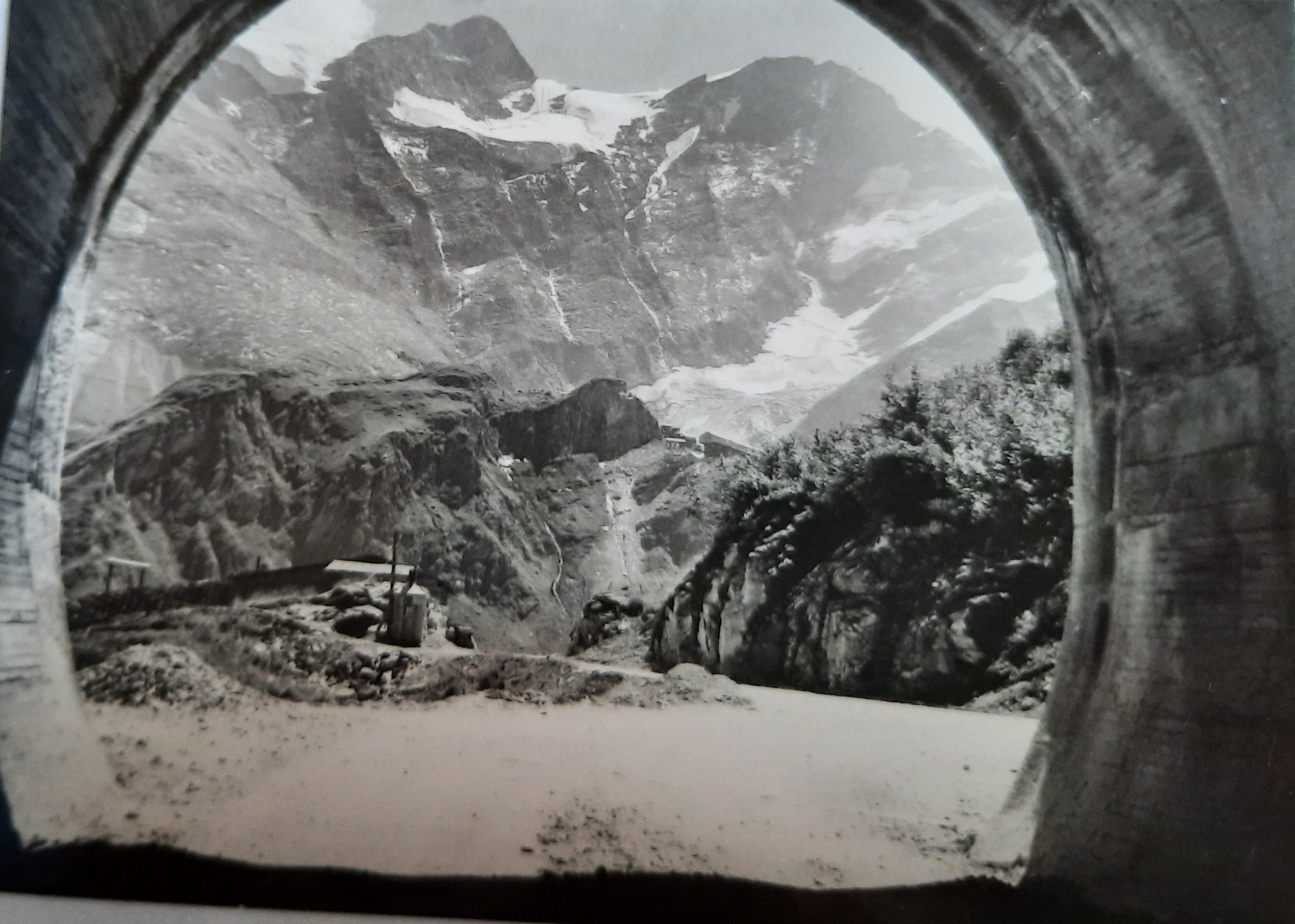
Despite this great support from the US, Kaprun was turned into THE great patriotic project of Austrian post-war recovery and it has persisted as the “Myth of Kaprun” ever since in the minds of Austrian people. After three years of construction on 22 September 1951 the “Limberg” dam wall was inaugurated in the presence of the Austrian President Theodor Körner and the Austrian government and the whole Austrian public celebrated this event. With the completion of the storage reservoir “Mooserboden” and the dam walls “Moosersperre” and “Drosselsperre” the construction of the storage power station Kaprun was officially finished on 12 August 1955.
Werner received this memento as recognition for his achievement in the building of the power plant at Christmas 1949 with a photo of the “Limbergsperre” under construction
Photos of the official celebrations which Werner took:
Official ceremony at the completion of the “Limbergsperre” with the Austrian President Theodor Körner (with the white beard)
The storage power plant Kaprun was completed in the same year as the “State Treaty”, which guaranteed the independence of the 2nd Austrian Republic, namely 1955. So Kaprun became THE symbol of Austrian reconstruction after the war, the victory of technology over nature and a common patriotic Austrian enterprise, whereby all the tragic aspects of the NS period were ignored and covered up. Austrian politicians like Karl Renner contributed to the creation of this myth as a common enterprise of a united and peaceful Austria. After the war many young workers and students came from Vienna and the vicinity to complete this impressive power station high up in the Alpine mountains, like Werner. Friendships were forged there that lasted a lifetime such as Werner with Willi Gaube, later vice-director of the Viennese museum of contemporary art “20er Haus”, Heinrich Knipfer and the Viennese engineer Robert, Werner’s best man. During the final construction years a form of “construction tourism” developed. Austrians from all over the country travelled by train and bus to Kaprun to observe the progress at the impressive construction site and many newspaper, radio and film reports spread news about the progress of the Kaprun project and about its “heroes”, the workers high up in the mountains.

Kaprun “tourism”: the visit of Werner’s fiancée Herta and below the visit of the famous mountain climber Luis Trenker
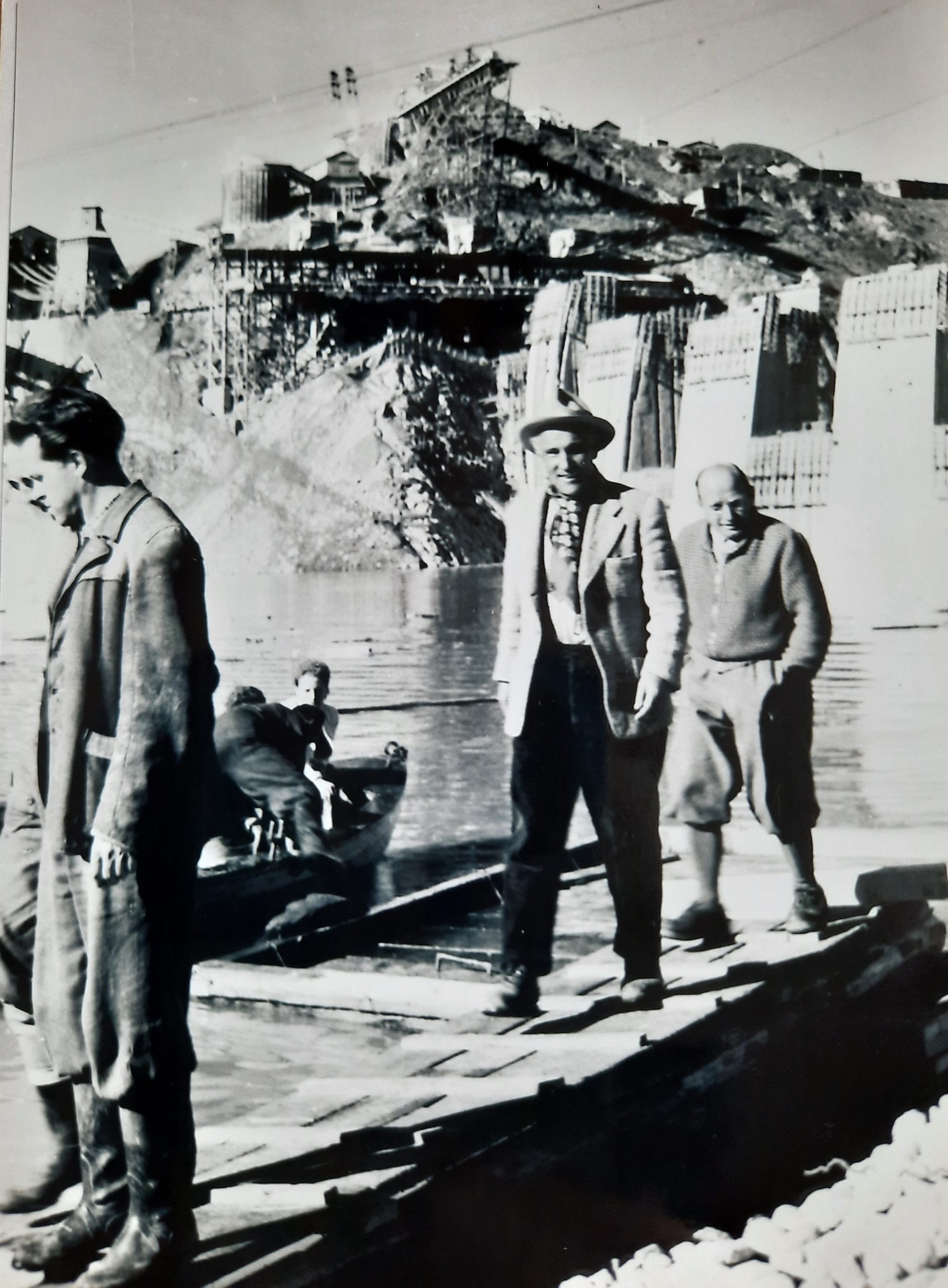
The subject “Kaprun” was used for advertising and several novels and films on the topic were published. All this of course disseminated an idealised picture of the construction of the Kaprun storage power station: First of all, it was a harsh world of men who fought against the forces of nature high up in the Alps and secondly, they were all comrades, the “men of Kaprun”, and no differentiation was made between unskilled worker and engineer. This new type of worker was proud of being part of such a thrilling project and of being able to contribute to it; they called themselves “Baraber” and they helped to forge a new Austrian patriotism which was modelled on the US New Deal dam projects of the 1930s and their myth. All these images, which were created soon after the end of the NS period and the Second World War, could not completely shed the NS terminology. Metaphors of war were used to enthral the population, such as “the mountains fight back, the mountains wound and kill… a fight, but not a senseless fight!” This attempt at incorporating Kaprun in a new Austrian patriotic scheme excluded any memory of the dark years of 1938 to 1945 and it did not mention that without foreign aid, especially from the US, this project would never have been completed.
Left: Werner (on the right) with his friends (the Viennese engineer Robert Walter on the left) and right: Werner with Herta
The reality of the working conditions at Kaprun had little in common with this idealised myth. The workers came from all walks of life: there were Austrian prisoner-of-war, soldiers who had returned from war, prisoners, former National Socialists who had no other chance of employment, Socialists and Communists who had returned from Nazi concentration camps, Jewish “Displaced Persons” who had been freed from those KZs and young men who were looking for a well-paid job away from home like Werner. When the Allied administration allowed so-called “minderbelastete” (less encumbered) NSDAP members to be employed again, many who had been interned in the US camp Glasenbach came to work in Kaprun – they were called the “Glasenbacher”. Furthermore Socialist and Communist organisations tried to get their members employed in Kaprun, too. In fact, there were several social and political conflicts in Kaprun after 1945; there were strikes, corruption, scandals and many fatal accidents due to insufficient security measures. The political climate at the construction site was characterised by a strong political polarisation: the Communists, supported by the Soviets, were able to gain many votes at the elections to the works council and on the other hand the former Nazis were still strong in Kaprun and when they were allowed to form a party, the VdU (Verband der Unabhängigen), by the Allied forces – a party of former Nazis and the forerunner of today’s FPÖ – they won the elections to the works council in 1949 and in 1951 the VdU even gained the position of chairman of the Kaprun works council. In fact in 1948 police reports stated that 80 per cent of the workers employed in Kaprun were former Nazis, but they were “no longer politically active”. Yet there were other reports, too, which told of Nazi machinations, especially among the engineers and some workers. In any case, Kaprun offered to many former Nazis the chance to get rehabilitated in the “new Austria”. So Kaprun can be seen as an example of how the 2nd Austrian Republic dealt with the NS past and the atrocities committed then, namely to ignore them and cover them up. Only in the 1990s former “Ostarbeiter” could turn to the construction companies, which had employed them during the NS period, and to the communities, where the construction had taken place, and demand documents which proved their employment, so that these years of forced labour could at least be incorporated in their life-time employment and included in their old-age pensions because the Soviets had refused to acknowledge those years in NS forced labour camps for their pensions as they viewed them as “collaborators” of the Nazis. In 1999 nine surviving Polish forced labourers and two Ukrainians asked the municipal administration of Kaprun for documentation.
The metaphor of the “White Gold” – “Water Power” characterised the economic “Miracle Years” in Austria after the war, showing that even a small country can overcome its deficiencies and experience an economic boom. From the early 1950s on the unemployment rate started to sink, net incomes gradually began to rise – and all this was possible because Austria according to the “Electricity Industry Plan” of 1948 was to become Europe’s most important exporter of electricity on the basis of the development of hydroelectric power and Kaprun was the most spectacular example of it.
The economic and social situation in Austria during the harsh winter of 1946/1947 was very serious; 60 per cent of food supply came from the United Nations UNRRA programme and the population was desperate and depressed. The food crisis directly led to a political crisis and the former National Socialists could make themselves heard again. They denounced the Austrian democratic government saying that the famine crisis was proof that a democratic government could not deliver. The crisis of the new and still weak democracy in Austria was blatantly visible; the scarce goods were not distributed fairly and the black market was rampant. The large amount of so-called “German property” in Austria could only be rescued by a huge nationalisation move. In 1946 the first Nationalisation Act was passed (which was followed by the Second Nationalisation Act in 1947) with the consent of all parties, left and right, because the Austrian government wanted on the one hand to prevent the Soviet Union from claiming all “German property” in Austria. On the other hand, there was no other possibility for investment into the key industries, which were crucial for the Austrian recovery, as there were no potent private investors. The three largest Austrian banks and 70 industrial enterprises were nationalised. In the early 1950s 22 per cent of the work force was employed in the nationalised sectors and they produced a quarter of all added value. The industrial enterprises were managed privately in a capitalist manner; only the overall framework for the coal, electricity and steel industry was set by the state. Consequently the nationalised industry, including the electricity industry, became the motor of reconstruction with the help of the Marshall Plan. This US aid programme triggered the turnaround economically, socially and politically. In fact in 1948 the mood of the Austrian population improved, they became more confident and the support of the strong American nation made them more courageous. So the process of stabilisation, economically and politically, was not a straight forward one and it could also have led in the opposite direction, not towards an open democratic and liberal capitalist system, as it fortunately did in the end. The Marshall Plan (ERP) definitely triggered the post-war economic take-off in Austria, but it also intensified the west-east gradient, which had started in the NS period. The western part of the Allied zones in Austria with 50 per cent of the population received 81 per cent of the ERP funds and on top of that the eastern part of Austria had to pay reparations to the Soviet Union. The amount of foreign aid to Austria from 1945 until 1955 was 1.6 billion US dollars; four times the aid received after World War I. 52 per cent of the ERP funds were invested into the nationalised industry, most of all into the electricity industry and there most into the Kaprun construction site. The value added in the industrial sector rose from 37 per cent in 1937 to 47 per cent in 1952.
Post-war workmen’s dwellings in Kaprun
In 1948 the majority of Austrians seemed to have done away with totalitarian regimes, but only just. A survey showed that they rejected Soviet Communism much more fervently (only around 3-6 per cent supported Communism) than National Socialism (30-43 per cent still supported National Socialism), but 50-63 per cent supported neither, which might have meant that they were for Western democracy. The problem was how to manage the transfer to democracy in a population which had been so deeply immersed in the totalitarian NS regime and how to deal with the former Nazis. In Austria there was no tradition of a grassroots revolution which would have swept away the Nazis and a legal process by which all NSDAP members would have to face trials would have taken 10-15 years and above all, where would the Austrian Republic have found non-Nazi judges? The whole judicial system was penetrated by the NS regime, and most of all the Austrian Nazis lacked any kind of culpability. The former Nazis were continuously complaining about how unfairly they were being treated, as could be seen in Kaprun. Until 1946 two processes of denazification were run parallel, one by the US army and one by the Austrian government. In this way 500,000 Austrian National Socialists were identified. Two thirds of them claimed that they were the exception to the rule and had never been “real Nazis”. By autumn 1946 50,000 persons had been arrested. Around 12,000 of them were imprisoned in the above-mentioned camp Glasenbach, where the conditions contributed to the impression among the prisoners that they were “unjustly treated” and this bound them together even more in their “old-boy network”. Under the influence of the Allied forces the process of denazification was a rather strict one only until 1947 and was rejected by the vast majority of the Austrian population. For a short period of time 7.5 per cent of employees were dismissed; 100,000 in the public sector and 70,000 in the private economy. But then the enthusiasm seemed to abate and with the Act of Amnesty for “minderbelastete” Nazis in 1948 the Conservative and Socialist political parties in Austria tried to woo the former Nazis shamelessly. A donation to one of the political parties quickly produced a petition for pardon. In 1949 the National Socialists even started to threaten the main political parties because they had regained their self-confidence and knew about the weight their votes had. A British member of the House of Lords mentioned in a speech there that denazification might create a hard core of Nazis in Austria, which might be striving for revenge and keep the Nazi potential alive; so they had to be integrated in the Austrian society. Under Allied supervision an openly Fascist party, as in Italy, was not founded in Austria, but despite the clear anti-Fascist position of the Austrian government, an undercurrent of secret appreciation of NS ideology among the Austrian population persisted, supported by traditionalist clubs and societies, such as the “Kameradschaftsbund” of war veterans, which blocked any honest and serious discussion of the problematic Austrian past.
When in July 1946 the US administration handed over the “German property” of Kaprun to the Austrian government on the basis of trusteeship, workers were hired to continue with the construction of the storage power plant. Kaprun was categorised as “region class III”, which meant that the wages were the lowest – Vienna was categorised “region class I” because life was much more expensive in Vienna. The many Viennese workers in Kaprun therefore could not afford to purchase goods, such as food, clothing and cigarettes, which were only available with rationed coupons. They could not even go to the cinema, as the newspaper “Salzburger Nachrichten” reported on 3 August 1946. That’s why the trade unions demanded a pay rise from the AEW management stressing that the workers in Kaprun were especially disadvantaged because they were exposed to harsh weather conditions and challenging working conditions and most of all they were facing unemployment in winter. Apart from the stress of working at 1,600 to 2,000m altitude, the Viennese workers were separated from their families and any type of civilisation for long periods and that’s why it was difficult for the AEW to hire workers, the trade unions stressed. As a consequence the central wages and salaries commission in Vienna decided that from 1 June 1946 on Kaprun was classified as “region class I” and that the workers’ efficiency bonus was doubled to 20 per cent for half of the staff of Kaprun. All other enterprises had to forgo any efficiency bonus. This resulted in the following wages structure of the Kaprun workers: unskilled workers earned 1.01 AS (Austrian Schilling), miners 1.23 AS, skilled workers 1.29 AS. A bonus of 0.10-0.30 AS per hour was paid for work between 1,200 and 2,000m altitude and for dangerous work in mines or on high masts a bonus of 10 to 15 per cent was added. The percentage for overtime work and work on Sundays and public holidays was 50 per cent and for nightshifts 100 per cent. Married workers received a so-called “separation bonus” of 1.50 AS per day and single workers 1.00 AS. A married skilled worker therefore received around 430 AS a month without any bonuses and with bonuses he easily took home the amount of an engineer’s salary of around 570 AS. Furthermore in August 1946 the AEW agreed to a pay rise of 45 per cent to compensate the quickly rising prices and it decided to guarantee the provision of weather-resistant workmen’s dwellings high up in the mountains with straw sacks and blankets, warm showers and medical treatment twice a week and dental treatment thrice a week. In the valley a works hospital with 50 beds was run including a surgical department. Once a week workers were to be transported to the cinema in the valley. But the food supply was still insufficient despite the fact that the workers received special coupons for “heavy work”, which resulted in 1,800-2,300 calories. Additionally the workers received an extra ration of cigarettes for “raising their spirits”. The trade union representatives managed to negotiate further improvements of the working conditions in Kaprun, for example extra rations of 400g butter and 1kg polenta per month and the payment of the daily commute to and from the construction sites to the dwellings. From the camp Zeferet to the mines, where the cables were supposed to run, the workers had to hike under difficult conditions, especially in the dark and in bad weather, often carrying heavy tools. The negotiators had demanded two paid hours per day for the commute, but in the end the workers only received three paid hour per week for the commute. As compensation they were granted a special “travel benefit” for those who went home over the weekend. In the summer of 1946 the number of workers rose from 400 to 700 due to higher pay and better working conditions, but that was still only half of the labour force necessary. The passing of the “Duty to Work Act”, which ordered the employment of jobless former Nazis and gang youth, called “Schlurfs”, could not ameliorate the situation. So, all types of people found employment in Kaprun until 1947 because the construction companies never checked the background of the applicants. Many Nazis hid on the construction sites in Kaprun who were afraid to go home and also some criminals were discovered there later.
Werner at work in Kaprun
The difficult living conditions after the war forced the coalition government of Conservatives and Social democrats (ÖVP and SPÖ) to continuous compromises starting with the Frist and Second Nationalisation Act. Politically and economically Austria could not afford political controversy and strikes, so employers and employees negotiated a wages and prices agreement because in 1947 the food prices had increased 100 per cent and also the prices for transport and energy had risen drastically while the wages had only increased 50 per cent. The agreement stated that the wages would be raised by 39 per cent on average and the prices for all goods a worker’s household needed were fixed. In this way inflation was somehow contained. Meanwhile progress at the construction site Kaprun could be speeded up. In 1947 the number of workers increased from 700 to 2,400. Consequently Kaprun became Austria’s biggest construction site. By 1950 Austria had overcome the greatest economic difficulties with US economic assistance, but the rising prices were still a hot issue among the workers. By the time the lock “Limbergsperre” was nearly completed and the construction of the reservoir “Mooserboden” was not yet guaranteed, the Kaprun management demanded from the government in Vienna an investment of 20 million AS, otherwise 1,500 workers would have to be dismissed and the reservoir would not be built with drastic consequences for the Austrian economy. The government agreed to the financing of the continuation of the construction of the reservoir “Mooserboden” and promised to send 600 more workers from Vienna to Kaprun. The Socialist newspaper “Arbeiterzeitung” reported that many Viennese construction workers were already in Kaprun and “they were impressed by the cleanliness and comfort of the accommodation there”.
On 3 October 1950 the Austrian Communist party called a general strike against the government’s latest wages and prices agreement, starting in the Soviet-controlled eastern part of Austria. But the majority of Austrian workers soon realised that this was not just about wages and price rises, but about a Soviet-supported coup and so the workers organised resistance, especially the construction workers’ trade union led by Franz Olah fought back and when the Austrian government begged the Soviets to end their support for the Communist strikers, the Communist uprising collapsed on 5 October. On 3 October votes were held about the strike at all construction sites in Kaprun, but only very few voted for a strike. Although the majority of the workers had rejected the strike, a small minority formed a strike committee, which called works assemblies at some construction sites, where the issue was hotly discussed and flyers of the Communist party headquarter in Vienna were distributed. Although the workers decided not to go on strike the next day, the management decided to protect the power plant on 5 October to prevent any acts of sabotage. As the strike committee in Kaprun was illegal because the majority of trade union members had rejected a strike, also no strike pay was paid and the whole industrial action collapsed on 5 October at 18.00. Work was resumed on 6 October 1950 as usual in Kaprun. Five years after the decision of the Austrian government and the management of the “Tauernkraft AG” to complete the upper stage of the storage power station Gockner-Kaprun on 12 August 1955 the works were finished in a ceremony for the workers with the “last bucket of concrete” for the dam “Moosersperre”.
Werner’s works ID when working at the dam “Mooserboden”, the upper stage of the power station Glockner-Kaprun, April 1955
Werner’s works ID when he was working on the winter reservoir “Reißeck” as an electrician in 1955
Werner Tautz had started to work at the construction site of the storage power station Kaprun in January 1949 and was employed there until the end of 1955 when he returned to Vienna. In his memoirs he described what had led him to look for work in Salzburg.
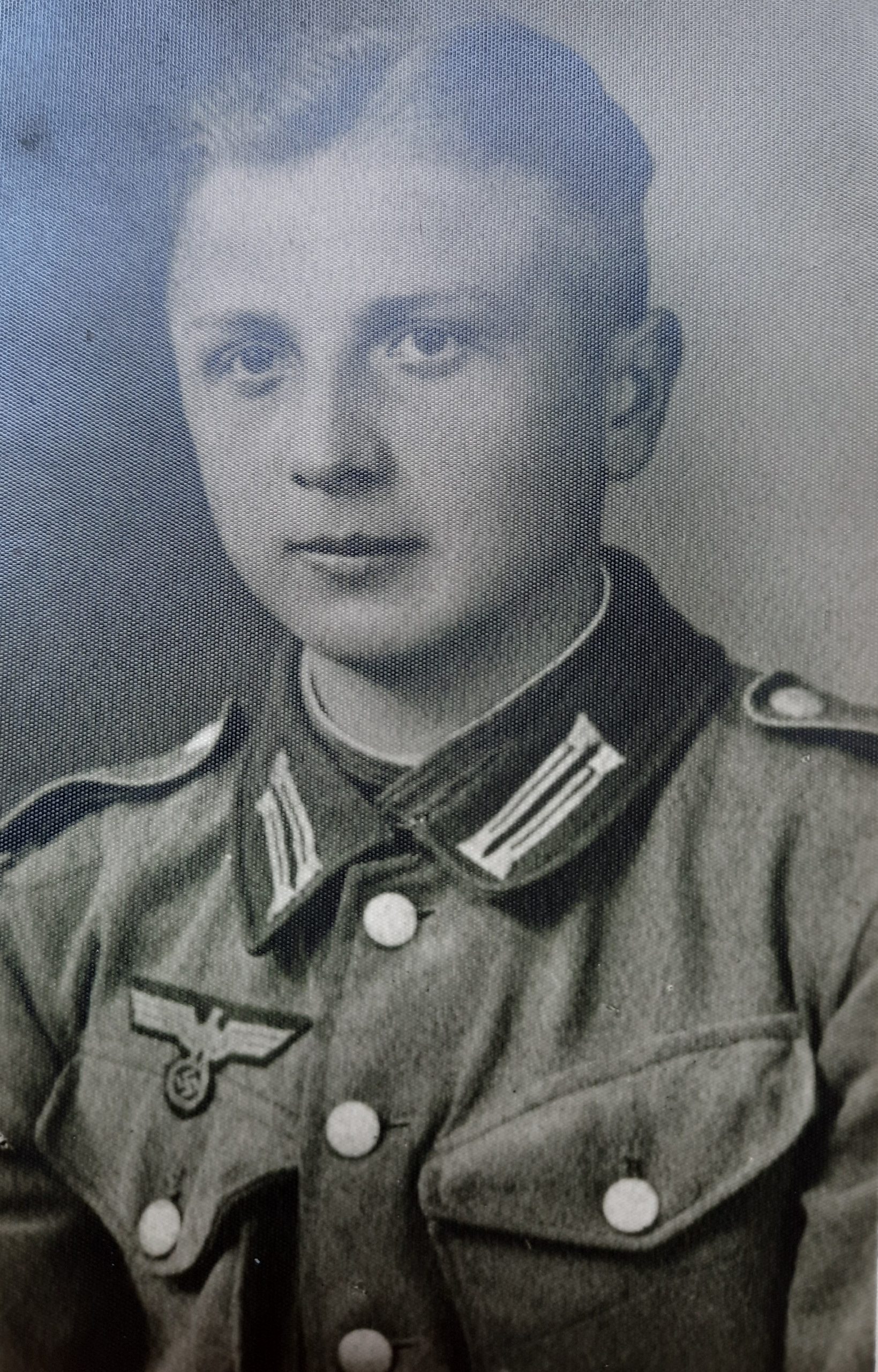
Werner was one of the “Wehrmacht’s baby soldiers”
Werner was seventeen – but looking like a boy which helped during the flight -, when he decided to desert from the “Wehrmacht” in Freilassing, Bavaria, at the end of the war in spring 1945 (see article about “The Nazi Children Evacuation Programme”). On 10 May he tried to leave Bavaria. For three days he was imprisoned in a US Army camp, but managed to escape on foot to Burghausen. There he was hiding out for three weeks until he managed to procure a provisional ID and a permit to pass the border to Austria, which was difficult because he had no papers as he had thrown away all NS documents when he fled from the “Wehrmacht”. From the border he walked to Linz, where he was about to get work at the steel works VOEST, when he was again interned in a camp for civilians, in which Polish slave labourers had been imprisoned before by the Nazis. Werner wrote that the conditions there were so bad- “bugs everywhere” – that he caught dysentery and spent the next four weeks in the sick ward. When he was fit enough, he fled together with a Viennese guy to the bridge over the river Enns. “How we managed to cross the bridge was pure luck. Maybe the Russian soldier was overwhelmed by the provisional papers with the many stamps. Then we marched to the train station in St.Valentin, but there a Russian patrol caught us and escorted us to the Russian “Kommandatura”. On the way they encountered a young girl who told the soldiers that she was infected and on the way to the hospital in Amstetten. We made use of the confusion and fled back to the train station. There we hid until night broke and waited for a train to Vienna….. In St.Pölten the Russians dragged some women out of the train who were shouting terribly. At 9.00 in the morning I arrived in Wien-Hütteldorf and walked across the city. At 12.00 I arrived at the „Reichsbrücke“ (one of the few bridges across the Danube that was still intact) and walked on across Kagran to Obersiebenbrunn (where Werner’s foster parents lived). There were crosses in the ditches and tanks in the fields. Whenever I saw a cloud of dust in the distance I hid in a furrow in order not to be caught again at the last moment. On 8 August 1945 at 16.00 I was finally home.” Immediately the next day Werner had to work for the Soviets who were quartered in Obersiebenbrunn. He repaired electrical cables and installed electricity and lighting. In exchange he got lunch (a soup made of kraut) and a huge packet of pudding powder for 120 men and a packet of roast onions with worms inside from the Nazi stocks. Whenever he came home to his foster mother, Anna Rupp, he had to undress completely and she checked him and his clothes for bugs.
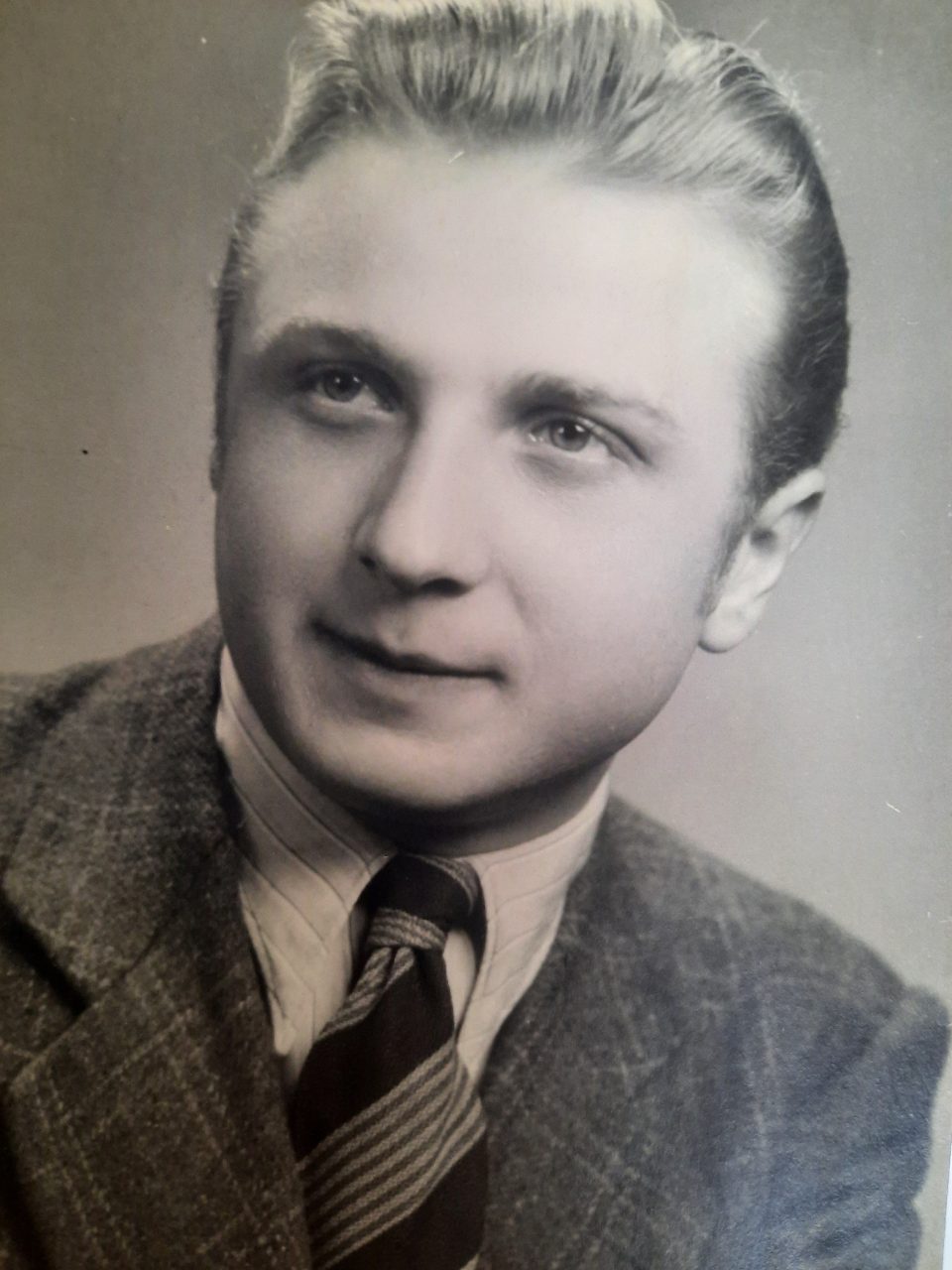
“Now the fun started”, Werner stated, “Dancing and chasing the female sex. The older women taught us to dance, but in the other matter you had to be very careful because due to the war there was a scarcity of men and it could happen that you got married on the spot. It was better to stay with older women. It was a beautiful time of which I keep fond memories. We had no problems with the Russians.” Werner told that on the night from the 5th to the 6th December 1945 he got dressed up with his friend Ernstl as “Krampus & Nikolo” (an Austrian traditional custom) and went from house to house to “visit” children and the girls. In one of the houses a Russian officer was quartered who did not know about this Austrian custom and ordered them to take off their disguises. Then they had to drink vodka with him and he was very amused because they were soon completely drunk. “We nearly did not find our way home”, Werner remembered. Werner did not like schnapps after these experiences because also the Soviet officer who was billeted at his home ordered Werner to drink vodka with him and eat bread with onions. His foster mother usually gave Werner the oil of fish conserves before the binge drinking with the Russians started, so that he could “survive” it. Later Werner rather followed the example of his foster father Franz Rupp, who was sure that wine drinking guaranteed a long life (well, both died at 88).
Werner’s certificates after completion of his training as industrial electrician in the sugar refinery “Leipnik-Lundenburger Zuckerfabrk Leopoldsdorf” in August 1946
In 1947 Werner decided to quit his job as electrician at the sugar refinery in Leopoldsdorf and move west. With a railroad construction firm he went to Bruck-Fusch near Zell am See in Salzburg. There he fell in love with the “Pinzgau” region and stayed there until 1955.
Werner skiing
Werner in a new outfit in Zell am See
In 1948 he moved to Maishofen and worked for the company “Weißbacher” as an electrician and salesman for fruit and vegetables. “One time I was installing lighting, the other time I was selling fruit. I went to Eferding in Upper Austria for purchasing fruit und usually the boss’s wife went with me. She was 28 and my boss Peter was 45 and impotent from binge drinking. So this was a chance for me (Werner was 20).” For deliveries to hotels the company had a three-wheel vehicle which usually Peter, Werner’s boss, drove, but after the last delivery he was mostly too drunk, so Werner had to drive home. It happened several times that they upset the little van and they landed on the side with 120 kg-Peter on top of Werner. At home in the garage they realised the next day that the door handles were gone. The young Ms Weißbacher organised for Werner to be hired at the construction site of Kaprun, when the company “Weißbacher Elektro-und Landesproduktenhandlung” was about to go bankrupt.
The young workers enjoyed hiking and climbing in their spare time
Werner with the white cap
Werner started in Kaprun as an unskilled worker at the construction site “Wasserfallboden” in January 1949. Werner was not used to the heavy work in the mines and could not bear the stench of diesel. The company’s doctor had him transferred to the unskilled workers’ unit which had to deliver wood, oxygen and gas tanks to the constructors of the cable cars. Werner watched a welder at work and saw that he was not very skilled. He asked him whether he could try welding and the foreman saw Werner and hired him on the spot. It was extremely difficult to get skilled workers in those years. Werner then worked for three years in the cable car construction in Kaprun. He said that it was hard work, always outdoors, 12 hours a day and more if there was a breakdown and all the commutes on foot, summer and winter, up and down the mountains. They had a saying, “Three quarters of the year winter, one quarter cold and summer on a Thursday.”
Werner working at a cable car
In 1952 Werner had the chance to finally work in his trained profession as an industrial electrician. He was soon promoted to the position of foreman because most of the other electricians had no experience with industrial electrical equipment; they had been trained as “household electricians”.
Werner on the right in both photos
Werner on the left in both photos
Werner reported that during his time on the cable car construction site he learned a lot for his later life and it was a very productive period of time for him. In the summer of 1949 he was responsible for the pillar 6 and normally he just had to grease the pulleys every two hours, nothing much more. He was 12 hours on duty and alternating two weeks of day shift and two weeks of night shift. So he had much time to read, “I’ve never read that much in my life again!” Werner had started a distance learning course for electrical engineering, but when he was promoted to the position of industrial electrician, he did not have enough time to complete it. He did that back in Vienna from 1956 to 1958 at the “Technologisches Gewebemuseum”. Werner’s friends Rolf and Joseph had both completed their A-levels and he loved talking to them because he acquired lots of general knowledge in this way. Werner always suffered that he had only been allowed to go to primary school and had never enjoyed any proper schooling in his youth (see article “Nazi Children Evacuation Programme”).
Finally in 1952 he was entitled to a two-bedroom accommodation, which he shared with his colleague Heinrich Knipfer. They were bound by a life-long friendship and to Werner’s delight lots of students who were working in Kaprun came to visit them in the evening and they had long and very interesting discussions. Furthermore they listened to music a lot because Werner was in the possession of a luxury, a radio. Werner said that he profited a lot from the friendship with all those students from Vienna and its surroundings. Robert und Willi, both students, often joined them and all those friendships continued in Vienna after the completion of the construction of Kaprun. Robert was Werner’s best man at his wedding in 1953. This inexhaustible thirst for knowledge accompanied Werner all his life. During the weeks when he was on night shift Werner discovered another passion, photography, and this hobby filled his leisure time in Kaprun. Thanks to his enthusiasm, so many photos of the construction site and the nature around Kaprun from 1949 to 1955 have been preserved. Werner became a professional photographer and earned many honours for his photos and slide shows later in life.
Werner with friends (in the left photo Werner can be seen on the right with the black sheep and in the right photo on the left)
Werner stressed that 1952/53 had been a decisive period for him. In the summer of 1952 he had undertaken a climbing tour with a friend to the “Großes Wiesbachhorn” (3,564m) with climbing irons and when descending they both fell and their rescue from certain death was a stone which caught their climbing rope and prevented them from falling into an ice crevice at about 3,000m altitude. His friend broke his leg, but Werner got away with some abrasions on his right arm.
Werner after the fall from the “Großes Wiesbachhorn” with the bandaged right hand
In the summer of 1952 Werner went on a one-week trip to Italy together with the student Charlie, “Rome, Napoli, Capri and Charlie had a nice girl with him, who was not his girlfriend”. On his return home Werner decided that his “wild years” had to be over now. He had been working for four years in Kaprun, had earned well, but had to borrow the money for his trip back to Kaprun in Vienna. He was true to his word and by Christmas he had saved 5,000 AS. “I had never had so much money in my life.” He celebrated New Year’s Eve 1952/53 in Vienna and at the “Kursalon Hübner” he got to know my mother, Herta. He thought, “This might be the girl for life”. After a first mishap because they had confused the location of their first meeting, they fell in love. They wrote lots of letters and Werner came to Vienna whenever possible. In the summer of 1953 Herta visited him in Kaprun together with her parents. Soon they got engaged and in December 1953 they married. At first it was a long-distance marriage because Werner remained in Kaprun until the end of the construction works in 1955. But they saved up for a small flat in Vienna and in 1954 they managed to pay the deposit and moved in in 1956.
Herta in Kaprun
Herta and Werner in Kaprun in the summer of 1953
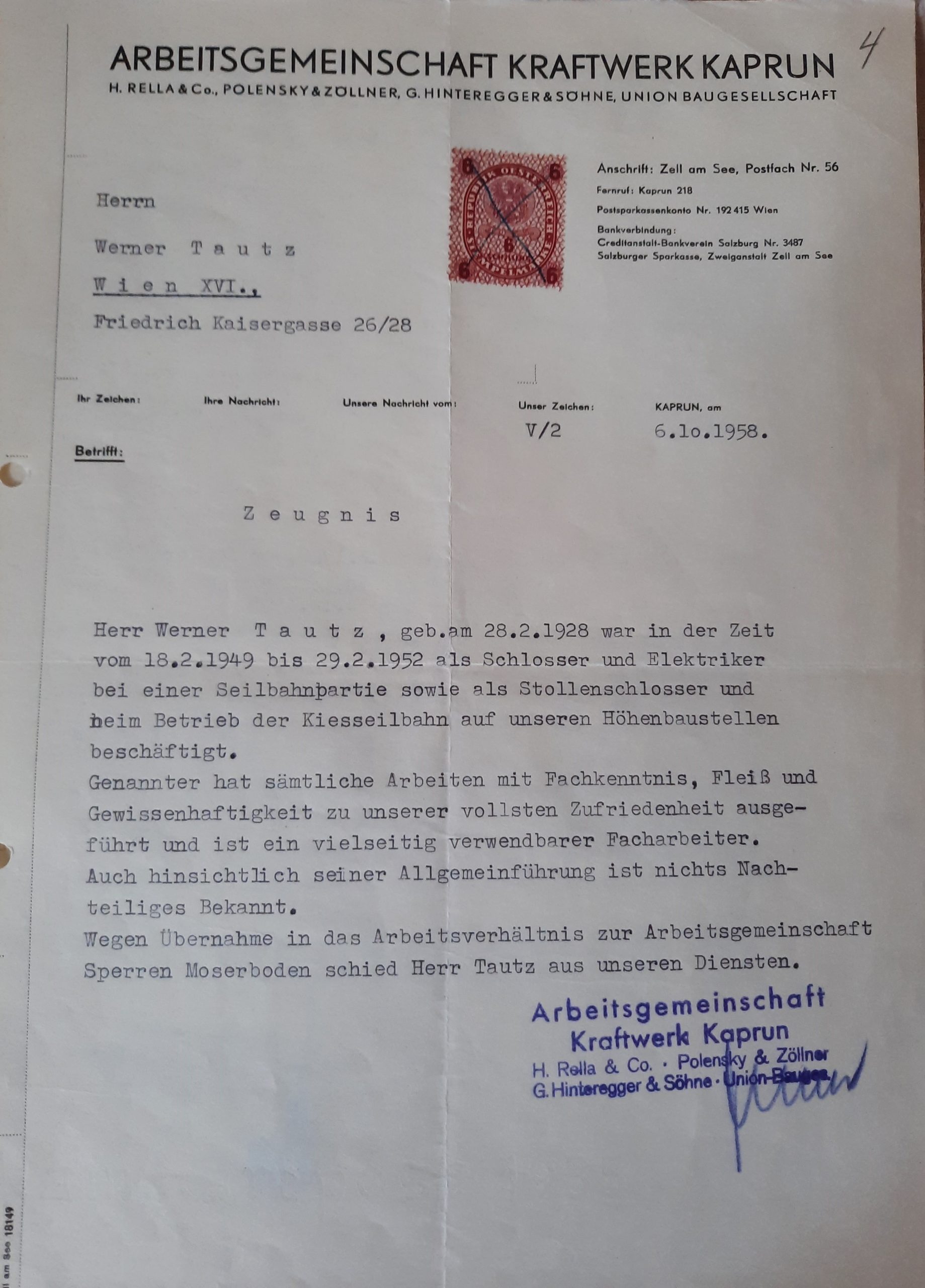
Werner’s certificate of employment at the cable car in Kaprun 1949-1952
Werner’s certificate of employment as electrician at “Mooserboden” 1952-1955
Werner with his work mates
Farewell to Kaprun
Literature:
50 Jahre Tauernkraft, Salzburg 1997
Hanisch, Ernst, Der lange Schatten des Staates. Österreichische Gesellschaftsgeschichte im 20.Jahrhundert, Ueberrreuter Wien 1994
Hutter, Clemens, Kaprun. Geschichte eines Erfolges, Residenz Verlag Salzburg & Wien 1994
Rathkolb, Oliver & Freund, Florian (Hg.), NS-Zwangsarbeit in der Elektrizitätswirtschaft der „Ostmark“, 1939-1945, Böhlau 2014

